Chiari-like Malformation (CM) and Syringomyelia (SM) in the
Cavalier King Charles Spaniel
Page 2 – Research News
-
 Syringomyelia
Main Page
Syringomyelia
Main Page - Research News
- -- 2024
- -- 2023
- -- 2022
- -- 2021
- -- 2020
- -- 2019
- -- 2018
- -- 2017
- -- 2016
- -- 2015
- -- 2014
- -- 2013
- -- 2012
- -- 2011
- -- 2010
- -- 2009
- -- 2008
- -- 2007
- -- 2006
- -- 2005
- -- 2004
- Veterinary Resources -- Page 3
Research News
2024 News
March 2024:
UK researchers develop an online tool that predicts the
likelihood of painful Chiari-like malformation in dogs.
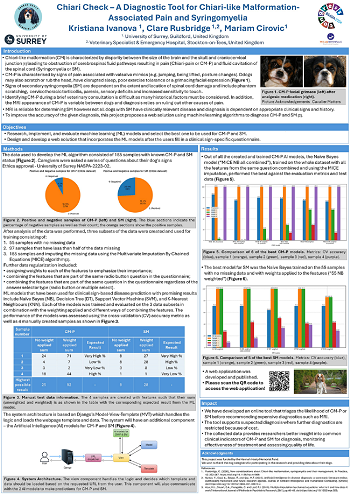 At the March 2024 BSAVA 2024 conference, UK researchers Kristiana
Ivanova, Clare Rusbridge, and Mariam Cirovic presented a poster (at
right -- click to enlarge it) announcing the creation of a machine
learning tool available online that can predict the likelihood of
painful Chiari-like malformation (CM-P) in cavaliers and other breeds.
"Machine learning" (ML) is an artificial intelligence device using
statistical algorithms and models to analyze and draw inferences from
patterns of information. In this project, data from 185 dogs diagnosed
with CM-P and syringomyelia (SM) together with the dogs' owners answers
to a series of questions about their dogs' symptoms and behaviors. The
model program called Naive Bayes model ("MICE NB all combined")
performed best against the evaluation metrics and test data, for both
predicting CM-P and SM. The ML tool is available free of cost online at
chiari-check.surrey.ac.uk
At the March 2024 BSAVA 2024 conference, UK researchers Kristiana
Ivanova, Clare Rusbridge, and Mariam Cirovic presented a poster (at
right -- click to enlarge it) announcing the creation of a machine
learning tool available online that can predict the likelihood of
painful Chiari-like malformation (CM-P) in cavaliers and other breeds.
"Machine learning" (ML) is an artificial intelligence device using
statistical algorithms and models to analyze and draw inferences from
patterns of information. In this project, data from 185 dogs diagnosed
with CM-P and syringomyelia (SM) together with the dogs' owners answers
to a series of questions about their dogs' symptoms and behaviors. The
model program called Naive Bayes model ("MICE NB all combined")
performed best against the evaluation metrics and test data, for both
predicting CM-P and SM. The ML tool is available free of cost online at
chiari-check.surrey.ac.uk
The researchers concluded that their tool supports suspected diagnosis when further diagnostics, such as MRI scans, are restricted due to their costs. They stated that:
"The collected data provides researchers better insight into common clinical indicators of CM-P and SM for diagnosis, monitoring effectivenes of treatment, and assessing quality of life."
February 2024:
Danish study of 55 cavaliers finds no association between mitral
valve disease and syringomyelia in the breed.
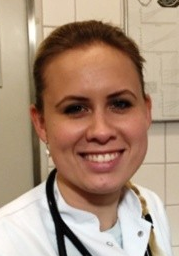 In
a
February 2024 article, Danish researchers (Maiken B. T. Bach
[right], Camilla L. Stougaard, Maria S. Thøfner, Maria J. Reimann,
Ulrik Westrup, Jørgen Koch, Merete Fredholm, Torben Martinussen, Mette
Berendt, Lisbeth H. Olsen) compared the mitral valve measurements of the
left atrium and left ventricle and murmur grade of 55 cavalier King
Charles spaniels which also had been MRI scanned and diagnosed with or
without syringmyelia (SM). Of the 55 CKCSs, 22 had symptomatic SM, 18
had asymptomatic SM, and 15 had no SM. Of the 55 cavaliers, 13 had no
MVD signs, 32 were diagnosed with MVD Stage B1, 7 with Stage B2, and 3
with Stage C. In Denmark, MVD breeding restrictions issued by the Danish
Kennel Club, assessing mitral regurgitation murmurs and mitral valve
prolapse severities have proven to effectively reduce the prevalence of
early-onset MVD in CKCS, excluding only approximately 5% from breeding.
Therefore, one of the investigators' motivations was a concern that
those Danish breeding restrictions could potentially influence the
prevalence of SM. The secondary aim of the study was to investigate the
severity of MVD in SM-affected cavaliers with and without clinical signs
of SM.
In
a
February 2024 article, Danish researchers (Maiken B. T. Bach
[right], Camilla L. Stougaard, Maria S. Thøfner, Maria J. Reimann,
Ulrik Westrup, Jørgen Koch, Merete Fredholm, Torben Martinussen, Mette
Berendt, Lisbeth H. Olsen) compared the mitral valve measurements of the
left atrium and left ventricle and murmur grade of 55 cavalier King
Charles spaniels which also had been MRI scanned and diagnosed with or
without syringmyelia (SM). Of the 55 CKCSs, 22 had symptomatic SM, 18
had asymptomatic SM, and 15 had no SM. Of the 55 cavaliers, 13 had no
MVD signs, 32 were diagnosed with MVD Stage B1, 7 with Stage B2, and 3
with Stage C. In Denmark, MVD breeding restrictions issued by the Danish
Kennel Club, assessing mitral regurgitation murmurs and mitral valve
prolapse severities have proven to effectively reduce the prevalence of
early-onset MVD in CKCS, excluding only approximately 5% from breeding.
Therefore, one of the investigators' motivations was a concern that
those Danish breeding restrictions could potentially influence the
prevalence of SM. The secondary aim of the study was to investigate the
severity of MVD in SM-affected cavaliers with and without clinical signs
of SM.
The investigators report finding no significant difference in left atrial (LA) and left ventricle (LV) measurements between CKCSs with or without SM. However, they did find that CKCS with symptomatic SM had "significantly smaller" LA and LV dimensions, compared to those with asymptomatic SM and those without SM.
February 2024:
Certain symptoms displayed by cavaliers can indicate the
severity of their syringomyelia and sizes of their syrinxes.
 In a
February 2024 article, Danish researchers (Tenna Remler Pedersen
[right],
Maiken Bayer Thode Bach, Camilla Løkke Stougaard, Hanne Gredal, Nanna
Brix Finnerup, Mette Berendt) and Clare Rusbridge of the UK investigated
the symptoms of 89 cavalier King Charles spaniels which had been
diagnosed with syringomyelia (SM) by MRI at the University of
Copenhagen, Denmark, by interviewing the dogs' owners, to determine the
relationship between the sizes of the dogs' syrinxes and their
SM-related symptoms. The severity of the dogs' Chiari-like malformation
(CM) and SM were cagtegorized by the British Veterinary
Association/Kennel Club scheme of measuring the condition of the CM and
sizes of the syrinxes. The dogs were distributed into three groups: (1)
dogs with CM and no SM (or with a maximum transverse width < 2 mm), (2)
dogs with CM and small syrinx (SM 2.00-3.99 mm) and (3) dogs with CM and
large syrinx (SM ≥4 mm). They report finding that these clinical signs
were reported significantly more frequently in dogs with large syrinxes:
In a
February 2024 article, Danish researchers (Tenna Remler Pedersen
[right],
Maiken Bayer Thode Bach, Camilla Løkke Stougaard, Hanne Gredal, Nanna
Brix Finnerup, Mette Berendt) and Clare Rusbridge of the UK investigated
the symptoms of 89 cavalier King Charles spaniels which had been
diagnosed with syringomyelia (SM) by MRI at the University of
Copenhagen, Denmark, by interviewing the dogs' owners, to determine the
relationship between the sizes of the dogs' syrinxes and their
SM-related symptoms. The severity of the dogs' Chiari-like malformation
(CM) and SM were cagtegorized by the British Veterinary
Association/Kennel Club scheme of measuring the condition of the CM and
sizes of the syrinxes. The dogs were distributed into three groups: (1)
dogs with CM and no SM (or with a maximum transverse width < 2 mm), (2)
dogs with CM and small syrinx (SM 2.00-3.99 mm) and (3) dogs with CM and
large syrinx (SM ≥4 mm). They report finding that these clinical signs
were reported significantly more frequently in dogs with large syrinxes:
• Phantom scratching
• Scratching of both sides of the neck and shoulders
• Aversion to being touched to the head, neck, or shoulders
• Worsening of clinical signe when the dog was emotionally aroused
• Preferred head posture during sleep
They found that when phantom scratching, aversion to touch, and a preferred head posture while asleep were combined, the likelihood of a large syrinx increased. They concluded that clinicians may use this information to diagnose CKCSs with a large syrinx and necessary treatment when MRI diagnosis is not available or affordable.
January 2024:
MRI testing and selection of cavalier breeding stock reduced
syringomyelia (SM) in Dutch and Danish offspring.
 In a
January 2024 article, a team of Netherlands researchers (Citlalli
Limpens [right], Vivian T. Smits, Hille Fieten, Paul Mandigers) examined 2,125
cavalier King Charles spaniels in the Netherlands and Denmark to
evaluate the effect of MRI-based selection of breeding stock on the
prevalance of syringomyelia (SM) in CKCS offspring. Breeders started screening their CKCS with
MRI in the Netherlands since 2004, and in 2011 the SM screening became
mandatory. In Denmark, voluntary MRi screening began in 2015, with
mandatory testing beginning this year. The goal of
the study was to evaluate the effect of MRI-based selection in breeding
on the prevalence of SM.
In a
January 2024 article, a team of Netherlands researchers (Citlalli
Limpens [right], Vivian T. Smits, Hille Fieten, Paul Mandigers) examined 2,125
cavalier King Charles spaniels in the Netherlands and Denmark to
evaluate the effect of MRI-based selection of breeding stock on the
prevalance of syringomyelia (SM) in CKCS offspring. Breeders started screening their CKCS with
MRI in the Netherlands since 2004, and in 2011 the SM screening became
mandatory. In Denmark, voluntary MRi screening began in 2015, with
mandatory testing beginning this year. The goal of
the study was to evaluate the effect of MRI-based selection in breeding
on the prevalence of SM.
The researchers report finding that the prevalence of SM in the offspring of screened breeding stock decreased from 38.3% during the years 2010 through 2014 to 27% during 2015 through 2019. They found that breeding with both SM-affected parents significantly increased the risk of producing SM-affected offspring, compared to breeding with both unaffected parents. However, they concluded that "MRI-based screening and selection against SM led to a minimal decrease in prevalence of SM in the Dutch and Danish CKCS population." They make four recommendations:
1: Refine the current BVA/KC scheme in such a manner that a CKCS with a visible FFC (fluid filled cavity) of ≥0.5 mm, regardless of its age, is observed as affected.
2: Not to breed with such a dog.
3: Use only sires that are found to be unaffected after reaching the age of 3 years or older.
4: If possible, to apply the same to the bitches as well, only using them after reaching the age of 3 years and found to be unaffected at that time.
 January 2024:
Dr. Rusbridge publishes the 2024 version of the CM/SM Treatment
Algorithm. On January 9, 2024, Dr. Clare Rusbridge
published an updated version of her CM/SM Treatment Algorithm. It is in
pdf format and
downloadable here. It includes links to several recently posted
YouTube videos in which Dr. Rusbridge discusses various aspects of CM
and SM, including casuses, symptoms, diagnoses, and treatments. She
introduces the 2024 treatment algorithm in
this YouTube video published January 10, 2024.
January 2024:
Dr. Rusbridge publishes the 2024 version of the CM/SM Treatment
Algorithm. On January 9, 2024, Dr. Clare Rusbridge
published an updated version of her CM/SM Treatment Algorithm. It is in
pdf format and
downloadable here. It includes links to several recently posted
YouTube videos in which Dr. Rusbridge discusses various aspects of CM
and SM, including casuses, symptoms, diagnoses, and treatments. She
introduces the 2024 treatment algorithm in
this YouTube video published January 10, 2024.
RETURN TO TOP
2023 News
July 2023:
Study of 41 CM/SM-affected cavaliers finds reduced volume of
cerebral gray matter in CKCSs with chronic pain.
 In
a
July 2023 article, German veterinary neurologists (Björn Nitzsche
[right], Sabine Schulze, Johannes Boltze, Martin J. Schmidt)
examined the magnetic resonance imaging (MRI) data of 41 cavalier King
Charles spaniels to determine if the gray matter (GM) of the congulate
gyrus (CG) of the cerebellum decreased in volume when the dogs also
exhibited chronic pain due to SM. They described the research as a pilot
study, but they concluded that GM atrophy in the CG is associated with
chronic pain and may serve as an objective readout parameter for the
diagnosis or treatment of canine pain syndromes.
In
a
July 2023 article, German veterinary neurologists (Björn Nitzsche
[right], Sabine Schulze, Johannes Boltze, Martin J. Schmidt)
examined the magnetic resonance imaging (MRI) data of 41 cavalier King
Charles spaniels to determine if the gray matter (GM) of the congulate
gyrus (CG) of the cerebellum decreased in volume when the dogs also
exhibited chronic pain due to SM. They described the research as a pilot
study, but they concluded that GM atrophy in the CG is associated with
chronic pain and may serve as an objective readout parameter for the
diagnosis or treatment of canine pain syndromes.
May 2023:
Cavaliers' Brainstem Auditory Evoked Response (BAER) testing
identified grades of Chiari-like malformation.
 In a
May 2023 article, Ohio State University specialists (Lynette K. Cole
[right], Susan O. Wagner, Sarah A. Moore, Ronaldo DaCosta, Eric
T. Hostnik, Laura E. Selmic) report their study of 20 cavalier King
Charles spaniels to determine the breed-specific brainstem
auditory-evoked response (BAER) testing parameters for assessing the
grade of Chiari-like malformation (CM) which each dog had. Their purpose
was to establish breed-specific BAER data and to determine if BAER
indexes differed based on the CM grade. They assessed the cavaliers
using BAER, and CT scans (to assess the middle ear), and MRI scans (to
assess presence and grade of CM). They report finding that of the 20
CKCSs, all had CM, with 9 (45%) having the milder form of CM1 and 11
(55%) having the more severe form of CM2. They also made these important
findings regarding future BAER testing of cavaliers:
In a
May 2023 article, Ohio State University specialists (Lynette K. Cole
[right], Susan O. Wagner, Sarah A. Moore, Ronaldo DaCosta, Eric
T. Hostnik, Laura E. Selmic) report their study of 20 cavalier King
Charles spaniels to determine the breed-specific brainstem
auditory-evoked response (BAER) testing parameters for assessing the
grade of Chiari-like malformation (CM) which each dog had. Their purpose
was to establish breed-specific BAER data and to determine if BAER
indexes differed based on the CM grade. They assessed the cavaliers
using BAER, and CT scans (to assess the middle ear), and MRI scans (to
assess presence and grade of CM). They report finding that of the 20
CKCSs, all had CM, with 9 (45%) having the milder form of CM1 and 11
(55%) having the more severe form of CM2. They also made these important
findings regarding future BAER testing of cavaliers:
• Median threshold for CKCS with CM1 was 39 decibels (dB) and CM2 was 46 dB.
• Absolute latencies (distance or time between peaks of the waves) for CKCS with CM2 were consistently longer than those for CKCS with CM1 with exception of Wave II, V at 33 dB.
• Significant differences were found for wave V at 102 dB, wave II at 74 dB.
• Interpeak latency comparisons were inconsistent between CM1 and CM2.
They concluded that, "BAER data in CKCS with respect to CM grade have been established. BAER indexes differed based on CM grade in CKCS, but the influence of the grade of the malformation, be it CM1 or CM2, is not always statistically significant or predictable."
January 2023:
Three-dimensional Scientific Rotoscoping is used to analyze the
gait of cavalier King Charles spaniels compared to other breeds.
In
a
January 2023 article, German veterinary
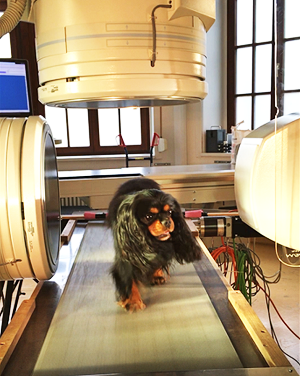 researchers (Mareike-Kristin
Nickel, Lisa Schikowski, Martin Stephan Fischer, Nicola Kelleners,
Martin Jürgen Schmidt, Nele Eley) examined the gait (walking and
trotting motions) of 15 healthy cavalier King Charles spaniels, 15
Chihuahuas, and 14 Labrador retrievers to compare the moving positions
of their junctions between the skull and spine (craniocervical junction
-- the atlanto-axial and atlanto-occipital joints) to determine if the
cavalier had any abnormalities at that junction when compared to the
Chihuahua and Labrador. The method used, called Scientific Rotoscoping,
is non-invasive and involves combining x-ray videos with skeletal
morphology data from CT scans, to create three-dimensional (3D) bone
animations in motion. Each dog was examined while walking or trotting on
a treadmill. (See photo at right.) The investigators
hypothesized that Scientific Rotoscoping would detect any odd motion
patterns and ranges of motion (ROM) in sound dogs of breeds, such as the
CKCS and Chihuahua, which are predisposed to craniocervical junction
abnormalities (CCJA) which may be a trigger to pathogenetic disorders
such as Chiari-like malformation (CLM). They report finding no
significantly different ranges of motion of the craniocervical joints in
the healthy cavaliers, compared to either the Chihuahua or the Labrador.
However, they suggest that their findings should have "important
implications for future comparisons between dogs with and without
CLM/SM."
researchers (Mareike-Kristin
Nickel, Lisa Schikowski, Martin Stephan Fischer, Nicola Kelleners,
Martin Jürgen Schmidt, Nele Eley) examined the gait (walking and
trotting motions) of 15 healthy cavalier King Charles spaniels, 15
Chihuahuas, and 14 Labrador retrievers to compare the moving positions
of their junctions between the skull and spine (craniocervical junction
-- the atlanto-axial and atlanto-occipital joints) to determine if the
cavalier had any abnormalities at that junction when compared to the
Chihuahua and Labrador. The method used, called Scientific Rotoscoping,
is non-invasive and involves combining x-ray videos with skeletal
morphology data from CT scans, to create three-dimensional (3D) bone
animations in motion. Each dog was examined while walking or trotting on
a treadmill. (See photo at right.) The investigators
hypothesized that Scientific Rotoscoping would detect any odd motion
patterns and ranges of motion (ROM) in sound dogs of breeds, such as the
CKCS and Chihuahua, which are predisposed to craniocervical junction
abnormalities (CCJA) which may be a trigger to pathogenetic disorders
such as Chiari-like malformation (CLM). They report finding no
significantly different ranges of motion of the craniocervical joints in
the healthy cavaliers, compared to either the Chihuahua or the Labrador.
However, they suggest that their findings should have "important
implications for future comparisons between dogs with and without
CLM/SM."
RETURN TO TOP
2022 News
December 2022:
Polish researchers find that diffusion tensor imaging (DTI)
detects severity of CM/SM symptoms in cavalier King Charles spaniels.
 In
a
December 2022 article, a team of Polish veterinary researchers
(Marcin Adam Wrzosek [right], Aleksandra Ewa Banasik, Karolina
Owsińska‐Schmidt, Anna Zimny) examined 30 cavalier King Charles
spaniels, 18 of which were confirmed by MRI to have syringomyelia (SM)
and 12 CKCSs without SM. Of the 18 CM/SM-affected dogs, 8 were
symptomatic and 10 were not. All dogs underwent diffusion tensor imaging
(DTI), a MRI modality which can provide a detailed assessment of the
intrinsic spinal tracts and a better understanding of how tissue damage
causes clinical deficiencies. It is a non‐invasive MRI technique which
is more sensitive to microstructural changes than conventional MR images
and is able to show abnormalities within the spinal cord which are not
visible on standard structural MR images. It measures microstructural
characteristics of water diffusion within the nervous tissues. They
report finding a difference in two DTI parameters: (1) fractional
anisotropy (FA) and (2) apparent diffusion coefficient (ADC) between
nonsymptomatic and symptomatic cavaliers. They concluded that the use of
DTI imaging in the MRI evaluation of CM/SM dogs (and humans) may be
useful in devising a protocol for an objective assessment of the spinal
cord and to understand what processes lie at the basis of many diseases,
the diagnosis of which is currently difficult.
(See, also this September 2021 item on the same study.)
In
a
December 2022 article, a team of Polish veterinary researchers
(Marcin Adam Wrzosek [right], Aleksandra Ewa Banasik, Karolina
Owsińska‐Schmidt, Anna Zimny) examined 30 cavalier King Charles
spaniels, 18 of which were confirmed by MRI to have syringomyelia (SM)
and 12 CKCSs without SM. Of the 18 CM/SM-affected dogs, 8 were
symptomatic and 10 were not. All dogs underwent diffusion tensor imaging
(DTI), a MRI modality which can provide a detailed assessment of the
intrinsic spinal tracts and a better understanding of how tissue damage
causes clinical deficiencies. It is a non‐invasive MRI technique which
is more sensitive to microstructural changes than conventional MR images
and is able to show abnormalities within the spinal cord which are not
visible on standard structural MR images. It measures microstructural
characteristics of water diffusion within the nervous tissues. They
report finding a difference in two DTI parameters: (1) fractional
anisotropy (FA) and (2) apparent diffusion coefficient (ADC) between
nonsymptomatic and symptomatic cavaliers. They concluded that the use of
DTI imaging in the MRI evaluation of CM/SM dogs (and humans) may be
useful in devising a protocol for an objective assessment of the spinal
cord and to understand what processes lie at the basis of many diseases,
the diagnosis of which is currently difficult.
(See, also this September 2021 item on the same study.)
November 2022: Canine Chiari Group at Univ. of Surrey announces the Head Space Project. The Canine Chiari Group at the Univeristy of Surrey in the UK (Drs. Clare Rusbridge, Kevin Wells, Mehran Taghipour Gorjikolaie, and Emma Scales-Therobald) are seeking to enable breeders of cavalier King Charles spaniels to select breeding stock less likely to develop syringomyelia (SM) and pass it on to their offspring. The effort is called the Head Space Project, as it is based upon objectively assessing the head shapes of CKCSs to identify those dogs more or less likely to become SM-affected. The Head Space Project's November 2022 Update is linked here.
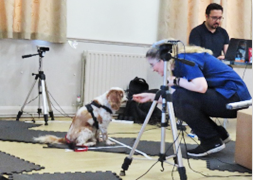 Prior
research has shown that certain head shapes make painful Chiari-like
malformation (CM-P) and SM more likely. Dogs with a higher cephalic
index, having a prominent stop at the top of their muzzle, with a
shorter muzzle, have been found to be more at risk for CM-P and SM. The
goal of the Head Space Project is to enable breeders to select young
cavaliers with less risky head shapes for breeding future litters. The
effort involves making 3-D computer models of each dog's complete head,
using a five-camera system. The entire set of photographs takes place
in less than a second. (See a photo of a session at right.)
Prior
research has shown that certain head shapes make painful Chiari-like
malformation (CM-P) and SM more likely. Dogs with a higher cephalic
index, having a prominent stop at the top of their muzzle, with a
shorter muzzle, have been found to be more at risk for CM-P and SM. The
goal of the Head Space Project is to enable breeders to select young
cavaliers with less risky head shapes for breeding future litters. The
effort involves making 3-D computer models of each dog's complete head,
using a five-camera system. The entire set of photographs takes place
in less than a second. (See a photo of a session at right.)
The project also is developing a computer program that will identify the likelihood of CM-P and inform dogs' owners and veterinarians of the likelihood of CM-P before recommendating expensive diagnostic tests. Ultimately, the aim is to combine this diagnostic tool with a health-related quality of life (HRQL) to create a CM-P specific HRQL tool. If you have a dog with known CM/SM MRI status and you are interested in participating, please contact Dr. Rusbridge at C.Rusbridge@surrey.ac.uk.
EDITOR'S NOTE: Our website, CavalierHealth.org, and its charitable trust, are providing financial support to this on-going research project.
September 2022:
Study of dura mater membrane of 121 cavaliers with Chiari-like
malformation shows abnormal conditions.
 In
a
September 2022 article, a team of New York researchers (Jaclyn P.
Holdsworth [right], Dominic J. Marino, Catherine A. Loughin,
Andrew D. Miller, Joseph J. Sackman, Martin L. Lesser, Marissa
O’Donnell) obtained biopsies of the dura mater (a thick membrane made of
dense tissue that surrounds the brain and spinal cord, the outermost of
the three layers of membrane called the meninges that is directly inside
the skull bone) from 121 cavalier King Charles spaniels during foramen
magnum decompression surgeries to relieve symptoms of Chiari-like
malformation (CM). Over half of the CKCSs (54.55%) were found to have
pathological changes to their dura mater, consisting of four different
types: (1) osseous metaplasia 35.54%), (2) fibrosis (13.22%), (3)
arachnoid hyperplasia (3.31%), and (4) mineralization (2.48%). Control
specimens of dura mater from 10 deceased dogs without CM all had uniform
thickness of dural collagen without any irregularities. The
investigators report finding no association between the different
histopathologic classifications and age, duration of clinical signs,
syrinx location, and the quality-of-life (QOL) before surgery. Further,
they were unable to determine the significance of these irregularities
as they relate to the development of syringomyelia (SM).
In
a
September 2022 article, a team of New York researchers (Jaclyn P.
Holdsworth [right], Dominic J. Marino, Catherine A. Loughin,
Andrew D. Miller, Joseph J. Sackman, Martin L. Lesser, Marissa
O’Donnell) obtained biopsies of the dura mater (a thick membrane made of
dense tissue that surrounds the brain and spinal cord, the outermost of
the three layers of membrane called the meninges that is directly inside
the skull bone) from 121 cavalier King Charles spaniels during foramen
magnum decompression surgeries to relieve symptoms of Chiari-like
malformation (CM). Over half of the CKCSs (54.55%) were found to have
pathological changes to their dura mater, consisting of four different
types: (1) osseous metaplasia 35.54%), (2) fibrosis (13.22%), (3)
arachnoid hyperplasia (3.31%), and (4) mineralization (2.48%). Control
specimens of dura mater from 10 deceased dogs without CM all had uniform
thickness of dural collagen without any irregularities. The
investigators report finding no association between the different
histopathologic classifications and age, duration of clinical signs,
syrinx location, and the quality-of-life (QOL) before surgery. Further,
they were unable to determine the significance of these irregularities
as they relate to the development of syringomyelia (SM).
July 2022:
Italian study of 43 cavaliers with Chiari-like malformation
showed no relationship with enlarged lateral ventricles.
 In a
July 2022 article, Italian researchers (Federica Tirrito [right], Francesca
Cozzi, Martina Bonaldi, Stefania Corazzo, Barbara Contiero, Rocco
Lombardo) reviewed the clinical records of 43 cavalier King Charles
spaniels diagnosed with Chiari-like malformation (CM), to to calculate
the sizes of their lateral ventricles and determine if there is any the
association between ventriculomegaly (dilated -- enlarged -- lateral
ventricles) and clinical signs, ventricular asymmetry, grade of CM
syringomyelia (SM) and degree of medullary kinking. Twenty-eight (65%)
dogs were male and 15 (35%) were female. The most common initial
clinical signs were scratching and neck pain. Ventriculomegaly was
identified in 70% of dogs, Chiari-like malformation grade 2 [(CM2);
cerebellum impacted or herniated through the foramen magnum] was
observed in 77% of cases, ventricular asymmetry in 54% and SM in 80% of the
cavaliers. The median medullary kinking index was 37.77%, and 28% of the
dogs had epileptic seizures. They report finding:
In a
July 2022 article, Italian researchers (Federica Tirrito [right], Francesca
Cozzi, Martina Bonaldi, Stefania Corazzo, Barbara Contiero, Rocco
Lombardo) reviewed the clinical records of 43 cavalier King Charles
spaniels diagnosed with Chiari-like malformation (CM), to to calculate
the sizes of their lateral ventricles and determine if there is any the
association between ventriculomegaly (dilated -- enlarged -- lateral
ventricles) and clinical signs, ventricular asymmetry, grade of CM
syringomyelia (SM) and degree of medullary kinking. Twenty-eight (65%)
dogs were male and 15 (35%) were female. The most common initial
clinical signs were scratching and neck pain. Ventriculomegaly was
identified in 70% of dogs, Chiari-like malformation grade 2 [(CM2);
cerebellum impacted or herniated through the foramen magnum] was
observed in 77% of cases, ventricular asymmetry in 54% and SM in 80% of the
cavaliers. The median medullary kinking index was 37.77%, and 28% of the
dogs had epileptic seizures. They report finding:
• No significant association between the grade of SM and class of ventriculomegaly.
• No significant association between dimension of lateral ventricles and any other conditions.
• No significant association between medullary kinking index and class of ventriculomegaly.
• No significant association between primary secretory otitis media (PSOM) and any clinical signs.
They concluded that "the prevalence of ventriculomegaly in Cavalier King Charles Spaniels is high but this finding does not seem related to the severity of clinical signs, presence of Chiari-like malformation, syringomyelia and craniocervical junction abnormalities such as medullary kinking." (See a September 2021 article on an abstract of the same study, below.)
May 2022:
3-D image mappings of cavaliers' heads may predict existence of
Chiari-like malformation and syringomyelia.
 Dr.
Clare Rusbridge (right) at the University of Surrey, is leading
a study of the shape of heads of cavalier King Charles spaniels, using
3-D imaging cameras, to try to predict the grades of Chiari-like
malformation (CM) and syringomyelia (SM) CKCS breeding stock before
performing MRI scans of CKCS breeding stock. Dr. Rusbridge stated:
Dr.
Clare Rusbridge (right) at the University of Surrey, is leading
a study of the shape of heads of cavalier King Charles spaniels, using
3-D imaging cameras, to try to predict the grades of Chiari-like
malformation (CM) and syringomyelia (SM) CKCS breeding stock before
performing MRI scans of CKCS breeding stock. Dr. Rusbridge stated:
"The aim is to use this as a low cost, non-invasive test that could be used to 'triage' before electing for MRI and to help inform selection for breeding. ... The 3D head mapping [in this study] will be correlated to the dog's MRI (and CT) and separately to the dog's clinical status for example signs of pain."
March 2022:
Danish study of syringomyelia-affected cavaliers finds spinal
cord dorsal horn anatomy relates to phantom scratching.
 In
a
March 2022 article, Danish researchers Danny Mortensen, Maria
Soendergaard Thoefner (right), Joergen Steen Agerholm, Lasse
Slumstrup, Troels Staehelin Jensen, Ole Jannik Bjerrum, Mette Berendt,
and Jens Randel Nyengaard studied eight cavalier King Charles spaniels
diagnosed with syringomyelia (SM) and four others without SM, to
determine if phantom scratching on only one side of the body of
SM-affected dogs related to pathological changes in their spinal cords.
Seven of the eight SM-affected CKCSs displayed signs of pain by phantom
scratching on only one side of their bodies, called "unilateral
scratching". They examined the two "dorsal horns" in spinal cord
segments C1 through C8 specifically. These dorsal horns are two
projections from the rear of the spinal column which contain neurons and
cells of the central nervous system. (See diagram at
In
a
March 2022 article, Danish researchers Danny Mortensen, Maria
Soendergaard Thoefner (right), Joergen Steen Agerholm, Lasse
Slumstrup, Troels Staehelin Jensen, Ole Jannik Bjerrum, Mette Berendt,
and Jens Randel Nyengaard studied eight cavalier King Charles spaniels
diagnosed with syringomyelia (SM) and four others without SM, to
determine if phantom scratching on only one side of the body of
SM-affected dogs related to pathological changes in their spinal cords.
Seven of the eight SM-affected CKCSs displayed signs of pain by phantom
scratching on only one side of their bodies, called "unilateral
scratching". They examined the two "dorsal horns" in spinal cord
segments C1 through C8 specifically. These dorsal horns are two
projections from the rear of the spinal column which contain neurons and
cells of the central nervous system. (See diagram at
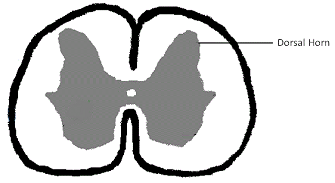 left.)
Each of the two horns consists of layers of gray matter called
"laminae", which are divided into sections (laminae I through VI in the
dorsal horn) based upon their location and function. In this study, the
investigators report finding that the cavaliers which phantom scratched
on only one side had some loss of the volume of laminae I through III of
the dorsal horn which is located on the same side of the spinal cord as
the side the dog phantom scratches, compared to the dorsal horn on the
opposite side. They also noted that in cavaliers which unilaterally
scratched, there were changes in the pain pathways at the dorsal root
entry zone of those dogs.
left.)
Each of the two horns consists of layers of gray matter called
"laminae", which are divided into sections (laminae I through VI in the
dorsal horn) based upon their location and function. In this study, the
investigators report finding that the cavaliers which phantom scratched
on only one side had some loss of the volume of laminae I through III of
the dorsal horn which is located on the same side of the spinal cord as
the side the dog phantom scratches, compared to the dorsal horn on the
opposite side. They also noted that in cavaliers which unilaterally
scratched, there were changes in the pain pathways at the dorsal root
entry zone of those dogs.
March 2022:
Deviated nasal septums are found common in cavaliers with
Chiari-like malformation (CM) but not related to painful CM or to
syringomyelia.
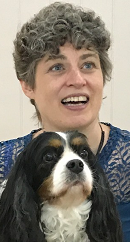 In
a
March 2022 poster presentation, researchers Clare Rusbridge
(right) and J. R. Rusbridge report on 53 cavaliers and 23 other
dogs, all diagnosed with Chiari-like malformation, and whether there is
any correlation between their severity of nasal septum deviation (NSD)
and CM with pain (CM-Pain) or with syringomyelia (SM). The nasal septum
is a thin wall which separates the two nasal cavities. A normal septum
evenly divides the nasal passages at a mid-line. When that wall is
off-center from the mid-line, it is deviated, making one nasal passage
smaller and the other larger. The more exaggerated that deviation from
the mid-line, the greater the reduction in airflow, causing breathing
difficulty. NSD has been associated with sleep disodered breathing (SDB)
in dogs and humans. SDB affects the drainage of cerebrospinal fluid,
which in turn could predispose the affected dogs to CM-Pain and SM.
In
a
March 2022 poster presentation, researchers Clare Rusbridge
(right) and J. R. Rusbridge report on 53 cavaliers and 23 other
dogs, all diagnosed with Chiari-like malformation, and whether there is
any correlation between their severity of nasal septum deviation (NSD)
and CM with pain (CM-Pain) or with syringomyelia (SM). The nasal septum
is a thin wall which separates the two nasal cavities. A normal septum
evenly divides the nasal passages at a mid-line. When that wall is
off-center from the mid-line, it is deviated, making one nasal passage
smaller and the other larger. The more exaggerated that deviation from
the mid-line, the greater the reduction in airflow, causing breathing
difficulty. NSD has been associated with sleep disodered breathing (SDB)
in dogs and humans. SDB affects the drainage of cerebrospinal fluid,
which in turn could predispose the affected dogs to CM-Pain and SM.
Of the 53 cavaliers in the study, 7 had CM without pain (CM-No_Pain), 14 had CM-Pain but no SM, and 32 also had SM. Only one CKCS had a mid-line septum with symmetrical nasal cavities. All of the others were deviated. In many dogs, the septum was "S" shaped, as if the septum was too large to fit within a shorter space, which may be an attribute of the dogs being brachycephalic. The researechers calculated the degree of deviation from the mid-line for each dog, as a ratio. Dogs with no septal deviation had a value of 0, and dogs with a completely deviated septum had a value of 1. They report finding that: (1) NSD is common in cavaliers and other breeds predisposed to CM/SM;, and (2) an association between NSD and CM/SM is unproven, but that more extreme brachycephaly is associated with both NSD and CM-Pain and SM; and (3) airway obstrtuction and SDB may be relevant to the development of CM/SM or be a comorbidity.
February 2022:
Customized 3–D-printed titanium device is used in cavaliers'
foramen magnum decompression surgery.
 In
a
February 2022 article, Italian neuro-surgeons (Alessia S. Colverde
[right], Tommaso Nicetto, Cristian Falzone) report on the use
of a customized 3–D-printed titanium prosthesis (device) as occipital
cranioplasty to cover the bone defect and enlarge the caudal fossa
(instead of the more traditional titanium mesh), following foramen
magnum decompression (FMD) in 8 CM/SM-affected dogs, including 6
cavalier King Charles spaniels (75%). Each prosthesis was customized by
using computed tomography (CT) of the dog's skull, followed by 3-D
reconstruction of the skull to design the prosthesis. (See photos of
one of the 3-D reconstructed skulls below.) FMD was performed, and
the prosthesis was implanted in each case. Follow-up examinations were
performed 1, 6, and 12 months later, and the clinical status of each
dog's recovery was graded. Repeated MRI images of 5 of the cases were
compared to identify changes involving the neural
In
a
February 2022 article, Italian neuro-surgeons (Alessia S. Colverde
[right], Tommaso Nicetto, Cristian Falzone) report on the use
of a customized 3–D-printed titanium prosthesis (device) as occipital
cranioplasty to cover the bone defect and enlarge the caudal fossa
(instead of the more traditional titanium mesh), following foramen
magnum decompression (FMD) in 8 CM/SM-affected dogs, including 6
cavalier King Charles spaniels (75%). Each prosthesis was customized by
using computed tomography (CT) of the dog's skull, followed by 3-D
reconstruction of the skull to design the prosthesis. (See photos of
one of the 3-D reconstructed skulls below.) FMD was performed, and
the prosthesis was implanted in each case. Follow-up examinations were
performed 1, 6, and 12 months later, and the clinical status of each
dog's recovery was graded. Repeated MRI images of 5 of the cases were
compared to identify changes involving the neural
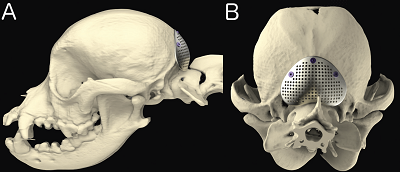 structures,
particularly the syrinx. The investigators report that all prostheses
were easily positioned based on the pre-operative 3-D models, with no
complications. At 12 months after surgery, 3 cavaliers were free of
previous medications, and 2 CKCSs were still receiving steroid
medications but at lower doses. MRI of 4 cavaliers 6 to 20 months after
surgery revealed resolution of SM in CKCS Case 7, reduced size of SM in
CKCS Cases 2 and 4, and worse SM in CKCS Case 6. Details of each of the
6 cavalier cases
are reported here.
structures,
particularly the syrinx. The investigators report that all prostheses
were easily positioned based on the pre-operative 3-D models, with no
complications. At 12 months after surgery, 3 cavaliers were free of
previous medications, and 2 CKCSs were still receiving steroid
medications but at lower doses. MRI of 4 cavaliers 6 to 20 months after
surgery revealed resolution of SM in CKCS Case 7, reduced size of SM in
CKCS Cases 2 and 4, and worse SM in CKCS Case 6. Details of each of the
6 cavalier cases
are reported here.
RETURN TO TOP
2021 News
October 2021:
Cambridge veterinary school needs cavaliers to study connection
of CM/SM to brachycephalic disorders.
 The
BOAS Research Group at the University of Cambridge's veterinary medicine
department announced in October 2021 that it needs cavalier King Charles
spaniels as subjects of a study of the relationship between body types
and Chiari-like malformation (CM) and syringomyelia (SM). BOAS stands
for ‘brachycephalic obstructive airway
syndrome. The investigators will be performing a respiratory
assessment of each dog together with a full clinical assessment to
screen for symptoms of CM/SM.
The research group's press release is
attached here. Contact Ph.D. candidate Francesca Tomlnison (right)
at
ft220@cam.ac.uk for more information or to offer your dog for the
study. Other breeds being studied are Affenpinscher, Boston terrier,
boxer, Chihuahua, Dogue de Bordeaux, Griffon Bruxellois, Japanese chin,
King Charles spaniel, Maltese terrier, Pekingese, Pomeranian, and Shih
Tzu.
The
BOAS Research Group at the University of Cambridge's veterinary medicine
department announced in October 2021 that it needs cavalier King Charles
spaniels as subjects of a study of the relationship between body types
and Chiari-like malformation (CM) and syringomyelia (SM). BOAS stands
for ‘brachycephalic obstructive airway
syndrome. The investigators will be performing a respiratory
assessment of each dog together with a full clinical assessment to
screen for symptoms of CM/SM.
The research group's press release is
attached here. Contact Ph.D. candidate Francesca Tomlnison (right)
at
ft220@cam.ac.uk for more information or to offer your dog for the
study. Other breeds being studied are Affenpinscher, Boston terrier,
boxer, Chihuahua, Dogue de Bordeaux, Griffon Bruxellois, Japanese chin,
King Charles spaniel, Maltese terrier, Pekingese, Pomeranian, and Shih
Tzu.
October 2021:
Syringomyelia "slosh" computer model shows how various syrinxes
may develop and expand in cavalier King Charles spaniels.
 In an
October 2021 article, Drs. Srdjan Cirovic (right) and Clare Rusbridge,
both at the Univeristy of Surrey in the UK, report
on a computer model they devised which may explain how syringomyelia
(SM) syrinxes (syringes) are created and expand, due to the impulsive movement of
cerebrospinal fluid (CSF), called "slosh". A magnetic resonance imaging
(MRI) scan of a cavalier King Charles spaniel was used as the model
design for the study. The investigators conducted simulations of various
spinal cord conditions, from the cord being free of cavities to small
syringes at different locations to a prorgessively expanding syrinx.
(See Figure 2, below.) They found that, if small syringes are present, there are peaks of
stress at those locations, the effect being most pronounced at the
locations at which syringes initially form. When the syrinx reaches the
lumbar region, the stress becomes moderate. They concluded that their
findings support the “slosh” hypothesis, suggesting that small cervical
syringes may progress, but when the syrinx is large, there is less
stress, which may explain why a syrinx can rapidly expand but then
remain unchanged in shape over years. Their stated conclusions:
In an
October 2021 article, Drs. Srdjan Cirovic (right) and Clare Rusbridge,
both at the Univeristy of Surrey in the UK, report
on a computer model they devised which may explain how syringomyelia
(SM) syrinxes (syringes) are created and expand, due to the impulsive movement of
cerebrospinal fluid (CSF), called "slosh". A magnetic resonance imaging
(MRI) scan of a cavalier King Charles spaniel was used as the model
design for the study. The investigators conducted simulations of various
spinal cord conditions, from the cord being free of cavities to small
syringes at different locations to a prorgessively expanding syrinx.
(See Figure 2, below.) They found that, if small syringes are present, there are peaks of
stress at those locations, the effect being most pronounced at the
locations at which syringes initially form. When the syrinx reaches the
lumbar region, the stress becomes moderate. They concluded that their
findings support the “slosh” hypothesis, suggesting that small cervical
syringes may progress, but when the syrinx is large, there is less
stress, which may explain why a syrinx can rapidly expand but then
remain unchanged in shape over years. Their stated conclusions:
"The results of this study strongly suggest that the spinal cord tissue in the vicinity of fluid-filled cavities experiences higher than normal mechanical stress due to the movement of the CSF from epidural excitation. When the syringes are longer than approximately 30 mm, filling of the epidural veins may generate the “slosh” effect, where the fluid is forced to the caudal end of the syrinx. The results for the simulations of an expanding syrinx are broadly consistent with the homeostatic hypothesis, as the stress in the cord is lower for the fully developed syrinx than for smaller syringes. Other, potentially more realistic, scenarios for syrinx expansion should be examined in the future. This study specifically addresses syringomyelia in dogs, and more specifically in CKCS. ... Considering anatomical and other differences (e.g., upright posture in humans) the results regarding the potential pattern of syrinx enlargement do not apply to humans or to dog breeds other than CKCS."
September 2021:
Study of CM/SM-affected cavaliers shows that diffusion tensor
MRI may predict future symptomatic syringomyelia in young dogs.
 In
a
September 2021 presentation at the 2021 ESVN-ECVN Symposium, a team
of Polish researchers (A. Banasik, Karolina Owsińska-Schmidt [right],
W. Krupińska, A. Zimny, M. Wrzosek) studied sixteen CM/SM-affected
cavalier King Charles spaniels to compare their clinical conditions with
diffusion tensor imaging (DTI) values to determine if DTI could
anticipate future development of clinical symptoms in asymptomatic
CM/SM-affected dogs. Half of the CKCSs were symptomatic of SM and the
other half were not. DTI is an advanced form of magnetic resonance
imaging (MRI) that uses multiple MRI scans, performed in numerous
different directions, of the same limited regional tissues of the brain
or spinal cord (called voxels) to create a 3-dimensional image showing
the directions in which water molecules diffuse in the tissue. In
this case, the researchers limited the region to the three intervertebal
spaces between the C1 and C4 vertebrae. They report finding differences
between the symptomatic and asymptomatic dogs which suggest that DTI
could be a useful technique in studying SM specifically in cavaliers, in
anticipating eventual development of clinical signs in young
CM/SM-affected dogs. They point out that DTI measurements may provide
more objective information about spinal cord structure and status.
(See also this December 2022 item on the same study.)
In
a
September 2021 presentation at the 2021 ESVN-ECVN Symposium, a team
of Polish researchers (A. Banasik, Karolina Owsińska-Schmidt [right],
W. Krupińska, A. Zimny, M. Wrzosek) studied sixteen CM/SM-affected
cavalier King Charles spaniels to compare their clinical conditions with
diffusion tensor imaging (DTI) values to determine if DTI could
anticipate future development of clinical symptoms in asymptomatic
CM/SM-affected dogs. Half of the CKCSs were symptomatic of SM and the
other half were not. DTI is an advanced form of magnetic resonance
imaging (MRI) that uses multiple MRI scans, performed in numerous
different directions, of the same limited regional tissues of the brain
or spinal cord (called voxels) to create a 3-dimensional image showing
the directions in which water molecules diffuse in the tissue. In
this case, the researchers limited the region to the three intervertebal
spaces between the C1 and C4 vertebrae. They report finding differences
between the symptomatic and asymptomatic dogs which suggest that DTI
could be a useful technique in studying SM specifically in cavaliers, in
anticipating eventual development of clinical signs in young
CM/SM-affected dogs. They point out that DTI measurements may provide
more objective information about spinal cord structure and status.
(See also this December 2022 item on the same study.)
Sepember 2021:
Wider foramen magnum decompression surgery results in
reduced size of syrinxes in three CM/SM-affected chihuahuas.
 In a
September 2021 presentation at the 2021 ESVN-ECVN Symposium, a
team of Japanese veterinary neurosurgeons (Yukiko Nakano [right], Y.
Nozue, K. Nakata, S. Kimura, H. Kamishina) performed foramen magnum
decompression (FMD) surguries on five small dogs diagnosed with
symptomatic Chiari-like malformation and syringomyelia (CM/SM). The dogs
were three chihuahuas and two toy poodles. They proceeded on the theory
that standard FMD surgeries thus far did not remove enough of the
occipital bone, because of the potential risk of damage of the transvers
sinus, to reduce the sizes of the patients' syrinxes. They report that
"The occipital bone was removed widely with a great care not to damage
the transvers sinus." They concluded:
In a
September 2021 presentation at the 2021 ESVN-ECVN Symposium, a
team of Japanese veterinary neurosurgeons (Yukiko Nakano [right], Y.
Nozue, K. Nakata, S. Kimura, H. Kamishina) performed foramen magnum
decompression (FMD) surguries on five small dogs diagnosed with
symptomatic Chiari-like malformation and syringomyelia (CM/SM). The dogs
were three chihuahuas and two toy poodles. They proceeded on the theory
that standard FMD surgeries thus far did not remove enough of the
occipital bone, because of the potential risk of damage of the transvers
sinus, to reduce the sizes of the patients' syrinxes. They report that
"The occipital bone was removed widely with a great care not to damage
the transvers sinus." They concluded:
"Complete resolution of clinical signs was seen in 2 dogs. Cerebellar symptoms such as ataxia and hypermetria remained in three dogs, but QOL [quality of life] of these dogs was improved and the owners were satisfied with the outcome. Three-month postoperative follow-up MRI performed in 3 dogs [all chihuahuas] revealed considerable reduction of the syrinx size. In conclusion, modified FMD+CP [foramen magnum decompression + carnioplasty] is a safe procedure and leads to considerable reduction of the syrinx in small-breed dogs. This procedure is expected to reduce the risk of recurrence of foramen magnum compression and syrinx formation by postoperative scar tissues.
September 2021:
Two cavaliers with Chiari-like malformation are relieved of pain
following surgery to de-tether the filum terminale from the spinal cord.
 In a
September 2021 presentation at the 2021 ESVN-ECVN Symposium,
neurological researchers from the UK and the USA (Ane Uriarte
[right], Abby McElroy, Petra Klinge) noted prior research reports
finding that cavalier King Charles spaniels diagnosed with CM but
without syringomyelia (SM) have been found to have a shorter filum
terminale internum than unaffected dogs. These researchers performed
surgery on two CM-affected cavaliers with a tethered spinal cord to detach (de-tether) the filum
terminale internum from the spinal cord. They report that, thereafter,
both dogs have been free of pain without medication, for 20 months and 7
months respectively, to the publication of their presentation.
In a
September 2021 presentation at the 2021 ESVN-ECVN Symposium,
neurological researchers from the UK and the USA (Ane Uriarte
[right], Abby McElroy, Petra Klinge) noted prior research reports
finding that cavalier King Charles spaniels diagnosed with CM but
without syringomyelia (SM) have been found to have a shorter filum
terminale internum than unaffected dogs. These researchers performed
surgery on two CM-affected cavaliers with a tethered spinal cord to detach (de-tether) the filum
terminale internum from the spinal cord. They report that, thereafter,
both dogs have been free of pain without medication, for 20 months and 7
months respectively, to the publication of their presentation.
A "tethered spinal cord" is the abnormal attachment of other tissues to the spinal cord, thereby limiting the cord's movement. This disorder may cause decreased blood flow, a low level of oxygen in the blood (hypoxemia), and compression of nerve roots. When the abnormally attached tissue is the filum terminale internium in dogs diagnosed with Chiari-like malformation (CM), spinal pain also may result.
September 2021:
No relationship between severity of CM/SM and ventriculomegaly is
found in 43 cavaliers in Italian study.
 In a
September 2021 presentation
at the 2021 ESVN-ECVN Symposium, a team of Italian veterinary
neurological researchers (Federica Tirrito [right], F. Cozzi,
S. Corazzo, B. Contiero, R. Lombardo) examined the MRI scans of 43
cavalier King Charles spaniels diagnosed with Chiari-like malformation
(CM) to determine if
ventriculomegaly is associated with CM and syringomyelia (SM), based upon symptoms,
ventricular shape, the grades of CM and SM, kinking of the medulla, and
epileptic seizures. They report finding that the common initial clinical
signs were scratching and neck pain. In addition:
In a
September 2021 presentation
at the 2021 ESVN-ECVN Symposium, a team of Italian veterinary
neurological researchers (Federica Tirrito [right], F. Cozzi,
S. Corazzo, B. Contiero, R. Lombardo) examined the MRI scans of 43
cavalier King Charles spaniels diagnosed with Chiari-like malformation
(CM) to determine if
ventriculomegaly is associated with CM and syringomyelia (SM), based upon symptoms,
ventricular shape, the grades of CM and SM, kinking of the medulla, and
epileptic seizures. They report finding that the common initial clinical
signs were scratching and neck pain. In addition:
• Ventriculomegaly was identified in 70% of the dogs;
• CM grade 2 was observed in 77% of cases;
• ventricular asymmetry was identified in 54% of the dogs;
• SM was identified in 80% of the dogs;
• median medullary kinking index was 37.77%;
• 28% of the dogs presented epileptic seizures.
They found no significant association between dimension the of the lateral ventricles and either any symptoms or MRI findings, and no significant association was identified between ventriculomegaly and epilepsy. They concluded that the prevalence of ventriculomegaly in CM-affected cavaliers is high but does not appear to be related to the severity of clinical signs, to CM/SM, to medullary kinking index, and/or to epileptic seizures. (See a July 2022 article on the full article of the same study, above.)
August 2021: Dr. Rusbridge adds Maropitant to her CM/SM Treatment Algorithm. Dr. Clare Rusbridge has revised her CM/SM treatment algorithm to add the antiemetic drug Maropitant Citrate (Cerenia) for initial treatment of phantom scratching due to syringomyelia (SM). As a result of an unpublished study of the drug's effectiveness and safety, she reports finding it benefits SM-affected dogs, and she has been using the drug routinely with success. Maropitant is a prescription drug which has been utilized to treat dogs for vomiting and motion sickness. For more details, see our CM/SM main page.
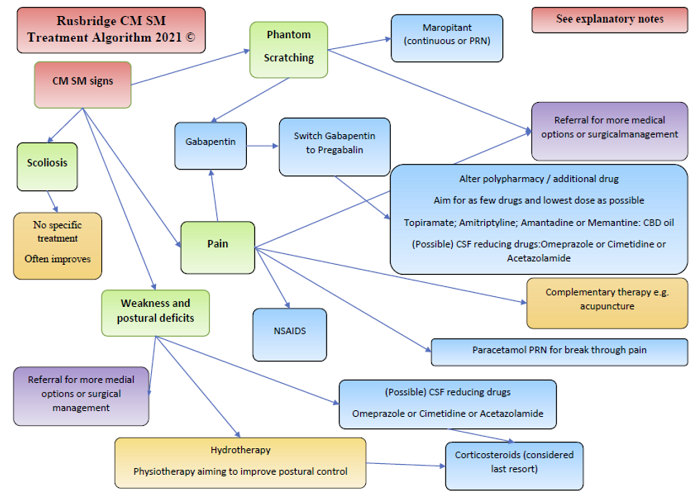
June 2021:
Danish researchers find no overall association between mitral
valve disease and syringomyelia in 55 cavaliers.
 In
a
June 2021 report at the 2021 ACVIM Forum, a team of Danish
researchers (Maiken Bayer Thode Bach [right], C.L. Stougaard,
M.S. Thofner, M.J. Reimann, U. Westrup, J. Koch, M. Fredholm, T.
Martinussen, M.Berendt, L.H. Olsen) studied the occurrence and severity
of mitral valve disease (MVD) in 55 Danish cavalier King Charles
spaniels with and without syringomyelia (SM) and with and without
clinical signs of SM. They report finding no overall association between
MVD and SM, which they concluded indicated that the underlying genetic
components differed in the two diseases. However, they also found that
dogs with symptomatic SM had less severe MVD compared to dogs with
asymptomatic SM.
In
a
June 2021 report at the 2021 ACVIM Forum, a team of Danish
researchers (Maiken Bayer Thode Bach [right], C.L. Stougaard,
M.S. Thofner, M.J. Reimann, U. Westrup, J. Koch, M. Fredholm, T.
Martinussen, M.Berendt, L.H. Olsen) studied the occurrence and severity
of mitral valve disease (MVD) in 55 Danish cavalier King Charles
spaniels with and without syringomyelia (SM) and with and without
clinical signs of SM. They report finding no overall association between
MVD and SM, which they concluded indicated that the underlying genetic
components differed in the two diseases. However, they also found that
dogs with symptomatic SM had less severe MVD compared to dogs with
asymptomatic SM.
April 2021:
Abnormal changes in the dura mater of 66 cavaliers with
Chiari-like malformation are reported in a USA study.
 In a
March 2021 article, a team of neurology researchers at the Long
Island Veterinary Specialists (Jaclyn P. Holdsworth [right], Dominic J. Marino,
Catherine A. Loughin, Andrew D. Miller, Joseph J. Sackman, Martin L
Lesser, Marissa O’Donnell) examined biopsies of the dura mater (the
membrane made of dense that surrounds the brain and spinal cord) to
determine what types of anatomical changes have occurred in the dura of
cavalier King Charles spaniels diagnosed with Chiari-like malformation
(CM) and syringomyelia (SM). Dura specimens of 121 CM-affected cavaliers
were obtained at the start of surgical procedures to relieve compression
of the cerebellum (foramen magnum decompression -- FMD). They made the
following findings:
In a
March 2021 article, a team of neurology researchers at the Long
Island Veterinary Specialists (Jaclyn P. Holdsworth [right], Dominic J. Marino,
Catherine A. Loughin, Andrew D. Miller, Joseph J. Sackman, Martin L
Lesser, Marissa O’Donnell) examined biopsies of the dura mater (the
membrane made of dense that surrounds the brain and spinal cord) to
determine what types of anatomical changes have occurred in the dura of
cavalier King Charles spaniels diagnosed with Chiari-like malformation
(CM) and syringomyelia (SM). Dura specimens of 121 CM-affected cavaliers
were obtained at the start of surgical procedures to relieve compression
of the cerebellum (foramen magnum decompression -- FMD). They made the
following findings:
• Mean age of the patients: 44.27 months (3.69 years)
• Mean duration of pre-surgical clinical signs: 44.78 weeks
• SM syrinx located only in cervical region of spinal cord: 39 (32.23%) patients
• SM syrinx located only in cervical and thoracic regions of spinal cord: 17 (14.05%) patients
• SM syrinx located in cervical, thoracic, and lumbar regions of spinal cord: 65 (53.72%) patients
• Anatomical changes in the dura: 66 (54.55%) patients
• No changes in the dura: 55 (45.45%) patients
• Osseous metaplasia (bone formation) in the dura: 43 (35.54%) patients
• Fibrosis (scarring): 16 (13.22%) patients
• Arachnoid hyperplasia (thickening of the inner dural surface): 4 (3.31%) patients
• Mineralization: 3 (2.48%) patients
They concluded that:
"The majority of dogs with CM were found to have histopathologic changes in the dura at the time of FMD cranioplasty was performed. These dural changes can be observed in dogs experiencing clinical signs for a time period as short as four weeks prior to presentation. Histopathologic changes were not associated with age, breed, duration of clinical signs, the location of syringomyelia or preoperative QOL. The influence of histopathologic changes on long term prognosis in dogs without dural decompression is unknown since all dogs in this study had dural resection."
February 2021:
Drs. Rusbridge and Knowler find impaired cerebrospinal fluid
ciculation predisposes Chiari-like malformation and syringomyelia in
cavaliers.
 In
a
February 2021 article, neurology researchers Clare Rusbridge and
Penny Knowler [right] review current data linking cerebrospinal
fluid [CSF] disorders with brachyephaly and shorten muzzles in cavalier
King Charles spaniels and other small breed dogs. They point out that there
is increasing evidence that brachycephaly disrupts CSF movement and
absorption, predisposing ventriculomegaly, hydrocephalus, and
quadrigeminal cistern expansion, as well as Chiari-like malformation
(CM) and syringomyelia (SM). They show how the reduction of the
lymphatic absorption of CSF through the lymphatic system organs located
in the nasal and skull base, combined with the restriction of CSF
movement through the junction of the skull with the spinal cord, appear
to be key consequences of extreme brachycephaly in dogs and explain the
likely causes of these neurological disorders.
In
a
February 2021 article, neurology researchers Clare Rusbridge and
Penny Knowler [right] review current data linking cerebrospinal
fluid [CSF] disorders with brachyephaly and shorten muzzles in cavalier
King Charles spaniels and other small breed dogs. They point out that there
is increasing evidence that brachycephaly disrupts CSF movement and
absorption, predisposing ventriculomegaly, hydrocephalus, and
quadrigeminal cistern expansion, as well as Chiari-like malformation
(CM) and syringomyelia (SM). They show how the reduction of the
lymphatic absorption of CSF through the lymphatic system organs located
in the nasal and skull base, combined with the restriction of CSF
movement through the junction of the skull with the spinal cord, appear
to be key consequences of extreme brachycephaly in dogs and explain the
likely causes of these neurological disorders.
Specifically relating to CM and SM, they state:
"Cavalier King Charles spaniels with syringomyelia associated with Chiari-like malformation have smaller volume jugular foramina compared to Cavalier King Charles spaniels without syringomyelia. However, direct causality between smaller jugular foramen and syringomyelia has not been proven. ... [C]raniosynostosis [premature closure of cranial sutures, preventing continued growth to accommodate the growing size of the brain] may be associated with a primary venous abnormality. Cavalier King Charles spaniels with syringomyelia associated with Chiari malformation have reduced volume caudal cranial fossa dorsal sinuses. ... Chiari-like malformation associated pain in dogs describes a syndrome of pain associated with brachycephaly and hindbrain herniation. It is often compared to Chiari type I and 0 malformation in humans. However, it is more like the hindbrain herniation seen with syndromic and complex craniosynostosis in humans, for example, Crouzon’s and Pfeiffer syndrome."
"In comparison to dogs with Chiari-like malformation only, dogs with syringomyelia have more extreme brachycephaly with craniocervical junction deformation, including cervical flexure, change in angulation of the odontoid peg, increased proximity of the atlas to the skull (often referred to as atlanto-occipital overlapping), kinking or elevation of the craniospinal junction, and loss of the cisterna magna. Changes in conformation of the spinal canal and cord may also contribute. The authors propose that syringomyelia develops due to a combination of reduced CSF absorption though nasal lymphatics, reduced venous drainage, altered neuroparenchymal compliance, and reduced CSF movement through the lateral apertures or craniocervical junction. Curvature of the spinal canal and intrathoracic pressure gradient may contribute especially in the thoracic spinal cord. The mechanism of development of syringomyelia is controversial. The most accepted theory is that subarachnoid space obstruction results in a mismatch in timing between the arterial pulse peak pressure and CSF pulse peak pressure."
January 2021:
Syringomyelia is the major cause of cervical hyperaesthesia
(neck pain) in cavaliers, in a UK study.
 In
a
November 2020 article, a team of Royal Veterinary College
researchers (Nicholas John Grapes [right], Rowena Mary Anne
Packer, Steven De Decker) studied the medical records of 298 dogs
diagnosed with cervical hyperaesthesia (showing signs of neck pain, such
as a lowered head carriage, response to palpation of the cervical
musculature, or resistance to manipulation of the head). Cavalier King
Charles spaniels were the most prevalent breed (49 CKCSs - 16.4%) out of
54 breeds. Eighty-eight percent of the CKCSs were diagnosed with syringomyelia
(SM). SM was found to be the third most common diagnosed condition
causing cervical hyperaesthesia (51 dogs - 17.1%), behind
steroid‐responsive meningitis arteritis (100 dogs -33.6%) and
intervertebral disc extrusion (78 dogs - 26.2%).
In
a
November 2020 article, a team of Royal Veterinary College
researchers (Nicholas John Grapes [right], Rowena Mary Anne
Packer, Steven De Decker) studied the medical records of 298 dogs
diagnosed with cervical hyperaesthesia (showing signs of neck pain, such
as a lowered head carriage, response to palpation of the cervical
musculature, or resistance to manipulation of the head). Cavalier King
Charles spaniels were the most prevalent breed (49 CKCSs - 16.4%) out of
54 breeds. Eighty-eight percent of the CKCSs were diagnosed with syringomyelia
(SM). SM was found to be the third most common diagnosed condition
causing cervical hyperaesthesia (51 dogs - 17.1%), behind
steroid‐responsive meningitis arteritis (100 dogs -33.6%) and
intervertebral disc extrusion (78 dogs - 26.2%).
EDITOR'S NOTE: This article makes only a passing reference to Chiari-like malformation (CM). It acknowledges that SM is "typically associated with Chiari-like malformation", but it makes no findings about the presence of CM in any of the cavaliers in the study. Other neurology researchers, including Dr. Clare Rusbridge, have reported finding that cervical pain appears to be due to CM and not to SM. As an example, they have found that foramen magnum decompression surgery -- which is aimed at directly resolving the CM condition -- will relieve neck pain but will not improve the SM. And so, we suspect that the authors of this study have concluded wrongly that the dogs' SM is the cause of cervical hyperaesthesia, and that instead it is the unspoken but necessarily present CM which is the underlying cause. Nevertheless, this article serves to point out that many cavaliers and other CM/SM-affected dogs also exhibit neck pain, and that diagnoses of cervical hyperaesthesia should prompt an investigation into the presence of CM/SM. The UK Kennel Club also should take notice of this article.
January 2021:
NCSU researchers find that the position of the filum terminale
internum may determine CM/SM pain sources in cavaliers. In a
January 2021 article, a team of North Carolina State University
veterinary researchers (Courtney R. Sparks, Christian Woelfel, Ian
Robertson, Natasha J. Olby) studied 48 cavaliers with Chiari-like
malformation
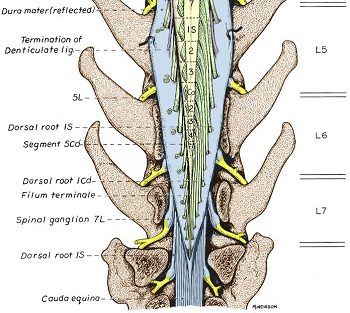 (CM) -- 23 (48%) without syringomyelia (SM), 2 (4%) with
only cervical SM, 1 (2%) with only lumbar SM, and 22 (46%) with both
cervical and lumbar SM. All dogs with lumbar SM also had thoracic SM
(48%). Of the 23 dogs with only CM, 16 (33%) were pain-free and 7 (15%)
were symptomatic; 12 (25%) of the SM-affected dogs were asymptomatic;
and 13 (27%) of the SM-affected dogs were symptomatic of pain. Their
goal was to determine any relationships between the rear termination
points of the spinal cord and any pain -- due either to CM or SM --
experienced by cavaliers. The dog's spinal cord tapers to a relatively
elastic structure called the filum terminale internum, surrounded by the
dural sac. (See "filum terminale" in diagram at right.) They aimed first to describe
and compare the site of spinal cord and dural sac termination in
symptomatic and asymptomatic CKCS, and second to quantify and compare
the length of the filum terminale internum (FTIL) between these 2 groups
of dogs. They report finding that:
(CM) -- 23 (48%) without syringomyelia (SM), 2 (4%) with
only cervical SM, 1 (2%) with only lumbar SM, and 22 (46%) with both
cervical and lumbar SM. All dogs with lumbar SM also had thoracic SM
(48%). Of the 23 dogs with only CM, 16 (33%) were pain-free and 7 (15%)
were symptomatic; 12 (25%) of the SM-affected dogs were asymptomatic;
and 13 (27%) of the SM-affected dogs were symptomatic of pain. Their
goal was to determine any relationships between the rear termination
points of the spinal cord and any pain -- due either to CM or SM --
experienced by cavaliers. The dog's spinal cord tapers to a relatively
elastic structure called the filum terminale internum, surrounded by the
dural sac. (See "filum terminale" in diagram at right.) They aimed first to describe
and compare the site of spinal cord and dural sac termination in
symptomatic and asymptomatic CKCS, and second to quantify and compare
the length of the filum terminale internum (FTIL) between these 2 groups
of dogs. They report finding that:
• Painful cavaliers with only CM had shorter FTIL compared to CM-only pain-free cavaliers and also painful cavaliers with SM.
• Longer spinal cord termination (filum terminale) is associated with development of lumbar SM.
RETURN TO TOP
2020 News
August 2020:
Colorado State Univ. researchers find gabapentin is
well-tolerated at high dosages for dogs in chronic pain.
 In
an
August 2020 article, a team of Colorado State University researchers
(Lily V Davis, Peter W Hellyer, Robin A Downing, Lori R Kogan [right])
studied the treatment records of 240 dogs suffering chronic pain due to
a variety of diagnosed causes, including osteoarthritis (84.6%),
generalized, nonspecific back pain (9.2%), intervertebral disk disease
(7.5%), degenerative myelopathy (4.6%), and 56.67% not having a
definitive anatomical cause for their pain. None of the dogs had been
diagnosed with either Chiari-like malformation or syringomyelia. They
report finding that:
In
an
August 2020 article, a team of Colorado State University researchers
(Lily V Davis, Peter W Hellyer, Robin A Downing, Lori R Kogan [right])
studied the treatment records of 240 dogs suffering chronic pain due to
a variety of diagnosed causes, including osteoarthritis (84.6%),
generalized, nonspecific back pain (9.2%), intervertebral disk disease
(7.5%), degenerative myelopathy (4.6%), and 56.67% not having a
definitive anatomical cause for their pain. None of the dogs had been
diagnosed with either Chiari-like malformation or syringomyelia. They
report finding that:
"The results from this case series suggest that gabapentin is well-tolerated at much higher doses than what is typically prescribed. Side effects were uncommon, with no clear pattern based on dose, or dog size or age. Therefore, like many other analgesic medications, the efficacy of gabapentin appears patient-specific and should be dosed to effect until side effects are noted or analgesia is achieved
 June 2020:
Dr. Rusbridge presents a current, thorough review of
Chiari-like malformation (CM) and syringomyelia (SM).
In
a
June 2020 article, Dr. Clare Rusbridge (right) has authored
a thorough, updated guide to the signs, diagnosis, and treatment of CM
and SM in cavalier King Charles spaniels. Publication of this article
has been fully funded by the
Cavalier Health Fund, the charitable trust associated with this
website. The purpose of the article is to update the veterinary
profession on CM/SM and provide a guide to diagnosis and treatment of
these inherited diseases in the cavalier and a few other brachycephalic
breeds. As Dr. Rusbridge states in her article:
June 2020:
Dr. Rusbridge presents a current, thorough review of
Chiari-like malformation (CM) and syringomyelia (SM).
In
a
June 2020 article, Dr. Clare Rusbridge (right) has authored
a thorough, updated guide to the signs, diagnosis, and treatment of CM
and SM in cavalier King Charles spaniels. Publication of this article
has been fully funded by the
Cavalier Health Fund, the charitable trust associated with this
website. The purpose of the article is to update the veterinary
profession on CM/SM and provide a guide to diagnosis and treatment of
these inherited diseases in the cavalier and a few other brachycephalic
breeds. As Dr. Rusbridge states in her article:
"The condition is most common in Cavalier King Charles spaniels (CKCS) and their crosses (eg, cavapoos), especially if the cross is with a smaller dog than a CKCS."
 EDITOR'S
NOTE: The article is freely accessible in
the pdf format
here, and even though Dr. Rusbridge's target audience is the small
animal veterinary community, we strongly recommend that all current and
future cavalier owners download the article and read it for themselves.
We cannot count on our general practice veterinarians to have
familiarized themselves with the details of CM/SM, and it is especially
valuable for cavalier fanciers to be able to recognize the signs and
symptoms of these two painful and potentially life-threatening diseases.
It is for this important reason that our charitable trust, the
Cavalier Health
Fund, has fully funded the publication of this article so that it is
available at no cost to anyone interested in reading it.
EDITOR'S
NOTE: The article is freely accessible in
the pdf format
here, and even though Dr. Rusbridge's target audience is the small
animal veterinary community, we strongly recommend that all current and
future cavalier owners download the article and read it for themselves.
We cannot count on our general practice veterinarians to have
familiarized themselves with the details of CM/SM, and it is especially
valuable for cavalier fanciers to be able to recognize the signs and
symptoms of these two painful and potentially life-threatening diseases.
It is for this important reason that our charitable trust, the
Cavalier Health
Fund, has fully funded the publication of this article so that it is
available at no cost to anyone interested in reading it.
 April
2020:
Dr. Rusbridge issues the latest version of her CM/SM Treatment
Algorithm. Dr. Clare Rusbridge has published the April 2020
edition of her Chiari-Like Malformation (CM) & Syringomyelia (SM)
Treatment Algorithm, linked here.
It now includes a second page of explanatory notes, including a list of
drugs and their recommended dosages.
April
2020:
Dr. Rusbridge issues the latest version of her CM/SM Treatment
Algorithm. Dr. Clare Rusbridge has published the April 2020
edition of her Chiari-Like Malformation (CM) & Syringomyelia (SM)
Treatment Algorithm, linked here.
It now includes a second page of explanatory notes, including a list of
drugs and their recommended dosages.
April 2020:
MRIs and computed tomography (CT) are compared in
diagnosing CM/SM in 30 cavaliers.
 In an
April 2020 article, a team of Ohio State veterinary researchers
(Sarah M Weber, Eric T Hostnik [right], Wm Tod Drost, Alessandra N Hamlin, Marc
A Ledesma, Lauren Timperman, Ashley C. Hechler, Lynette K Cole) compared
high-field magnetic resonance imaging (MRI) with multidetector computed
tomography (CT) for grading Chiari‐like malformation (CM) and
syringomyelia (SM) in 30 cavalier King Charles spaniels. (See Figure
2, below.) The dogs had
been MRI and CT scanned previously for Dr. Lynette Cole's study of
primary secretory otitis media (PSOM) in the breed. The current study
also included three classes of observers with different levels of
experience -- two American college of veterinary radiology diplomates
(DACVR) and two second-year veterinary radiology residents and two small
animal veterinary interns. They point out the reason for the study is
that, "Computed tomography is financially cheaper, shorter in
acquisition time, more accessible to general practitioners, and requires
less anesthetic drugs/time." The results of the study support the
hypothesis that the overall agreement and the agreement between observer
groups of similar experience levels is higher using MRI compared to CT.
As expected, the accuracy for diagnosis by experienced radiologists of
cerebellar herniation and SM using MRI was higher than CT. However, CT
had a higher accuracy among the second-year radiology residents and
veterinary interns for identifying cerebellar herniation, which
countered the investigators' hypothesis that MRI is a better tool for CM
evaluation. They concluded:
In an
April 2020 article, a team of Ohio State veterinary researchers
(Sarah M Weber, Eric T Hostnik [right], Wm Tod Drost, Alessandra N Hamlin, Marc
A Ledesma, Lauren Timperman, Ashley C. Hechler, Lynette K Cole) compared
high-field magnetic resonance imaging (MRI) with multidetector computed
tomography (CT) for grading Chiari‐like malformation (CM) and
syringomyelia (SM) in 30 cavalier King Charles spaniels. (See Figure
2, below.) The dogs had
been MRI and CT scanned previously for Dr. Lynette Cole's study of
primary secretory otitis media (PSOM) in the breed. The current study
also included three classes of observers with different levels of
experience -- two American college of veterinary radiology diplomates
(DACVR) and two second-year veterinary radiology residents and two small
animal veterinary interns. They point out the reason for the study is
that, "Computed tomography is financially cheaper, shorter in
acquisition time, more accessible to general practitioners, and requires
less anesthetic drugs/time." The results of the study support the
hypothesis that the overall agreement and the agreement between observer
groups of similar experience levels is higher using MRI compared to CT.
As expected, the accuracy for diagnosis by experienced radiologists of
cerebellar herniation and SM using MRI was higher than CT. However, CT
had a higher accuracy among the second-year radiology residents and
veterinary interns for identifying cerebellar herniation, which
countered the investigators' hypothesis that MRI is a better tool for CM
evaluation. They concluded:
"Computed tomography does not replace MRI for the diagnosis and classification of CM and SM in CKCS. The accuracy and agreement for identifying cerebellar herniation and SM in experienced observers was higher utilizing high-field MRI compared to multislice CT. Breeding programs for CKCS should continue to utilize MRI for antemortem diagnosis of CM and SM to help improve the genetic pool and minimize the risks for neuropathic pain brought about by CM and SM. Individuals with greater diagnostic imaging experience (DACVR) resulted in better agreement for both MRI and CT and higher sensitivity, specificity, and accuracy for cerebellar herniation and SM. Magnetic resonance imaging interpreted by experienced observers should remain the standard tool for CM and SM screening programs."
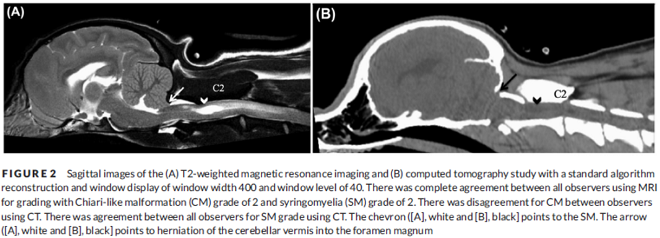
March 2020:
US researchers find that infrared thermal imaging accurately
detected syrinxes in 48 CM/SM-affected cavaliers 70% of the time.
 In a
March 2020 article, a team of US neurological researchers (Michael
Larkin, Catherine Loughin, Dominic Marino [right], Curtis Dewey, Scott
Umbaugh, Joseph Sackman) studied medical infrared thermal images (MITI)
of 93 cavalier King Charles spaniels to determine if MITI could detect
syrinxes in cavaliers diagnosed by MRI as having syringomyelia (SM). All
93 dogs had been examined by MRI and found to have Chiari-like
malformation. Of those, 48 were diagnosed with SM and 45 had no evidence
of SM. The authors tested MITI devices using a variety of texture
distances, finding that a distance of 6 produced the best results --
69.9% accuracy in detecting syrinxes known by MRI to be present. They
concluded:
In a
March 2020 article, a team of US neurological researchers (Michael
Larkin, Catherine Loughin, Dominic Marino [right], Curtis Dewey, Scott
Umbaugh, Joseph Sackman) studied medical infrared thermal images (MITI)
of 93 cavalier King Charles spaniels to determine if MITI could detect
syrinxes in cavaliers diagnosed by MRI as having syringomyelia (SM). All
93 dogs had been examined by MRI and found to have Chiari-like
malformation. Of those, 48 were diagnosed with SM and 45 had no evidence
of SM. The authors tested MITI devices using a variety of texture
distances, finding that a distance of 6 produced the best results --
69.9% accuracy in detecting syrinxes known by MRI to be present. They
concluded:
"This study revealed that MITI is a successful screening test for the presence of SM in CKCS with CLM. Compared to other imaging modalities, MITI is a quick, inexpensive modality that does not require sedation nor anesthesia, and eliminates radiation exposure (to patient & staff). MITI does not provide insight to syrinx location or severity nor should it be used as a sole diagnostic modality. While veterinary thermographic imaging continues to improve as advances in technology occur, MRI will remain the gold standard for definitive diagnosis and staging of Chiari-like malformation and syringomyelia."
Figure 1: Thermograms of CKCS: Left image is CKCS without SM;
right image is CKCS with SM.
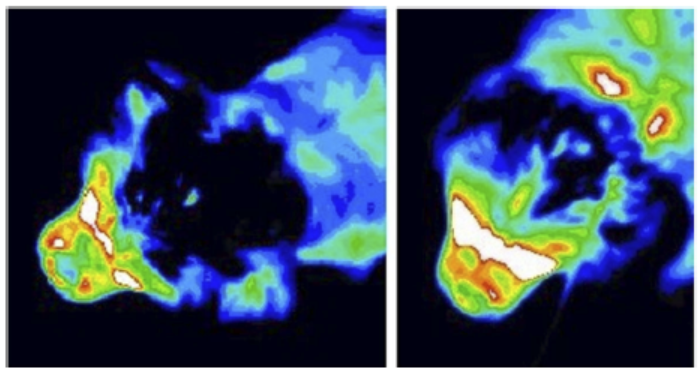
March 2020:
Netherland's CKCS MRI screening law for syringomyelia
proves that selecting unaffected parents leads to less SM in offspring.
 In a
March 2020 master's thesis, Utrecht Univ. student Maxime
Laterveer (right) advises that since 2004, the Netherlands has
maintained a law-enforced obligatory screening program prior to breeding
Dutch cavaliers. She used that resource to review 572 MRI brain scans of
518 Dutch cavalier King Charles spaniels screened in 2016 through 2018,
12 to 14 years since enactment of the Dutch law, to evaluate the effect
of phenotypic selection by combining pedigree data and screening results
of two to three generations of dogs, to see if there is any improvement
in the breeding stock.
She classified central canal dilation (CCD) of 0 mm. as
SM-unaffected and CCD of >0 mm. as SM-affected. She reports finding that
the prevalence of SM was 22.7% and that it increased with age. She found
that:
In a
March 2020 master's thesis, Utrecht Univ. student Maxime
Laterveer (right) advises that since 2004, the Netherlands has
maintained a law-enforced obligatory screening program prior to breeding
Dutch cavaliers. She used that resource to review 572 MRI brain scans of
518 Dutch cavalier King Charles spaniels screened in 2016 through 2018,
12 to 14 years since enactment of the Dutch law, to evaluate the effect
of phenotypic selection by combining pedigree data and screening results
of two to three generations of dogs, to see if there is any improvement
in the breeding stock.
She classified central canal dilation (CCD) of 0 mm. as
SM-unaffected and CCD of >0 mm. as SM-affected. She reports finding that
the prevalence of SM was 22.7% and that it increased with age. She found
that:
"Results indicated that selecting unaffected parents leads to a lower CCD in offspring. This reduction in CCD is even more if parents with healthier grandparents are given priority. Conversely, the offspring of affected parents was more likely to have an increase in CCD. ... It is concluded that, the obligatory screening for and subsequent selection for older unaffected CKCS, the offspring indeed improved each generation and as indicated by a reduced prevalence of Syringomyelia."
Ms. Laterveer also measured Chiari-like malformation (CM) and primary secretory otitis media (PSOM) in the dogs. She found that the prevalence of PSOM in the left ear was 19.4% and in the right ear 20.0%, and that neither PSOM nor CM improved upon screening for unaffected parents.
RETURN TO TOP
2019 News
November 2019:
Denmark researchers find pregabalin alleviates signs of CM/SM
pain in cavaliers.
 In a
November 2019 article, a team of Danish veterinary researchers
(Maria S. Thoefner [right], Lene T. Skovgaard, Fintan J. McEvoy, Mette Berendt,
Ole J. Bjerrum) report on their study of the effects of pregabalin
treatment upon 12 cavalier King Charles spaniels diagnosed with
Chiari-like malformation (CM) and syringomyelia (SM) and displaying
scratching episodes indicating neuropathic pain and symptomatic SM. The
cavaliers were aged from 1 to 7+ years. they were divided into two
groups, pregabalin and placebo, and they were treated over a period of
25 days, then no treatment for 2 days, then switched treatment for
another 25 days, so that both groups eventually were treated and
placebo.
In a
November 2019 article, a team of Danish veterinary researchers
(Maria S. Thoefner [right], Lene T. Skovgaard, Fintan J. McEvoy, Mette Berendt,
Ole J. Bjerrum) report on their study of the effects of pregabalin
treatment upon 12 cavalier King Charles spaniels diagnosed with
Chiari-like malformation (CM) and syringomyelia (SM) and displaying
scratching episodes indicating neuropathic pain and symptomatic SM. The
cavaliers were aged from 1 to 7+ years. they were divided into two
groups, pregabalin and placebo, and they were treated over a period of
25 days, then no treatment for 2 days, then switched treatment for
another 25 days, so that both groups eventually were treated and
placebo.
They determined the results of the treatment by observing the number of scratching events during 10 minutes of physical activity. They report finding an average of 84% (from 75% to 89%) reduction in the number of scratching events relative to the baseline when compared to the placebo. The dogs' owners assessed the quality of life after treatment as "good" or "could not be better" in 6 of 11 dogs and improved in 4 of 11 dogs. The most prevalent adverse events were increased appetite in 9 of all 12 dogs and transient ataxia (lack of some muscle control) in 9 of the 12 dogs. The researchers concluded that:
"Pregabalin is superior to placebo in the reduction of clinical signs of syringomyelia-related central neuropathic pain in dogs. At a dose range of 13–19 mg kg-1 orally twice daily the encountered adverse events were acceptable to all but one owner."
EDITOR'S NOTE: See a similar study published in July 2019, discussed here.
November 2019:
UK study shows that more brachycephalic cavaliers'
heads are more likely to have painful Chiari-like malformation and large
syrinxes.
 In a
November 2019 article, a team of UK researchers (Susan P.
Knowler [right], Eleonore Dumas, Michaela Spiteri, Angus K. McFadyen, Felicity
Stringer, Kevin Wells, Clare Rusbridge) reviewed the medical records of
66 cavalier King Charles spaniels (CKCS), 40 of which had syringomyelia
(SM) and the other 26 did not; 55 had Chiari-like malformation (CM) and
11 did not. The dogs were grouped by (1) control group of 11 with no
Chiari-like malformation (CM-N); (2) CM pain group (CM-P) of 15 dogs;
(3) clinical SM group (SM-S) of 40 dogs. SM-S dogs included those with
outward symptoms of SM (variable phantom scratching, scoliosis, etc.)
and a syrinx of at least 4 mm. The researchers divided their study into
two sub-sets, the first examined head features related to the dogs' soft
palates, and the other examined features related to their hard palates;
both sub-sets also included review of the dogs' features related to
forebrain flattening and olfactory bulb rotation. The olfactory bulb is
a bulb of neural tissue within the dog’s fore-brain. Their work included
comparing the shape of the "stop" of each dog, which is the degree of
the angle where the nose and skull meet, and the indentation between the
eyes at that point. A "gentle stop" has the least angular shape and a
"pronounced stop" has the sharpest angle.
In a
November 2019 article, a team of UK researchers (Susan P.
Knowler [right], Eleonore Dumas, Michaela Spiteri, Angus K. McFadyen, Felicity
Stringer, Kevin Wells, Clare Rusbridge) reviewed the medical records of
66 cavalier King Charles spaniels (CKCS), 40 of which had syringomyelia
(SM) and the other 26 did not; 55 had Chiari-like malformation (CM) and
11 did not. The dogs were grouped by (1) control group of 11 with no
Chiari-like malformation (CM-N); (2) CM pain group (CM-P) of 15 dogs;
(3) clinical SM group (SM-S) of 40 dogs. SM-S dogs included those with
outward symptoms of SM (variable phantom scratching, scoliosis, etc.)
and a syrinx of at least 4 mm. The researchers divided their study into
two sub-sets, the first examined head features related to the dogs' soft
palates, and the other examined features related to their hard palates;
both sub-sets also included review of the dogs' features related to
forebrain flattening and olfactory bulb rotation. The olfactory bulb is
a bulb of neural tissue within the dog’s fore-brain. Their work included
comparing the shape of the "stop" of each dog, which is the degree of
the angle where the nose and skull meet, and the indentation between the
eyes at that point. A "gentle stop" has the least angular shape and a
"pronounced stop" has the sharpest angle.
They found (see figure 5 below):
• CM-N dogs (no CM) had the least brachycephalic head, a gentle stop with the greatest upper jaw area between the hard palate and the frontal bone, and the longest soft palate length.
• CM-P dogs (painful CM) had the least distance between the hard palate and cranium, a pronounced stop, and a displaced olfactory bulb.
• CM-S dogs (large syrinx) had the most reduced middle craial bone area and shortest distance between the connection of the hard and soft palates with the base of the cranium.
They conclude that dogs with CM-P had the shortest muzzle lengths, and that "a reduced distance between the hard palate and the frontal bone was particularly associated with CM-P." Dr. Clare Rusbridge, one of the researchers, explained:
"Dogs with clinically relevant CM/SM are more likely to have brachycephalic features of the rostral skull flattening with reduction of nasal tissue and a well-defined stop. This evidence not only enhances our understanding of the disease and 'at risk' head conformation but could also impact on the assessment of MRI and disease diagnosis. It suggests the whole skull should be analyzed and not just the hindbrain currently required in prebreeding screening. This information has implications not only for breeders and pet owners but also for the veterinary profession to raise awareness about the welfare aspects of breeding. Furthermore, an increased risk for SM and painful CM might not be confined to brachycephalic breeds but other miniaturized purebreeds and hybrids that have gained in popularity as pets."
Co-researcher Dr. Susan P. Knowler explained:
"This study suggests that the whole skull, rather than just the hindbrain, should be analysed in diagnostic tests. It also impacts on how we should interpret MRI from affected dogs and the choices we make when we breed predisposed dogs and develop breeding recommendations. ... The brachycephalic features that can be seen from outside is a head that has flattening at the front with reduction of nasal tissue and a well-defined stop."
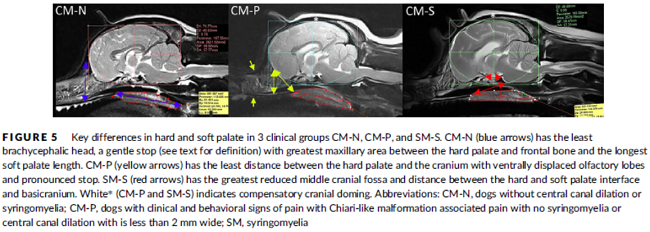
September 2019:
British CM/SM researchers use biomarkers found by
"machine-learning" to identify cavaliers with and without painful
Chiari-like malformation and symptomatic syringomyelia.
 In
a
September 2019 article, a team of UK neurology researchers (Michaela
Spiteri [right], Knowler, S.P., Rusbridge, C., Wells, K.) used
"machine-learning" to identify biomarkers which distinguish between
cavalier King Charles spaniels with and without pain due to Chiari-like
malformation (CM-P) and also those with and without syringomyelia (SM).
Thirty-two CKCSs were included in the study, of which 10 had pain due to
CM, 11 had symptomatic SM (SM-S), and 11 controls which had neither CM-P
nor SM. "Machine-learning" is a process of a computer not explicitly
programmed by people, which looks for patterns and data, then analyzes
that information and draws conclusions and makes predictions from that
gathered information. In this case, the machine looked for morphological
changes in the dogs, which may not be apparent to human observers,
thereby removing potential bias or blindness that may be produced by a
hypothesis driven expert observer approach. The machine learning
approach was to understand neuromorphological change and to identify
image-based biomarkers in dogs with CM-P and and symptomatic SM (SM-S).
Upon comparing dogs with CM-P or SM-S to the control group, candidate biomarkers
were identified in specific regions of the brain for CM-P and for SM-S,
particularly between the presphenoid bone and area between the
soft palate and the tongue, which they concluded indicates both
conditions being strongly related to changes within that area. This is a
very preliminary study aimed at developing these biomarkers into a
clinical diagnostic test.
In
a
September 2019 article, a team of UK neurology researchers (Michaela
Spiteri [right], Knowler, S.P., Rusbridge, C., Wells, K.) used
"machine-learning" to identify biomarkers which distinguish between
cavalier King Charles spaniels with and without pain due to Chiari-like
malformation (CM-P) and also those with and without syringomyelia (SM).
Thirty-two CKCSs were included in the study, of which 10 had pain due to
CM, 11 had symptomatic SM (SM-S), and 11 controls which had neither CM-P
nor SM. "Machine-learning" is a process of a computer not explicitly
programmed by people, which looks for patterns and data, then analyzes
that information and draws conclusions and makes predictions from that
gathered information. In this case, the machine looked for morphological
changes in the dogs, which may not be apparent to human observers,
thereby removing potential bias or blindness that may be produced by a
hypothesis driven expert observer approach. The machine learning
approach was to understand neuromorphological change and to identify
image-based biomarkers in dogs with CM-P and and symptomatic SM (SM-S).
Upon comparing dogs with CM-P or SM-S to the control group, candidate biomarkers
were identified in specific regions of the brain for CM-P and for SM-S,
particularly between the presphenoid bone and area between the
soft palate and the tongue, which they concluded indicates both
conditions being strongly related to changes within that area. This is a
very preliminary study aimed at developing these biomarkers into a
clinical diagnostic test.
July 2019:
Dr. Olby seeks CM/SM-affected cavaliers for study of pulsed
electromagnetic field (PEMF) treatment of pain and sensations.
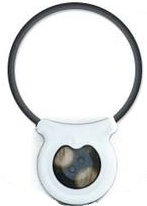 NC
State University has announced that board certified veterinary
neurologist Dr. Natasha Olby is seeking cavalier King Charles spaniels
diagnosed with CM/SM and exhibiting signs of pain and phantom scratching
for a 5-month study of the effect of pulsed electromagnetic field (PEMF)
treatments to control the pain and itching sensations. The treatments
will be delivered in the form of a PEMF loop (see image at right)
for a period of two months. Gabapentin and omeprazole also will be
provided to the dogs in the study. The sign-up period ends on November
1, 2019. For more details see
this webpage.
NC
State University has announced that board certified veterinary
neurologist Dr. Natasha Olby is seeking cavalier King Charles spaniels
diagnosed with CM/SM and exhibiting signs of pain and phantom scratching
for a 5-month study of the effect of pulsed electromagnetic field (PEMF)
treatments to control the pain and itching sensations. The treatments
will be delivered in the form of a PEMF loop (see image at right)
for a period of two months. Gabapentin and omeprazole also will be
provided to the dogs in the study. The sign-up period ends on November
1, 2019. For more details see
this webpage.
July 2019:
UK researchers find signs of pain in CM/SM-affected cavaliers
may be due to CM and not to SM.
 In a
July 2019 article, a team of UK neurology researchers (Clare
Rusbridge [right], Angus K. McFadyen, Susan P. Knower) studied the
records of 130 cavalier King Charles spaniels diagnosed with Chiari-like
malformation (CM) and some also with syringomyelia (SM) to determine
which symptoms (clinical and behavioral signs) related to CM and to SM
and to syrinx diameter, in order to use the data in future studies of
diagnosis, treatment, and genetics of CM/SM. Dogs were grouped based
upon whether they had no SM (Group 1) up to having a syrinx greater than
4 mm (Group 4).
In a
July 2019 article, a team of UK neurology researchers (Clare
Rusbridge [right], Angus K. McFadyen, Susan P. Knower) studied the
records of 130 cavalier King Charles spaniels diagnosed with Chiari-like
malformation (CM) and some also with syringomyelia (SM) to determine
which symptoms (clinical and behavioral signs) related to CM and to SM
and to syrinx diameter, in order to use the data in future studies of
diagnosis, treatment, and genetics of CM/SM. Dogs were grouped based
upon whether they had no SM (Group 1) up to having a syrinx greater than
4 mm (Group 4).
Signs found NOT RELATED to syrinx presence or size:
• Vocalization (65.4%) (except being picked up under the sternum (breastbone), which was more common among dogs with no or mild SM).
• Spinal pain -- 54.6%
• Reduced activity -- 37.7%
• Reluctance to jump or to climb stairs --35.4%
• Aversion to touch or grooming -- 30.0% (ears, head, and neck region -- 25.4%)
• Change in emotional state (more timid, anxious, withdrawn, or aggressive) -- 28.5%
• Disrupted sleep -- 22.3%
Signs found TO BE RELATED to syrinx presence or size:
• Phantom scratching -- 67% of Group 4 dogs and none in other groups
• Scratching or rubbing of the head or ears -- 28% but less common in Group 4 dogs
• Scoliosis -- 27% of Group 4 dogs and none in other groups
• Postural defects -- 15% of Group 4 dogs and none in other groups
• Weakness -- 39% of Group 4 dogs and none in other groups
The researchers stated that their findings suggest that "phantom scratching is highly unlikely with small syrinxes." They also found that among the dogs in their study, PSOM (primary secretory otitis media) is common in symptomatic CM-affected dogs and in SM-affected dogs, thereby raising the possibility of confusing the cause of some signs and behaviors, since PSOM-affected dogs tend to engage in ear-rubbing. They concluded:
"The study further suggests that SM-specific signs are phantom scratching, scoliosis, and sensory and motor signs that can be related to spinal cord damage by the syrinx and are associated with large syringes (transverse width ≥4 mm). Non-SM-specific signs include vocalization (described as without obvious trigger, when shifting position when recumbent and when being lifted under the sternum to a height), spinal pain, head and ear rubbing or scratching, aversion to touch, refusal or difficulty jumping or doing stairs, exercise intolerance/reduced activity, sleep disruption, or behavioral change described as becoming more anxious, timid, aggressive, or withdrawn. These non-SM-specific signs could reflect CM-P [CM associated pain]."
The implication from this study is, therefore, that the major signs of pain expressed by CM/SM cavaliers definitely are not due to having a syrinx and probably are due to having Chiari-like malformation, but the authors cannot definitely attribute the painful expressions solely to CM.
July 2019:
UK study finds pregabalin successfully treats neuropathic
pain due to CM/SM in symptomatic cavaliers.
 In a
July 2019 article, a team of UK researchers (Sandra Sanchis Mora
[right],
Y.M.Chang, S.M.Abeyesinghe, A.Fisher, N.Upton, H.A.Volk, L.Pelligand)
divided eight CM/SM-affected, symptomatic cavalier King Charles spaniels
into two groups -- one administered pregabalin (Lyrica) and the other with
placebo -- over 10 to 18 days and compared the results using owner
questionaire susing a numerical rating scale for pain, quantitative
sensory testing, cold latency, and blood samples. They report finding
that pregabalin-treated dogs showed:
In a
July 2019 article, a team of UK researchers (Sandra Sanchis Mora
[right],
Y.M.Chang, S.M.Abeyesinghe, A.Fisher, N.Upton, H.A.Volk, L.Pelligand)
divided eight CM/SM-affected, symptomatic cavalier King Charles spaniels
into two groups -- one administered pregabalin (Lyrica) and the other with
placebo -- over 10 to 18 days and compared the results using owner
questionaire susing a numerical rating scale for pain, quantitative
sensory testing, cold latency, and blood samples. They report finding
that pregabalin-treated dogs showed:
• improved owner-recorded daily pain scores using a numerical rating scale;
• improved mechanical hyperalgesia (measured sensitivity to pain);
• longer cold tolerance on the neck and humeri.
They concluded that, "Pregabalin was efficacious for the treatment of neuropathic pain caused by Chiari-like malformation and syringomyelia in dogs."
EDITOR'S NOTE: Pregabalin has been prescribed by neurologists to treat neuropathic pain in CM/SM-affected cavaliers for several years. See Dr. Clare Rusbridge's treatment algorithm as an example. It has been the go-to pain drug if and when gabapentin no longer is effective. Therefore, it is curious as to why at this late date, such a small study (a total of eight dogs divided into two groups) is performed, and why at least a gabapentin group was not also included in the mix. So, our question is: Why this; why now?
We suggest also including gabapentin in the study because thus far, pregabalin has been held in reserve to be resorted to once gabapentin loses its effectiveness. If milder pain relievers like gabapentin are by-passed, then the clinicians have held nothing in reserve to deal with a disorder known to be progressive, as CM/SM is.
July 2019:
Ohio State master's thesis abstract suggests von Frey
aesthesiometry (VFA) may objectively assess SM-related pain.
 In a
July 2019 abstract of a master's thesis by Ohio State veterinary
neurology student Dr. Ashley C. Hechler (right), she reports using the
von Frey
aesthesiometry (VFA) to objectively measure sensory threshold (ST)
values to quantify neuropathic pain in SM-affected cavalier King
Charles spaniels. The abstract of her unpublished thesis did not
disclose the number of affected and healthy cavaliers in the study. She
states:
In a
July 2019 abstract of a master's thesis by Ohio State veterinary
neurology student Dr. Ashley C. Hechler (right), she reports using the
von Frey
aesthesiometry (VFA) to objectively measure sensory threshold (ST)
values to quantify neuropathic pain in SM-affected cavalier King
Charles spaniels. The abstract of her unpublished thesis did not
disclose the number of affected and healthy cavaliers in the study. She
states:
"We hypothesized the SM-affected CKCS would have lower ST values consistent with hyperesthesia, when compared to control CKCS. Additionally, we hypothesized that ST values in SM-affected dogs would be inversely correlated with syrinx size on MRI and with owner-derived clinical sign scores."
She found that ST values for the thoracic and pelvic limbs differed significantly between SM-affected and control CKCS but that the ST values in SM-affected dogs did not correlate with syrinx height on MRI. Also, she found that ST values were lower in SM-affected CKCS compared to control dogs, suggesting the presence of neuropathic pain, and that cavaliers with lower ST pelvic limb values were perceived by their owners to have more severe clinical signs classically associated with SM. She concluded that the "results suggest that VFA may offer an objective assessment of neuropathic pain in SM-affected dogs and could be useful for monitoring response to therapy in future clinical studies." (See also this September 2019 ACVIM Forum abstract.)
EDITOR'S NOTE: The title of the unpublished thesis, "Identifying and Treating Neuropathic Pain in Dogs with Syringomyelia", suggests that more is included in it other than just objectively detecting and measuring neuropathic pain in cavaliers, as disclosed in the published abstract. Nonetheless, the abstract does not mention any pain due to Chiari-like malformation (CM), apart from syringomyelia (SM). We know from other current research that several signs of pain in CM/SM-affected dogs are attributable to CM and not to SM. For instance, many signs of pain or sensitivity around the head and neck are now believed to be CM-related, while signs in the limbs and paws are classified as SM-related.
Also, we do not know how many dogs were included in this study, but previous studies using the von Frey aesthesiometer (VFA) -- one including 12 cavaliers and the other consisting of 70 CKCSs -- were unable to confirm that VFA assessments could distinguish between severity levels of SM. So, Dr. Hechler's full thesis -- to be released in May 2020 -- should be of interest to many researchers for comparision purposes.
April 2019:
Study of 500 UK cavaliers treated for neurological pain shows
syringomyelia as the most common diagnosis.
 In an
April 2019 abstract at the BVASA Congress, a team of UK neurology
researchers (Katie Brown [right], Rowena Packer, Holger Volk, Clare Rusbridge)
examined the records of 500 cavalier King Charles spaniels referred to
the neurology departments at either the Royal Veterinary College
Fitzpatrick Referrals from 2013 to 2017, to determine the clinical signs
and final diagnoses and analyses made, to categorize the prevalence of
the underlying disorders. They report finding the most common clinical
findings were:
In an
April 2019 abstract at the BVASA Congress, a team of UK neurology
researchers (Katie Brown [right], Rowena Packer, Holger Volk, Clare Rusbridge)
examined the records of 500 cavalier King Charles spaniels referred to
the neurology departments at either the Royal Veterinary College
Fitzpatrick Referrals from 2013 to 2017, to determine the clinical signs
and final diagnoses and analyses made, to categorize the prevalence of
the underlying disorders. They report finding the most common clinical
findings were:
• Behavioral signs of pain: 312 cases, 62.4% prevalence
• Spinal pain: 238 cases; 47.6%
• Phantom scratching: 121 cases; 24.2%
• Gait abnormalities: 90 cases; 18.0%
The most common final diagnoses were:
• Syringomyelia: 216 cases, 43.2% prevalence.
• Orthopedic conditions: 74 cases, 14.8%
• Intervertebral disc disease (IVDD): 60 cases; 12.0%
• Chiari-like malformation pain: 56 cases; 11.2%
• Myoclonus: 19 cases; 3.8%
• Epilepsy: 18 cases; 3.6%
• Skin disease: 12 cases; 2.4%
They concluded that syringomyelia is the most prevalent neurological disease in referral practices, and emphasizes the frequency of pain associated with neurological disorders.
April 2019:
UK researchers find symptomatic CM/SM cavaliers are likely to
have more brachycephalic snouts.
 In
an
April 2019 abstract at the BVASA Congress, a team of UK neurology
researchers (Eleonore Dumas [right], Susan Penny Knowler,
Felicity Stringer, Clare Rusbridge) examined MRI scans of 66 cavalier
King Charles spaniels, including 11 without either syringomyelia (SM) or
painful Chiari-like malformation (CM-P), 15 with only CM-P, and 40 with
clinically severe CM/SM. They report finding that the SM-affected CKCSs
"had a more ventral orientation of the olfactory bulbs and shorter
distance between basicranium and hard palate." They concluded that
cavaliers with symptomatic CM/SM are more likely to have brachycephalic
snouts and "'midface' hypoplasia similar to craniosyostosis Crouzan
syndrome."
In
an
April 2019 abstract at the BVASA Congress, a team of UK neurology
researchers (Eleonore Dumas [right], Susan Penny Knowler,
Felicity Stringer, Clare Rusbridge) examined MRI scans of 66 cavalier
King Charles spaniels, including 11 without either syringomyelia (SM) or
painful Chiari-like malformation (CM-P), 15 with only CM-P, and 40 with
clinically severe CM/SM. They report finding that the SM-affected CKCSs
"had a more ventral orientation of the olfactory bulbs and shorter
distance between basicranium and hard palate." They concluded that
cavaliers with symptomatic CM/SM are more likely to have brachycephalic
snouts and "'midface' hypoplasia similar to craniosyostosis Crouzan
syndrome."
 April
2019:
Dr. Dewey is evaluating effectiveness of acupuncture in easing
CM/SM pain in cavaliers. Dr. Curtis Dewey (right),
neurologist at Cornell Univ., is conducting a study to evaluate the
effectiveness of acupuncture treatments on the thermal patterns in the
cervical region of cavalier King Charles spaniels with Chiari-like
malformation (CM) and syringomyelia. Ten CKCSs will be in each of three
groups -- one treated with dry needling acupuncture, one with
electro-acupunture, and the third a placebo group. Thermal images taken
before and after treatments will be compared. The dogs' owners will
also be asked to complete questionnaires. Details are on
this webpage.
April
2019:
Dr. Dewey is evaluating effectiveness of acupuncture in easing
CM/SM pain in cavaliers. Dr. Curtis Dewey (right),
neurologist at Cornell Univ., is conducting a study to evaluate the
effectiveness of acupuncture treatments on the thermal patterns in the
cervical region of cavalier King Charles spaniels with Chiari-like
malformation (CM) and syringomyelia. Ten CKCSs will be in each of three
groups -- one treated with dry needling acupuncture, one with
electro-acupunture, and the third a placebo group. Thermal images taken
before and after treatments will be compared. The dogs' owners will
also be asked to complete questionnaires. Details are on
this webpage.
March 2019:
Young cavalier is found to have developed Chiari-like
malformation and syringomyelia due to rare genetic osteopetrosis.
 In a
March 2019 article, a team of UK's Fitzpatrick Referrals' neurology
clinicians (Ricardo Fernandes [right], C.J. Jordan, Colin Driver)
report MRI findings of a 17-month-old male, neutered cavalier King
Charles spaniel diagnosed with osteopetrosis, a rare genetic disorder of
the growth of a puppy's bones, which also caused the development of
Chiari-like malformation (CM) and resulted in syringomyelia (SM).
Osteopetrosis (OP) (also known as "stone bone" and "chalk bone" and
"marble bone disease" and "Albers-Schonberg disease") is a rare
congentital abnormality of growth of the dog's skeleton resulting in
dense, immature bones with cores of calcified cartilage and an absence
of marrow. The dog's symptoms included occasional expressions of pain
for several months when the neck was touched, holding the neck and head
in a low, guarded position, walking disabilities evidenced by
feebleness, nausea and vomiting due to equilibrium disorders, knuckling
and dragging the paws when walking. In addition to the CM, MRI scans
revealed:
In a
March 2019 article, a team of UK's Fitzpatrick Referrals' neurology
clinicians (Ricardo Fernandes [right], C.J. Jordan, Colin Driver)
report MRI findings of a 17-month-old male, neutered cavalier King
Charles spaniel diagnosed with osteopetrosis, a rare genetic disorder of
the growth of a puppy's bones, which also caused the development of
Chiari-like malformation (CM) and resulted in syringomyelia (SM).
Osteopetrosis (OP) (also known as "stone bone" and "chalk bone" and
"marble bone disease" and "Albers-Schonberg disease") is a rare
congentital abnormality of growth of the dog's skeleton resulting in
dense, immature bones with cores of calcified cartilage and an absence
of marrow. The dog's symptoms included occasional expressions of pain
for several months when the neck was touched, holding the neck and head
in a low, guarded position, walking disabilities evidenced by
feebleness, nausea and vomiting due to equilibrium disorders, knuckling
and dragging the paws when walking. In addition to the CM, MRI scans
revealed:
• The lateral ventricles were dilated, and the forebrain was flattened.
• The occipital bone was dysplastic and was compressing the cerebellum.
• The skull base appeared abnormally shortened.
• The spinal cord was compressed by the cerebellum and appeared to be kinked.
• The skull cap was thickened.
• The bones of the skull and the vertebrae had reduced marrow space.
• Skeletal bones were markedly thickened.
• There were SM syringes extending from C2 to L4, with a maximum width of 4.8 cm.
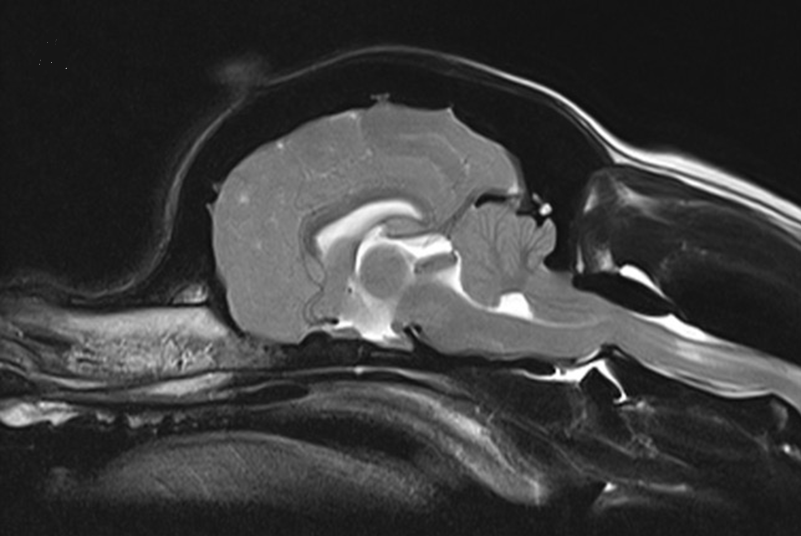 (The
MRI scan at right shows a thickened skull and compression and herniation
of the cerebellum.)
(The
MRI scan at right shows a thickened skull and compression and herniation
of the cerebellum.)
The owners declined surgical treatment, and the dog was prescribed gabapentin for the neuropathic pain and cimetidine (Zitac) to reduce cerebrospinal fluid (CSF) production. The dog responded favorably to those medications, until the dog was lost to follow-up after 10 months. The authors concluded that they believe this is the first described case of osteopetrosis causing skull thickening and consequent CM and SM. In humans, there reportedly are at least 10 genes identified in the process of osteopetrosis. Apparently no genetic study was invovled in handling this case. (See also our September 2018 article on this same clinical study.)
February 2019:
Romanian neurosurgeons successfully insert shunt in syrinx of
cavalier, to relieve CM/SM pain.
 In a
2018 article, a team of Romanian veterinary neurosurgeons (Cătălina
Anca Cucoş [right], Ateş Barut, Iuliana Ionaşcu, Radu Constantinescu, Constantin
Vlăgioiu) report surgically inserting a shunt in a syrinx of a
4-year-old cavalier King Charles spaniel suffering from severe pain and
other signs due to Chiari-like malformation and syringomyelia (CM/SM).
The dog had undergone cranio-cervical decompression surgery a year
before before, which resolved the pain symptoms for three months,
followed by progressive deterioration afterwards. For the two months
prior to the shunt surgery, the dog's symptoms included neuropathic
pain, expressed by sudden yelping, neck and spinal discomfort,
scoliosis, apathy, depression, .phantom scratching and bunny-hopping
pelvic limb gait.The
shunt was fashioned from a ventriculoperitoneal catheter (right)
which was inserted into the syrinx to allow for drainage of
cerebrospinal fluid (CSF). The syrinx was located at C3-C4 and had a
maximum internal diameter of over 2 mm. The clinicians report that the
procedure was successful and that after three years, there remains
notably decreased neuropathic pain, with the intensity and frequency of
pain attacks reduced, scratching and yelping diminished, and overall, an
increased quality of life. They conclude:
In a
2018 article, a team of Romanian veterinary neurosurgeons (Cătălina
Anca Cucoş [right], Ateş Barut, Iuliana Ionaşcu, Radu Constantinescu, Constantin
Vlăgioiu) report surgically inserting a shunt in a syrinx of a
4-year-old cavalier King Charles spaniel suffering from severe pain and
other signs due to Chiari-like malformation and syringomyelia (CM/SM).
The dog had undergone cranio-cervical decompression surgery a year
before before, which resolved the pain symptoms for three months,
followed by progressive deterioration afterwards. For the two months
prior to the shunt surgery, the dog's symptoms included neuropathic
pain, expressed by sudden yelping, neck and spinal discomfort,
scoliosis, apathy, depression, .phantom scratching and bunny-hopping
pelvic limb gait.The
shunt was fashioned from a ventriculoperitoneal catheter (right)
which was inserted into the syrinx to allow for drainage of
cerebrospinal fluid (CSF). The syrinx was located at C3-C4 and had a
maximum internal diameter of over 2 mm. The clinicians report that the
procedure was successful and that after three years, there remains
notably decreased neuropathic pain, with the intensity and frequency of
pain attacks reduced, scratching and yelping diminished, and overall, an
increased quality of life. They conclude:
"Syringosubarachnoid shunt placement represents a safe and efficient procedure, which leads to clinical improvement of the clinical signs and reestablishes the quality of life. Syringosubarachnoid shunting can be an alternative option with good results, especially in cases in which foramen magnum decompression has failed."
February 2019:
Danish researchers
find Semmes-Weinstein monofilament testing does not differ between
CM-affected CKCSs and control dogs.
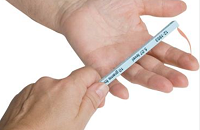 In a
In a
February 2019 article, a team of Danish neurology researchers
(M.S.Thoefner, U.Westrup, N.Toft, O.J.Bjerrum, M.Berendt) used
Semmes-Weinstein monofilament testing to determine if the cervical
(neck) mechanical sensory threshold of CM (Chiari-like-malformation)
affected cavalier King Charles spaniels (CKCS) differed from that of
CKCS control dogs. Nine affected cavaliers and eight healthy ones were included in the
study. Semmes-Weinstein monofilament testing involves placing a
In a
In a
February 2019 article, a team of Danish neurology researchers
(M.S.Thoefner, U.Westrup, N.Toft, O.J.Bjerrum, M.Berendt) used
Semmes-Weinstein monofilament testing to determine if the cervical
(neck) mechanical sensory threshold of CM (Chiari-like-malformation)
affected cavalier King Charles spaniels (CKCS) differed from that of
CKCS control dogs. Nine affected cavaliers and eight healthy ones were included in the
study. Semmes-Weinstein monofilament testing involves placing a
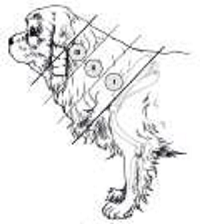 calibrated, stiff single-fiber nylon thread (see image at right) on the skin at a particular
location, to cause a measurable sensitivity response. In this case, the
thread was placed on each dog's neck and upper body in three
specific areas. (See diagram at left.) The researchers expected that the
cavaliers would react with an increased mechanical sensation by
displaying a lower sensory threshold to the monofilament than the
control dogs. Contrary to their expectations, the researchers found that
the mean mechanical sensory threshold of the cavaliers and the controls
was not significantly different. They therefore concluded:
calibrated, stiff single-fiber nylon thread (see image at right) on the skin at a particular
location, to cause a measurable sensitivity response. In this case, the
thread was placed on each dog's neck and upper body in three
specific areas. (See diagram at left.) The researchers expected that the
cavaliers would react with an increased mechanical sensation by
displaying a lower sensory threshold to the monofilament than the
control dogs. Contrary to their expectations, the researchers found that
the mean mechanical sensory threshold of the cavaliers and the controls
was not significantly different. They therefore concluded:
"The assessment of sensory function in dogs with assumed central neuropathic pain should be multimodal and include not only mechanical but also tactile and thermal threshold quantification."
January 2019:
Computed tomography is used to diagnose Chiari-like
malformation, syringomyelia, and occipital hypoplasia in a 21-month-old
cavalier.
 In
a
December 2018 article, a team of Romanian and German researchers
(Robert Cristian Purdoiu [right], Ondreka, N., Kiss, T.,
Popovici, C., Papuc, I., Danciu, C. G., Lazar, A. C., Lacatus, R.) used
computed tomography (CT) to diagnose Chiari-like malformation (CM),
syringomyelia (SM), and occiptial hypoplasia in a 21-month-old female
cavalier King Charles spaniel. Symptoms consisted of discomfort at the
level of the right ear, scratching, and pain, reluctance to take long
walks, and greater signs when the air pressure changed. CT showed a typical brachycephalic head conformation,
shortened facial bones, and a dome shaped calvarium. The supraoccipital
bone was short and stunted, and the foramen magnum appeared enlarged,
with part of the cerebellar vermis protruding. Evidence of a syrinx was
observed in the spinal cord a C2. Changes of the occipital bone showed
occipital hypoplasia with incomplete formation of the bone (Fig. 6,
below). They concluded that: "In absence of MRI examination, the CT
examination represent an alternative in diagnosing this pathology."
In
a
December 2018 article, a team of Romanian and German researchers
(Robert Cristian Purdoiu [right], Ondreka, N., Kiss, T.,
Popovici, C., Papuc, I., Danciu, C. G., Lazar, A. C., Lacatus, R.) used
computed tomography (CT) to diagnose Chiari-like malformation (CM),
syringomyelia (SM), and occiptial hypoplasia in a 21-month-old female
cavalier King Charles spaniel. Symptoms consisted of discomfort at the
level of the right ear, scratching, and pain, reluctance to take long
walks, and greater signs when the air pressure changed. CT showed a typical brachycephalic head conformation,
shortened facial bones, and a dome shaped calvarium. The supraoccipital
bone was short and stunted, and the foramen magnum appeared enlarged,
with part of the cerebellar vermis protruding. Evidence of a syrinx was
observed in the spinal cord a C2. Changes of the occipital bone showed
occipital hypoplasia with incomplete formation of the bone (Fig. 6,
below). They concluded that: "In absence of MRI examination, the CT
examination represent an alternative in diagnosing this pathology."
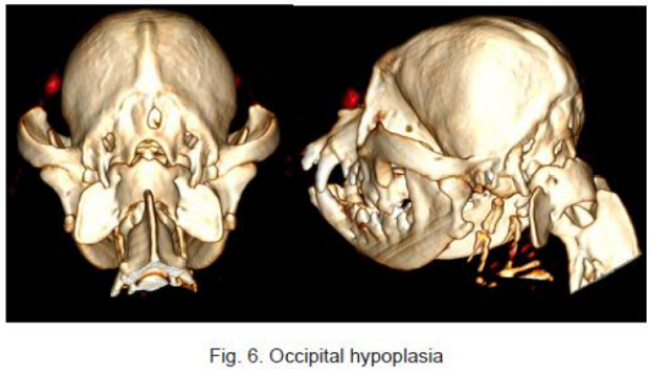
January 2019: Pilot study finds that cavalier head shape evaluations by breed experts can detect the risk of syringomyelia. In a January 2019 article by a team of UK and Swedish researchers (Susan Penelope Knowler, Lena Gillstedt, Thomas J Mitchell, Jelena Jovanovik, Holger Andreas Volk, Clare Rusbridge), 13 cavalier King Charles spaniels were examined by UK breed judges, using a checklist, to determine if the risk of Chiari-like malformation (CM) and syringomyelia (SM) could be identified by visual assessment of head shape. The results showed a positive correlation between the judges' evaluations and the risk of CM/SM sufficient to warrant a larger study of the breed. Figure 5 (below) shows the most extreme range of checklist scores. The researchers concluded:
"This prospective investigation demonstrated that it was possible to compare subjective evaluation of head conformation with objective measurements and revealed a significant correlation between the subjective visual evaluation of head conformation and an objective evaluation of dorsoventral doming using photographs. However, this pilot investigation demonstrated that individual adjudicators can vary in their interpretation of the CKCS breed type and also suggests that measuring the cephalic index or rostrocaudal doming alone is not a reliable indicator of brachycephaly but should be taken together with a visual evaluation and take account of other features, such as those on the checklist and the size of the dog."
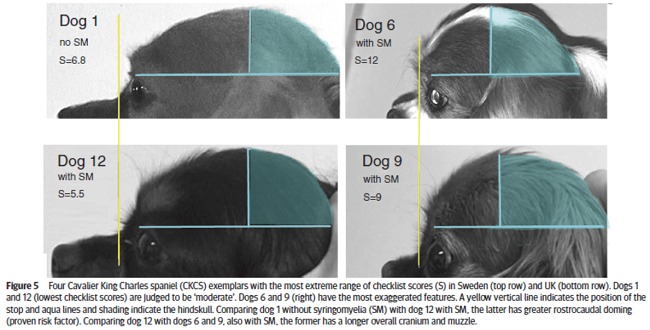
January 2019:
Dr. Rusbridge revises the CM/SM Treatment Algorithm.
 In January 2019, UK veterinary neurologist Dr. Clare Rusbridge
(right), a leading researcher into Chiari-like malformation (CM)
and syringomyelia (SM) in cavaliers, has published
a revision to her treatment recommendations for CM and SM.
Significant changes include making it clear that CM is the cause of pain
expressed by affected dogs. She also lists additional drugs to be
considered when gabapentin and its substitute, pregabalin, fail to
relieve CM-caused pain. She emphasizes that corticosteroids should be
considered only as a "last resort" in treating symptoms due to SM (such
as, phantom scratching, weakness, and postural disabilities). Finally,
she questions the advisability of treating with cannabinoids.
In January 2019, UK veterinary neurologist Dr. Clare Rusbridge
(right), a leading researcher into Chiari-like malformation (CM)
and syringomyelia (SM) in cavaliers, has published
a revision to her treatment recommendations for CM and SM.
Significant changes include making it clear that CM is the cause of pain
expressed by affected dogs. She also lists additional drugs to be
considered when gabapentin and its substitute, pregabalin, fail to
relieve CM-caused pain. She emphasizes that corticosteroids should be
considered only as a "last resort" in treating symptoms due to SM (such
as, phantom scratching, weakness, and postural disabilities). Finally,
she questions the advisability of treating with cannabinoids.
Dr. Rusbridge also has revised the Frequently Asked Questions (FAQs) page of her website. Her FAQs cover all aspecs of CM and SM, from symptoms, diagnosis, progression, prognosis, medical treatment, surgery, breeding protocols, and prevention.
RETURN TO TOP
2018 News
November 2018: Drs. Rusbridge and Knowler review the current knowledge for diagnosis of symptomatic Chiari-like malformation and syringomyelia. In a November 2018 article, Drs. Clare Rusbridge and Susan P. Knowler and Felicity Stringer have thoroughly summarized the current research knowledge about symptomatic Chiari-like malformation (CM) and syringomyelia (SM) in cavalier King Charles spaniels and other affected breeds. Their work includes handy charts covering the topics of skull changes, craniocervical junction and cervical changes, neuroparenchymal changes, syrinx features, MRI protocols, and interpretations of MRI scans for diagnosing CM pain and symptomatic SM. They also have comparison MRI scan views of cavaliers with varying stages of CM and SM, including Figure 8, below, comparing the MRI scans of three CKCSs.
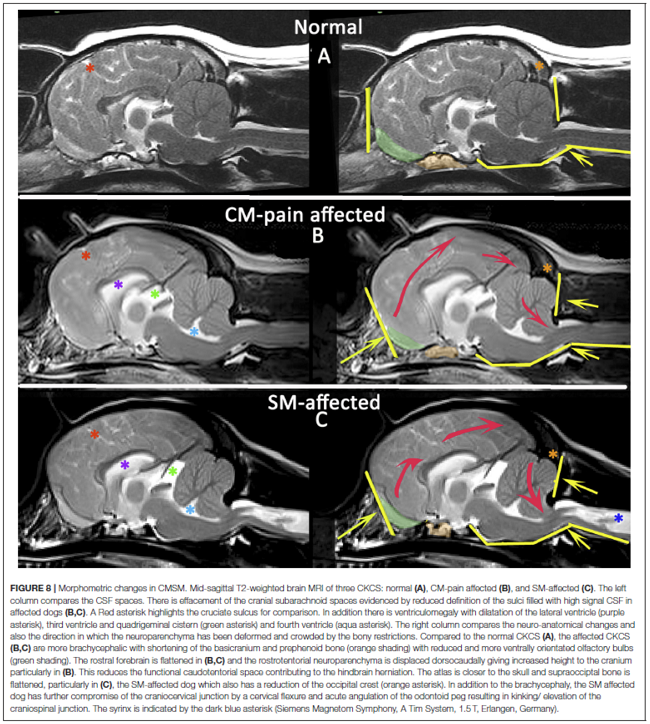
EDITOR'S NOTE: This article is majorly important and quickly ought to become the guidebook for diagnosing CM and CM/SM and the resultant pain in cavalier King Charles spaniels (CKCS) and other affected breeds of dogs. Its tables and charts are designed to quickly educate even the least aware of general practice veterinarians and get them up-to-speed on the current knowledge about these widespread disorders in, especially, the CKCS. It has been troubling for us to find that even some board certified veterinary neurologists do not know that dogs can suffer severe pain just from CM and without any syrinxes at all. Hopefully, they will download, read, and save copies of this article for frequent future reference.
September 2018:
Young cavalier is diagnosed with osteopetrosis which may have
led to CM/SM.
 In a
September 2018 abstract, UK investigators (Ricardo Fernandes
[right], Chris
Jordan, Joana Tabanez, Jeremy Rose, Clare Rusbridge, Colin Driver)
evaluated an 18-month old cavalier King Charles spaniel which had
symptoms of "cervical hyperesthesia" (holding the neck and head in a
low, guarded position). Upon MRI examination and x-rays, they found that
the skull was thickened and that neither the skull nor veterbrae
contained bone marrow, which they described as osteopetrosis*. The dog
also had severe Chiari-like malformation and an SM syrinx with a width
of 4.8mm. They stated:
In a
September 2018 abstract, UK investigators (Ricardo Fernandes
[right], Chris
Jordan, Joana Tabanez, Jeremy Rose, Clare Rusbridge, Colin Driver)
evaluated an 18-month old cavalier King Charles spaniel which had
symptoms of "cervical hyperesthesia" (holding the neck and head in a
low, guarded position). Upon MRI examination and x-rays, they found that
the skull was thickened and that neither the skull nor veterbrae
contained bone marrow, which they described as osteopetrosis*. The dog
also had severe Chiari-like malformation and an SM syrinx with a width
of 4.8mm. They stated:
"We hypothesise that a mass effect from the calvarial [skull] thickening leads to reduced volume of the caudal fossa and cerebellar herniation. The absence of osteoclastic activity may lead to abnormal growth of the occipital bone resulting in a smaller caudal fossa. This is the first case report where MR findings in a patient with osteopetrosis associated with Chiari-like malformation are described in veterinary medicine."
* Osteopetrosis (also known as "stone bone" and "chalk bone" and "marble bone disease" and "Albers-Schonberg disease") is a rare congentital abnormality of growth of the dog's skeleton resulting in dense, immature bones with cores of calcified cartilage and an absence of marrow.
September 2018:
Dr. Rusbridge reports on signs of pain and other symptoms of
SM/SM-affected cavaliers of varying degrees of severity.
 In an
April 2018 abstract, UK veterinary neurologist Dr. Clare Rusbridge
(right)
compared CM/SM severity with signs of pain and other symptoms in 101
cavalier King Charles spaniels. The dogs were divided into four
categories:
In an
April 2018 abstract, UK veterinary neurologist Dr. Clare Rusbridge
(right)
compared CM/SM severity with signs of pain and other symptoms in 101
cavalier King Charles spaniels. The dogs were divided into four
categories:
• 16 CKCSs with no SM (SM Grade 0)
• 12 CKCSs with central canal dilation (CCD) less than 2 mm (SM Grade 1)
• 23 CKCSs with CCD between 2 and 3.9 mm (SM Grade 2)
• 50 CKCSs with CCD over 4 mm.
She reports that the most common signs were: (a) vocalization, either spontaneous or upon changing head position, upon rising, or when lifting dog from under the sternum; (b) scratching/rubbing the head/ears; (c) unwilling or difficulty jumping/doing stairs; (d) hyper-sensitivity to palpation of the cervical, thoracic, and/or lumbar spine; (e) decreased exercise ability; (f) lethargy; and (g) sleep disturbance. Phantom scratching, scoliosis, weakness, and postural deficits were only seen in the SM ≥4 mm group. She concluded:
"This study has limitations due to its retrospective nature but provides data for planning future clinical trials. Results suggest CM with or without SM may present with behavioural signs of pain particularly associated with changes in head position. Dogs may scratch or rub their head/ears and examination may suggest spinal hyperaesthesia. SM specific signs tend to be associated with larger syringes and likely damage of the spinal cord."
September 2018:
UK neurologists compare interneuron differences in the dorsal
horns of SM-affected cavaliers to determine the cause of phantom
scratching. In an
April 2018 abstract, a team of UK neurologists (Zoë Nalborczyk
[right], Javier Salguero, Fernando
 Constantino-Casas,
Penny Watson, Clare Rusbridge) examined four groups of cavalier King
Charles spaniels in an attempt to relate interneuron differences in the
dorsal horns of the middle cervical spinal cord segments with the common
syringomyelia symptom of phantom scratching.The four groups consisted
of: (1) symptomatic SM-affected CKCSs with phantom scratching; (2)
symptomatic SM-affected CKCSs without phantom scratching; (3)
asymptomatic SM-affected CKCSs; and (4) CKSCs with neither SM nor
phantom scratching. They report finding that the scratchers had
significantly larger central cavities than did the non-scratchers. They
found significant differences in the distribution of inhibitory
interneurons in the left and right dorsal horn of the spinal cord
between the four groups. They concluded that there appear to be
"differences in the number of inhibitory interneurons in one or more
laminae of the left and right dorsal horn between cohorts but does not
identify in which lamina(e) the differences lie", and that "further
analysis and methodology alteration are required to grasp the true
significance of these results in relation to the development of phantom
scratching in dogs with severe syringomyelia."
Constantino-Casas,
Penny Watson, Clare Rusbridge) examined four groups of cavalier King
Charles spaniels in an attempt to relate interneuron differences in the
dorsal horns of the middle cervical spinal cord segments with the common
syringomyelia symptom of phantom scratching.The four groups consisted
of: (1) symptomatic SM-affected CKCSs with phantom scratching; (2)
symptomatic SM-affected CKCSs without phantom scratching; (3)
asymptomatic SM-affected CKCSs; and (4) CKSCs with neither SM nor
phantom scratching. They report finding that the scratchers had
significantly larger central cavities than did the non-scratchers. They
found significant differences in the distribution of inhibitory
interneurons in the left and right dorsal horn of the spinal cord
between the four groups. They concluded that there appear to be
"differences in the number of inhibitory interneurons in one or more
laminae of the left and right dorsal horn between cohorts but does not
identify in which lamina(e) the differences lie", and that "further
analysis and methodology alteration are required to grasp the true
significance of these results in relation to the development of phantom
scratching in dogs with severe syringomyelia."
August 2018:
Romanian neurologists report on clinical signs of 37 cavaliers
diagnosed with CM/SM.
 In an
August 2018 abstract, a team of Romanian neurology researchers
(Cătălina Anca Cucoș, Radu Constantinescu, Ateș Barut, Iuliana Ionașcu,
Constantin Vlăgioiu) report examining 37 cavalier King Charles spaniels
diagnosed with Chiari-like malformation and syringomyelia (CM/SM) by a
full neurological examination and work-up, including magnetic resonance
imaging (MRI). They report finding that all affected CKCSs had
neurolpathic pain and also cerebellar herniation and syrinxes. They list
the percentages of clinical findings:
In an
August 2018 abstract, a team of Romanian neurology researchers
(Cătălina Anca Cucoș, Radu Constantinescu, Ateș Barut, Iuliana Ionașcu,
Constantin Vlăgioiu) report examining 37 cavalier King Charles spaniels
diagnosed with Chiari-like malformation and syringomyelia (CM/SM) by a
full neurological examination and work-up, including magnetic resonance
imaging (MRI). They report finding that all affected CKCSs had
neurolpathic pain and also cerebellar herniation and syrinxes. They list
the percentages of clinical findings:
• Neurolpathic pain and vocalization (100%)
• Scratching (82%)
• Facial rubbing (29.7%)
• Paw licking (10.6%)
• Seizures (2.7%)
• Unilateral facial paralysis (2.7%).
The MRI scans showed:
• Cerebellar herniation and syrinxes (100%)
• Medullary kinking (89.2%)
• Pre-syrinx -- spinal cord edema (51.3%)
• Ventriculomegaly (22.6%).
See also this July 2018 article by the same team of investigators and same CKCSs.
July 2018: Dr. Knowler defines Chiari-like malformation and syringomyelia based upon 20+ years of research. In a July 2018 article, Dr. Susan (Penny) Knowler (and Gabriel L. Galea, Clare Rusbridge) reviews over 20 years of neurological research into the conditions of Chiari-like malformation (CM) and syringomyelia (SM) primarily in cavalier King Charles spaniels (CKSC) and a few other brachcyphalic breeds. She covers the key morphocenetic processes involved in CM/SM, including (a) anatomical abnormalities, (b) brachycephaly, (c)cranio-cervical junction abnormalities, (e) embryology (fetal development), (f) the brain and ventricles, (g) the skull, and (h) genetics of CM. She provides a current defintion of CM as:
"a malformation of the skull and craniocervical junction which compromises the neural parenchyma to cause pain and/or disrupt CSF circulation which can result in SM."
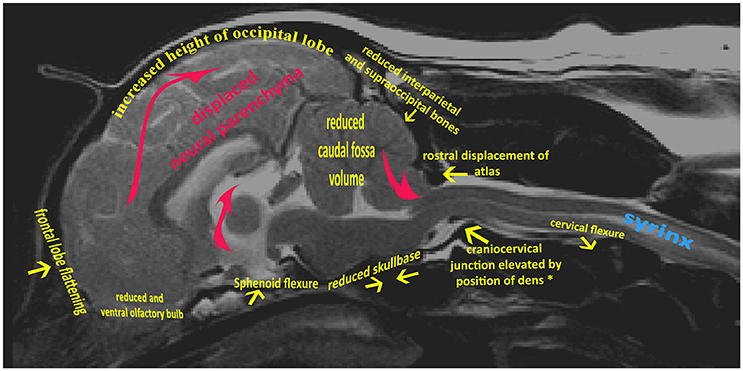 Figure 1 (above) is an MRI scan of a CKCS with CM and SM. Yellow arrows indicate generalized skeletal variances from a normal CKCS skull and cervical junction. Red arrows indicate displaced neural parenchyma.
Figure 1 (above) is an MRI scan of a CKCS with CM and SM. Yellow arrows indicate generalized skeletal variances from a normal CKCS skull and cervical junction. Red arrows indicate displaced neural parenchyma.
She concludes:
"Understanding the developmental origins of complex three dimensional structures of the brain, skull, craniocervical junction and spinal cord with associated ventricles and CSF channels, is crucial to understanding canine CM and ultimately the pathogenesis of SM. ... The importance of accurate phenotyping has been fundamental for genetic studies of CM, but it is also the key for accurate diagnosis. The complexity of the existing morphometrics involved in the current phenotypes make them impractical for everyday use and a machine learning technique for diagnosis that removes human bias has been suggested. Pilot studies in this technology has identified biomarkers in structures such as the soft palate not previously associated with these conditions that when investigated may give further insight into conformation change. Mathematical modeling has also been applied to the dynamics associated with CSF flow which might be used to predict the outcome following different surgical approaches. The challenge of quantifying and interpreting intermittent and variable clinical signs for a complex trait such as CM/SM cannot be overstated. More investigation is required to defining the pathology of symptomatic CM and its relationship with brachycephaly and miniaturization."
June 2018:
UK researchers find that SM-affected cavaliers have frontal flattening of their skulls.
 In
a
June 2018 abstract presented to the 2018 ACVIM Forum, UK researchers
(S.P. Knowler [right], M. Spiteri, A.K. McFadyen, F. Stringer,
K. Wells, C. Rusbridge) relied upon an innovative machine learning
technique (a computerized data analytics technique using computational
methods to learn information from data without relying on a
predetermined equation as a model). The team obtained MRI scans of 66
cavalier King Charles spaniels (CKCSs) over the age of 4 years. Of them,
26 did not have syringomyelia (SM) and 40 had SM with a syrinx width of
at least 4 mm. They performed morphometric analysis of the shape and
position of the soft palate in relation to the skull base and the
rostral (towards the oral or nasal region) flattening of the forebrain.
In the SM dogs, the distance between the rostral (again, towards the
oral or nasal region) end of the soft palate and (a) the sella turcica
(a saddle-shaped depression in the body of the sphenoid bone of the
human skull, where the pituitary gland sits), and (b) the foramen magnum
basioccipital portion of occipital bone, was significantly shorter than
the non-SM control group of dogs. The shorter distance between the brain
and the frontal bone also was highly significant in SM-affected dogs.
They concluded that CKCSs with SM have a flattening of the frontal
portion of their skulls, when compared to
non-SM cavaliers.
In
a
June 2018 abstract presented to the 2018 ACVIM Forum, UK researchers
(S.P. Knowler [right], M. Spiteri, A.K. McFadyen, F. Stringer,
K. Wells, C. Rusbridge) relied upon an innovative machine learning
technique (a computerized data analytics technique using computational
methods to learn information from data without relying on a
predetermined equation as a model). The team obtained MRI scans of 66
cavalier King Charles spaniels (CKCSs) over the age of 4 years. Of them,
26 did not have syringomyelia (SM) and 40 had SM with a syrinx width of
at least 4 mm. They performed morphometric analysis of the shape and
position of the soft palate in relation to the skull base and the
rostral (towards the oral or nasal region) flattening of the forebrain.
In the SM dogs, the distance between the rostral (again, towards the
oral or nasal region) end of the soft palate and (a) the sella turcica
(a saddle-shaped depression in the body of the sphenoid bone of the
human skull, where the pituitary gland sits), and (b) the foramen magnum
basioccipital portion of occipital bone, was significantly shorter than
the non-SM control group of dogs. The shorter distance between the brain
and the frontal bone also was highly significant in SM-affected dogs.
They concluded that CKCSs with SM have a flattening of the frontal
portion of their skulls, when compared to
non-SM cavaliers.
June 2018:
German neurologists find 48% of 339 asymptomatic cavaliers have
syringomyelia.
 In a
June 2018 article, a team of German veterinary neurologists (Sabine
Schulze [right], Miriam Refai, Martin Deutschland, Klaus
Failing, Martin Schmidt) examined
the MRI scans of 339 German cavalier King Charles spaniels which were
scanned from 2006 to 2016 for Chiari-like malformation / syringomyelia
(CM/SM). None of those dogs displayed any symptoms of SM. Their ages
ranged from 3 months to 11 years. They found that 163 of the 339 dogs
(48.1%) showed evidence of SM, and that the risk of developing SM
increases with age. They concluded:
In a
June 2018 article, a team of German veterinary neurologists (Sabine
Schulze [right], Miriam Refai, Martin Deutschland, Klaus
Failing, Martin Schmidt) examined
the MRI scans of 339 German cavalier King Charles spaniels which were
scanned from 2006 to 2016 for Chiari-like malformation / syringomyelia
(CM/SM). None of those dogs displayed any symptoms of SM. Their ages
ranged from 3 months to 11 years. They found that 163 of the 339 dogs
(48.1%) showed evidence of SM, and that the risk of developing SM
increases with age. They concluded:
"In conclusion, around half of the dogs within the German CKCS population are affected by syringomyelia. The prevalence of syringomyelia of the German CKCS population is similar to that of the British CKCS population, which is subjected to breeding strategies on the basis of magnetic resonance imaging investigations."
June 2018:
NCSU student studies 48 cavaliers and finds their spinal cords
terminate lower than 41 control dogs.
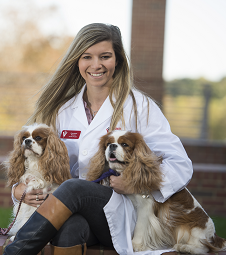 North
Carolina State University veterinary student Courtney Sparks (right)
reports in a
June 2018 abstract presented at the 2018 ACVIM Forum, on a study of
the analysis of the location of the terminus of the spinal cord in 48
cavalier King Charles spaniels. She compared the 48 cavaliers with 21
dogs of other brachycephalic breeds and 20 non-brachycephalic control
dogs. In an effort to explain the pain suffered by CKCSs affected with
Chiari-like malformation and syringomyelia, she and her team
hypothesized that their spinal cords terminates lower along the spinal
column than in the other breeds. Using MRI scans, of the CKCSs' spinal
cords, only 3 terminated at vertebra L6, 23 terminated at L7, and 22
terminated at the sacrum; whereas of the 41 control dogs, 8 terminated
at L6, 27 at L7, and only 5 at the sacrum.
North
Carolina State University veterinary student Courtney Sparks (right)
reports in a
June 2018 abstract presented at the 2018 ACVIM Forum, on a study of
the analysis of the location of the terminus of the spinal cord in 48
cavalier King Charles spaniels. She compared the 48 cavaliers with 21
dogs of other brachycephalic breeds and 20 non-brachycephalic control
dogs. In an effort to explain the pain suffered by CKCSs affected with
Chiari-like malformation and syringomyelia, she and her team
hypothesized that their spinal cords terminates lower along the spinal
column than in the other breeds. Using MRI scans, of the CKCSs' spinal
cords, only 3 terminated at vertebra L6, 23 terminated at L7, and 22
terminated at the sacrum; whereas of the 41 control dogs, 8 terminated
at L6, 27 at L7, and only 5 at the sacrum.
May 2018:
Ohio State researchers use von Frey anesthesiometer on 16
cavaliers to compare pain sensory thresholds in CKCSs with and without
SM.
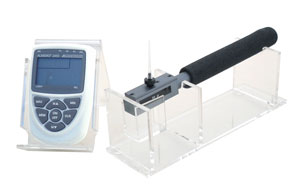 In
a
May 2018 abstract presented at the November 2017 "Pain in Animals"
Workshop, Ohio State University researchers (S. A. Moore, E. T. Hostnik,
L. Cole) examined 16 cavalier King Charles spaniels (CKCSs) -- 9 without
syringomyelia (SM) and 7 with SM -- using an electronic von Frey
anesthesiometer (see photo at right) to determine if there are
any the dogs' mechanical sensory thresholds (ST) for pain, and if so, to
measure those differences. They report finding that there was a
significant decrease in ST in the pelvic (hind) limbs of SM-affected
CKCSs compared with normal cavaliers. They also reported a similar
relationship in the thoracic (fore) limbs but did not achieve
statistical significance).
In
a
May 2018 abstract presented at the November 2017 "Pain in Animals"
Workshop, Ohio State University researchers (S. A. Moore, E. T. Hostnik,
L. Cole) examined 16 cavalier King Charles spaniels (CKCSs) -- 9 without
syringomyelia (SM) and 7 with SM -- using an electronic von Frey
anesthesiometer (see photo at right) to determine if there are
any the dogs' mechanical sensory thresholds (ST) for pain, and if so, to
measure those differences. They report finding that there was a
significant decrease in ST in the pelvic (hind) limbs of SM-affected
CKCSs compared with normal cavaliers. They also reported a similar
relationship in the thoracic (fore) limbs but did not achieve
statistical significance).
May 2018:
NC State researchers study 54 cavaliers to determine if
SM-affected CKCSs have lower sensory thresholds.  In
a
May 2018 abstract presented at the November 2017 "Pain in Animals"
Workshop, North Carolina State researchers (C. R. Sparks, A. Gorney, K.
Williams, B. Duncan X. Lascelles [right], N. J. Olby) studied
54 cavalier King Charles spaniels (CKCSs) -- 34 diagnosed by MRI as
having Chiari-like malformation / syringomyelia (CM/SM) and 20 not -- to
compare data on thermal and mechanical thresholds of dogs with and
without CM/SM. Of the 54 dogs: 24 were classified by their owners as
being in pain; 33 had scratching signs; 40 were painful when examined by
the researchers; and 34 had CM/SM. The researchers report finding "no
significant difference in sensory thresholds between dogs with and
without SM."
In
a
May 2018 abstract presented at the November 2017 "Pain in Animals"
Workshop, North Carolina State researchers (C. R. Sparks, A. Gorney, K.
Williams, B. Duncan X. Lascelles [right], N. J. Olby) studied
54 cavalier King Charles spaniels (CKCSs) -- 34 diagnosed by MRI as
having Chiari-like malformation / syringomyelia (CM/SM) and 20 not -- to
compare data on thermal and mechanical thresholds of dogs with and
without CM/SM. Of the 54 dogs: 24 were classified by their owners as
being in pain; 33 had scratching signs; 40 were painful when examined by
the researchers; and 34 had CM/SM. The researchers report finding "no
significant difference in sensory thresholds between dogs with and
without SM."
March 2018:
Canadian and UK researchers locate two possible genes related to
CM/SM syrinxes in cavaliers.
 In
a
March 2018 article, a team of researchers from the UK and Canada
(Frédéric Ancot, Philippe Lemay, Susan P. Knowler, Karen Kennedy, Sandra
Griffiths, Giunio Bruto Cherubini, Jane Sykes, Paul J. J. Mandigers, Guy
A. Rouleau, Clare Rusbridge, Zoha Kibar [right]) examined DNA
samples from 65 cavalier King Charles spaniels and narrowed down the
likely potential "candidate" genes for CM/SM to PCDH17 in CFA22 (Canis
Familiaris Autosome) and ZWINT in CFA26. They used MRI scans of the
craniums of affected and normal CKCS to compare size and shape
measurements of regions of the brains, to identify lines and angles
associated with sizes of syrinx diameters. The PCDH17 gene is involved
in the adhesion and sorting of cells in the brain and spinal cord during
tissue development. They speculate that the ZWINT gene may be related to
neuropathic pain, but this study did not detect any such association.
They conclude by calling for additional studies in larger numbers of
cavaliers and other affected brachycephalic breeds to investigate the
role of the two associated loci and the genes in the pathogenesis of
CM/SM.
In
a
March 2018 article, a team of researchers from the UK and Canada
(Frédéric Ancot, Philippe Lemay, Susan P. Knowler, Karen Kennedy, Sandra
Griffiths, Giunio Bruto Cherubini, Jane Sykes, Paul J. J. Mandigers, Guy
A. Rouleau, Clare Rusbridge, Zoha Kibar [right]) examined DNA
samples from 65 cavalier King Charles spaniels and narrowed down the
likely potential "candidate" genes for CM/SM to PCDH17 in CFA22 (Canis
Familiaris Autosome) and ZWINT in CFA26. They used MRI scans of the
craniums of affected and normal CKCS to compare size and shape
measurements of regions of the brains, to identify lines and angles
associated with sizes of syrinx diameters. The PCDH17 gene is involved
in the adhesion and sorting of cells in the brain and spinal cord during
tissue development. They speculate that the ZWINT gene may be related to
neuropathic pain, but this study did not detect any such association.
They conclude by calling for additional studies in larger numbers of
cavaliers and other affected brachycephalic breeds to investigate the
role of the two associated loci and the genes in the pathogenesis of
CM/SM.
March 2018:
UK researchers use computer models of SM-affected cavalier
spinal cavity to test theories of causes of syrinxes.
 In a
March
2018 article, a team of UK neurological researchers (Srdjan Cirovic
[right],
Robert Lloyd, Jelena Jovanovik, Holger A. Volk, Clare Rusbridge) created
a computer model of the spinal cavity of a cavalier King Charles spaniel
suffering from a large syrinx due to Chiari-like malformation and
syringomyelia (CM/SM). The purpose was to simulate movement caused by
the flow of cerebrospinal fluid (CSF). When the CSF was blocked, the
spinal cord was forced to move with the heart beat, and stresses on the
cord were found to increase significantly at sites were syrinxes
typically form, but at the edges rather than at the central portion of
the cord. The elevated stress was found to originate due to bending of
the cord where its curvature was highest. They concluded that:
In a
March
2018 article, a team of UK neurological researchers (Srdjan Cirovic
[right],
Robert Lloyd, Jelena Jovanovik, Holger A. Volk, Clare Rusbridge) created
a computer model of the spinal cavity of a cavalier King Charles spaniel
suffering from a large syrinx due to Chiari-like malformation and
syringomyelia (CM/SM). The purpose was to simulate movement caused by
the flow of cerebrospinal fluid (CSF). When the CSF was blocked, the
spinal cord was forced to move with the heart beat, and stresses on the
cord were found to increase significantly at sites were syrinxes
typically form, but at the edges rather than at the central portion of
the cord. The elevated stress was found to originate due to bending of
the cord where its curvature was highest. They concluded that:
"The results suggest that it is possible that repetitive stressing of the spinal cord caused by its exaggerated movement could be a cause for the formation of initial syringes. Further consideration of factors such as cord tethering and the difference in mechanical properties of white and grey matter is needed to fully explore this possibility."
January 2018:
Korean surgeons successfully use Lyoplant as a collagen implant
dural substitute in foramen magnum decompression surgery.
 In
a
December 2017 article, a team of Korean veterinary surgeons
(Wan-Sang Park, SungHun Kang, Jun-Su Kim, Sung-Guon Park, Hee-Sup Moon,
Sang-yeon Kim, Sung-Jin Hong, Tae-Sung Hwang, Hee-Chun Lee, Yong-Hyun
Hwang, Hyun Park, Jae-Hoon Lee [right]) report the successful
grafting of Lyoplant, a pure collagen implant that is produced from
bovine pericardium, as a substitute for the portion of the brain's dura
removed during foramen magnum decompression surgery of a Maltese dog
diagnosed with caudal occipital malformation syndrome (COMS) also known
as Chiari-like malformation, and syringomyelia. They conclude that
"surgical decompression with Lyoplant was an effective long-term
(12-month) treatment for COMS without the need for any pharmacological
treatment."
In
a
December 2017 article, a team of Korean veterinary surgeons
(Wan-Sang Park, SungHun Kang, Jun-Su Kim, Sung-Guon Park, Hee-Sup Moon,
Sang-yeon Kim, Sung-Jin Hong, Tae-Sung Hwang, Hee-Chun Lee, Yong-Hyun
Hwang, Hyun Park, Jae-Hoon Lee [right]) report the successful
grafting of Lyoplant, a pure collagen implant that is produced from
bovine pericardium, as a substitute for the portion of the brain's dura
removed during foramen magnum decompression surgery of a Maltese dog
diagnosed with caudal occipital malformation syndrome (COMS) also known
as Chiari-like malformation, and syringomyelia. They conclude that
"surgical decompression with Lyoplant was an effective long-term
(12-month) treatment for COMS without the need for any pharmacological
treatment."
January 2018:
Belgian questionnaire study of 114 CKCS owners shows they are
most concerned about MVD and CM/SM in selecting dogs.
 In
a
January 2018 study by Belgian investigators (Katrien Wijnrocx,
Liesbeth François, Peter Goos, Nadine Buys, Steven Janssens [right]),
they conducted a on-line Internet questionnaire study about the
attitudes of breeders and owners of cavalier King Charles spaniels in
the importance they attach to health (syringomyelia and mitral valve
disease) and conformation traits in the selection of a CKCS. The study
originated as a response to a recently invoked law that will oblige
Flemish CKCS breeders to screen their dogs prior to breeding. Residents
of Belgium, Denmark, the UK and the USA participated, the total number
being 114, of which 90% were female. The study results showed no
difference in preference between breeders or owners, and that they both
attached most importance to the health traits such as SM and MVD,
followed by eye shape and level of inbreeding. The 17-section
questionnaire topics included: shape of the eyes (choices: walleyed,
small, prominent), coat colour, muzzle length, level of inbreeding,
purchase price of the dog, syringomyelia status (choices: not tested,
tested and clinical symptoms present, and tested and free), eye disease
status (choices: not tested, tested and clinical symptoms present, and
tested and free), and mitral valve disease status (choices: not tested,
tested and clinical symptoms present, and tested and free).
In
a
January 2018 study by Belgian investigators (Katrien Wijnrocx,
Liesbeth François, Peter Goos, Nadine Buys, Steven Janssens [right]),
they conducted a on-line Internet questionnaire study about the
attitudes of breeders and owners of cavalier King Charles spaniels in
the importance they attach to health (syringomyelia and mitral valve
disease) and conformation traits in the selection of a CKCS. The study
originated as a response to a recently invoked law that will oblige
Flemish CKCS breeders to screen their dogs prior to breeding. Residents
of Belgium, Denmark, the UK and the USA participated, the total number
being 114, of which 90% were female. The study results showed no
difference in preference between breeders or owners, and that they both
attached most importance to the health traits such as SM and MVD,
followed by eye shape and level of inbreeding. The 17-section
questionnaire topics included: shape of the eyes (choices: walleyed,
small, prominent), coat colour, muzzle length, level of inbreeding,
purchase price of the dog, syringomyelia status (choices: not tested,
tested and clinical symptoms present, and tested and free), eye disease
status (choices: not tested, tested and clinical symptoms present, and
tested and free), and mitral valve disease status (choices: not tested,
tested and clinical symptoms present, and tested and free).
RETURN TO TOP
2017 News
December 2017: UK researchers find significant correlations using flexed-neck position MRI scans of cavaliers and other brachycephalic dogs with and without Chiari-like malformation. In a December 2017 article, a team of UK's Royal (Dick) School of Veterinary Studies neurologists (Caroline R. Gordon, K. Marioni-Henry, P. Amengual, T. Liuti) studied various measurements taken from MRI scans of two groups of brachycephalic dogs -- 20 with Chiari-like malformation (CM) including 15 cavalier King Charles spaniels, and 10 without CM including 1 CKCS -- all in the flexed-neck position. They report finding:
• The distance from the planum of the foramen magnum to the pons was significantly reduced, providing evidence of craniocephalic disproportion similar to human patients with Chiari malformation type I.
• The reduction of the foramen magnum to pons distance could reflect regional shortening of the caudal fossa, or could reflect caudal displacement of the pons by, for example, an overcrowded forebrain.
• Cerebral length relative to cranial length was significantly increased in dogs with CM compared with control dogs, supporting the hypothesis that CM is governed by a global overcrowding of the brain, dissimilar to the human condition.
• Significant correlations were identified between these measurements and the extent of cerebellar herniation.
• No significant differences or correlations were identified with clinical grade.
• The implication of syringomyelia being significantly associated with a smaller frontal sinus size could be extended to the entire brachycephalic subgroup.
• A simple, linear measurement could potentially be used to assess global crowding proven by volumetric studies, which required more specialized software.
• Overcrowding in the supratentorial portion of the cranium could potentially displace the entire cerebellum and brainstem caudally against the occipital bone contributing to the development of cerebellar herniation and resultant alterations in CSF.
• Forebrain overcrowding could be responsible for the caudal displacement of the pons, thereby explaining the reduction in distance between the pons and the foramen magnum as identified in this study.
• There was no significant difference in mid cerebellar surface area relative to mid total brain surface area between brachycephalic dogs with and without CM.
December 2017:
Dr.
Knowler's doctoral thesis has been published.
 In
Dr. Susan K. (Penny) Knowler's (right)
doctoral thesis at the University of Surrey, she reports on mapping
MRI scans of the brains and cervical regions of cavalier King Charles
spaniels (along with Affenpinscher and Chihuahua breeds) to determine if
head shapes and brain positioning within the skulls could predict pain
due to Chiari-like malformation (CM pain). She used a technique of
triangulating circles, lines, and angles of the dogs' MRI scans,
creating a unique signature for each dog. She reports finding that
cavaliers with CM pain tend to have increased brachycephalic muzzles and
"airorhynchy" (an upward rotation of the front of the skull). She
concluded that the resulting characterization of the CM-affected dogs
may become a diagnostic tool for mate selection to reduce the prevalence
of symptomatic CM and syringomyelia.
In
Dr. Susan K. (Penny) Knowler's (right)
doctoral thesis at the University of Surrey, she reports on mapping
MRI scans of the brains and cervical regions of cavalier King Charles
spaniels (along with Affenpinscher and Chihuahua breeds) to determine if
head shapes and brain positioning within the skulls could predict pain
due to Chiari-like malformation (CM pain). She used a technique of
triangulating circles, lines, and angles of the dogs' MRI scans,
creating a unique signature for each dog. She reports finding that
cavaliers with CM pain tend to have increased brachycephalic muzzles and
"airorhynchy" (an upward rotation of the front of the skull). She
concluded that the resulting characterization of the CM-affected dogs
may become a diagnostic tool for mate selection to reduce the prevalence
of symptomatic CM and syringomyelia.
December 2017:
UK syringomyelia researchers report results of testing
SM-affected cavaliers for negative attitudes toward stimuli.
 In
a
December 2017 article, a team of UK syringomyelia (SM) researchers
(Alastair Cockburn, Melissa Smith, Clare Rusbridge, Carol Fowler,
Elizabeth S. Paul, Joanna C. Murrell, Emily J. Blackwell, Rachel A.
Casey, Helen R. Whay, Michael Mendl [right]) tested 27 cavalier
King Charles spaniels -- 11 diagnosed with SM and 16 SM-clear -- to
determine whether SM dogs display negative attitudes toward common
canine stimuli. "Negative affective state" is evidence of negative
emotions, such as fear, lack of enthusiasm, inactivity, and nervousness.
In
a
December 2017 article, a team of UK syringomyelia (SM) researchers
(Alastair Cockburn, Melissa Smith, Clare Rusbridge, Carol Fowler,
Elizabeth S. Paul, Joanna C. Murrell, Emily J. Blackwell, Rachel A.
Casey, Helen R. Whay, Michael Mendl [right]) tested 27 cavalier
King Charles spaniels -- 11 diagnosed with SM and 16 SM-clear -- to
determine whether SM dogs display negative attitudes toward common
canine stimuli. "Negative affective state" is evidence of negative
emotions, such as fear, lack of enthusiasm, inactivity, and nervousness.
The researchers conducted tests which included (1) degree of
scratching, eye temperature, judgment bias between baited and unbaited
food bowls, sensitivity to reward loss, jump up and down, and use of
olfaction to detect food. They report that SM-affected cavaliers showed
a more negative judgment bias than those without SM. But, SM dogs did
not show a greater sensitivity to reward loss than SM-free dogs. SM dogs
scratched more than SM-free dogs but did not differ in jump up/down
tests. They concluded that SM may be associated with negative affect in
CKCSs.
November 2017:
UK researchers find phantom scratching in CM/SM cavaliers is due
to a large syrinx at the superficial dorsal horn.
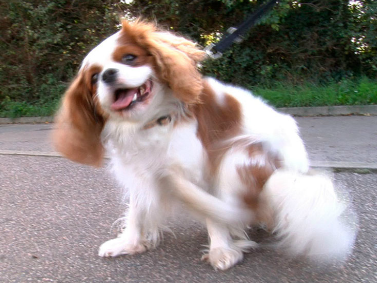 In a
November 2017 article, a team of UK neurology researchers (Zoe R.
Nalborczyk, Angus K. McFadyen, Jelena Jovanovik, Anna Tauro, Colin J.
Driver, Noel Fitzpatrick, Susan P. Knower, Clare Rusbridge) studied MRIs
of 37 cavalier King Charles spaniels affected with Chiari-like
malformation (CM) and syringomyelia (SM). Of those dogs, 19 phantom
scratched and 18 did not. They found that phantom scratching appeared to
be associated with a large dorso-lateral syrinx that extends to the
superficial dorsal horn (SDH) in the C2-C5 vertebrae. They observed that
syrinx sizes of the scratching group were between 2.5 and 9.5 times
larger than the non-scratching group. They concluded:
In a
November 2017 article, a team of UK neurology researchers (Zoe R.
Nalborczyk, Angus K. McFadyen, Jelena Jovanovik, Anna Tauro, Colin J.
Driver, Noel Fitzpatrick, Susan P. Knower, Clare Rusbridge) studied MRIs
of 37 cavalier King Charles spaniels affected with Chiari-like
malformation (CM) and syringomyelia (SM). Of those dogs, 19 phantom
scratched and 18 did not. They found that phantom scratching appeared to
be associated with a large dorso-lateral syrinx that extends to the
superficial dorsal horn (SDH) in the C2-C5 vertebrae. They observed that
syrinx sizes of the scratching group were between 2.5 and 9.5 times
larger than the non-scratching group. They concluded:
"SM associated phantom scratching appears associated with MRI findings of a large syrinx extending into the mid cervical SDH. We hypothesise that damage in this region might influence the lumbosacral scratching central pattern generator (CPG). If a scratching SM affected dog does not have a large dorsolateral cervical syrinx with SDH involvement then alternative explanations for scratching should be investigated."
(See also this May 2016 item about an abstract published by the same team of investigators.)
November 2017:
NC State study of cavaliers with CM and CM/SM finds
phantom scratching most common sign, and CM-only dogs showing classic
pain signs.
 In a
November 2017 article, a team of researchers at NC
State University and Cornell University (C.R. Sparks, S. Cerda-Gonzalez,
E.H. Griffith, B.D.X. Lascelles, Natasha J. Olby [right]) prepared and studied the
results of a questionnaire answered by owners of 50 cavalier King
Charles spaniels, 20 with only Chiari-like malformation (CM) and 30 with
both CM and syringomyelia (SM). Of the 50 dogs, 33 were symptomatic and
17 were not. The most common presenting sign was phantom scratching,
occurring in 32 dogs, and the most common sign of pain was crying out
when being lifted, occurring in 11 dogs. The researchers found that
owner-reported findings were not significantly associated with presence
or severity of SM or neurologic examination findings. Ten of the 20
CM-only dogs reportedly displayed "classic" signs of neuropathic pain.
In a
November 2017 article, a team of researchers at NC
State University and Cornell University (C.R. Sparks, S. Cerda-Gonzalez,
E.H. Griffith, B.D.X. Lascelles, Natasha J. Olby [right]) prepared and studied the
results of a questionnaire answered by owners of 50 cavalier King
Charles spaniels, 20 with only Chiari-like malformation (CM) and 30 with
both CM and syringomyelia (SM). Of the 50 dogs, 33 were symptomatic and
17 were not. The most common presenting sign was phantom scratching,
occurring in 32 dogs, and the most common sign of pain was crying out
when being lifted, occurring in 11 dogs. The researchers found that
owner-reported findings were not significantly associated with presence
or severity of SM or neurologic examination findings. Ten of the 20
CM-only dogs reportedly displayed "classic" signs of neuropathic pain.
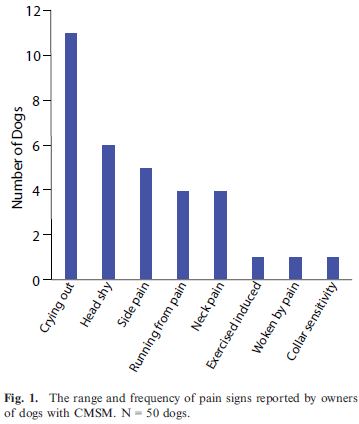 The series of questionnaires are linked here:
The series of questionnaires are linked here:
(a)
Preliminary
Questionnaire;
(b)
Dog Diagram
(ChiMPS-M);
(c)
Final Questionnaire
(ChiMPS-T).
At right is a chart of the most commonly reported symptoms of the 33 symptomatic cavaliers in this study. The researchers concluded:
"The conclusion that SM causes pain in CKCS is complicated by the finding that dogs with CM but no SM can show classic signs of neuropathic pain, as illustrated by 10 dogs in our study. ... To conclude, the full range of signs reported by owners of CKCS includes a variety of manifestations of pain, with phantom scratching as the most commonly reported sign followed by crying out when being lifted. Owner reporting of pain and scratch frequency and severity captured by the ChiMPS-T correlates with the owner-reported surface area affected by these signs in their dogs. Neither the scores nor the surface area reported correlated with the presence or severity of SM, highlighting uncertainty on the source of pain in these dogs."
September 2017:
Chiari-like malformation is found in 100% of 1,020 cavaliers in
Belgium and the Netherlands and syringomyelia in 39%.
 In
a
September 2017 article detailing a 12-year (2004 to 2015) study of
1,020 cavalier King Charles spaniels diagnosed using MRI scans in the
Netherlands and Belgium, researchers (Katrien Wijnrocx, Leonie W. L. Van
Bruggen, Wieteke Eggelmeijer, Erik Noorman, Arnold Jacques, Nadine Buys,
Steven Janssens, Paul J. J. Mandigers [right]) report the
results of evaluating the prevalence of Chiari-like malformation (CM)
and syringomyelia (SM) based upon MRI scans. They also estimated the
heritability of CM and SM in CKCSs during the 12 years of screening in
Belgium and the Netherlands. They found the presence of CM in all 1,020
dogs, concluding that CM has become a breed-specific characteristic of
the CKCS. They found that SM was present in 39% of the dogs, with SM
increasing with age, confirming the importance of screening at
appropriate ages, since SM can worsen with increasing age.
In
a
September 2017 article detailing a 12-year (2004 to 2015) study of
1,020 cavalier King Charles spaniels diagnosed using MRI scans in the
Netherlands and Belgium, researchers (Katrien Wijnrocx, Leonie W. L. Van
Bruggen, Wieteke Eggelmeijer, Erik Noorman, Arnold Jacques, Nadine Buys,
Steven Janssens, Paul J. J. Mandigers [right]) report the
results of evaluating the prevalence of Chiari-like malformation (CM)
and syringomyelia (SM) based upon MRI scans. They also estimated the
heritability of CM and SM in CKCSs during the 12 years of screening in
Belgium and the Netherlands. They found the presence of CM in all 1,020
dogs, concluding that CM has become a breed-specific characteristic of
the CKCS. They found that SM was present in 39% of the dogs, with SM
increasing with age, confirming the importance of screening at
appropriate ages, since SM can worsen with increasing age.
The authors see little progress in ridding the breed of CM without crossbreeding. They noted the success of crossbreeding in the Griffon Bruxellois, where an outcross with a CM-free Australian terrier resulted in some CM-free crosses. They recommend breeding selection based on estimated breeding values (EBVs), which they state could be more effective than selection on the phenotype (observable characteristics) alone. They state that EBVs are more accurate than phenotypic selection since they take into account the genetic contribution of all relatives (parents and offspring), and the information of the individual itself.
They compared the BVA/KC system for scoring SM with their own system using the exact width of the central canal dilation (CCD) or syrinx. They also compared two methods of assessing CM, the current BVA/KC scheme, and a more detailed scheme with extra classes for severely affected dogs. They evaluated the possibilities of both methods on selection based on the magnitude the heritability and determine whether CM and SM have declined over time. They found an advantage in using EBVs instead of the phenotypes for SM by showing that dogs having the same BVA/KC score can have a wide range of EBVs. They therefore concluded that using EBVs would give a more precise selection criterion.
September 2017:
Widespread syringomyelia and craniocervical junction abnormalities are
found in study of 53 Chihuahuas.
 In
a very detailed
September 2017 article, a team of neurological researchers
(Anna-Mariam Kiviranta [right], C. Rusbridge, O.
Laitinen-Vapaavuori, A. Hielm-Björkman, A.K. Lappalainen, S.P. Knowler,
T.S. Jokinen) studied 53 Finnish client-owned Chihuahuas to determine if
syringomyelia (SM) and Chiari-like malformation (CM) and other
craniocervical junction (CCJ) abnormalities (such as such as dorsal
spinal cord compression at the first 2 cervical vertebrae, caudal
position of the obex, and atlantooccipital overlapping) exist in
Chihuahuas and predispose the breed to SM. The examinations included MRI
scans and a questionnaire for owners of 44 of the dogs to complete. All
53 dogs had CM and 38% had SM. SM was detected in dogs with and without CM/SM-related
clinical signs. Of dogs without CM/SM-related clinical signs, 23% had
SM.
In
a very detailed
September 2017 article, a team of neurological researchers
(Anna-Mariam Kiviranta [right], C. Rusbridge, O.
Laitinen-Vapaavuori, A. Hielm-Björkman, A.K. Lappalainen, S.P. Knowler,
T.S. Jokinen) studied 53 Finnish client-owned Chihuahuas to determine if
syringomyelia (SM) and Chiari-like malformation (CM) and other
craniocervical junction (CCJ) abnormalities (such as such as dorsal
spinal cord compression at the first 2 cervical vertebrae, caudal
position of the obex, and atlantooccipital overlapping) exist in
Chihuahuas and predispose the breed to SM. The examinations included MRI
scans and a questionnaire for owners of 44 of the dogs to complete. All
53 dogs had CM and 38% had SM. SM was detected in dogs with and without CM/SM-related
clinical signs. Of dogs without CM/SM-related clinical signs, 23% had
SM.
The questions for the 44 dogs included a grading system for the description of the presence, frequency, and severity of CM/SM-related clinical signs, such as:
1.persistent scratching episodes of the ears or shoulders with or without skin contact
2.persistent scratching episodes of the cranial thoracic spine with or without skin contact
3.facial rubbing
4.spinal hyperesthesia
5.vocalization
6.gait incoordination
7.weakness
These were graded from 1 (occurring <2 times a week) to 5 (occurring several times a day). A percentage from the maximum points (7x5 = 35 points) was calculated for each patient.
Of the 44 dogs, half had and half did not have CM/SM-related clinical signs. Mean age, weight, and sex did not differ between those two groups. CM was observed in 53 dogs: cerebellar indentation in 11 of 53 dogs (21%) and cerebellar herniation in 42 of 53 dogs (79%). Central canal dilatation was detected in 15 of 53 dogs (28%) and SM in 20 of 53 dogs (38%). In 18 of 53 dogs (40%), no SM or central canal dilatation was detected. CM/SM-related clinical signs, such as scratching and facial rubbing, were detected in half of the dogs without SM at the cervical spine.
They found that SM, CM, and several other CCJ abnormalities were commonly encountered in the Chihuahuas. The CM/SM-related clinical signs in Chihuahuas are comparable with those detected in SM-affected cavalier King Charles spaniels. CM/SM-related clinical signs also were commonly present in dogs without SM and may be attributed to CCJ abnormalities. The most common clinical sign noted was scratching of the ears, shoulders, or cranial thoracic area with or without skin contact, seen in approximately 70% of dogs. Also, approximately half of the dogs rubbed their face, vocalized, or had spinal cord hyperesthesia indicative of neuropathic pain. In half of the dogs, the owners had noticed that their dog's gait was abnormal. They concluded that the findings highlight the importance of CCJ abnormalities other than CM in the pathogenesis of neuropathic pain in Chihuahuas.
August 2017:
Dr. Martin Schmidt finds cerebral blood flow is reduced in
cavaliers with ventriculomegaly and may be a form of hydrocephalus.
 In
an
August 2017 article, a team of researchers (Malgorzata Kolecka,
Robert Kirberger, Antje Hartmann) led by German Dr. Martin J. Schmidt
(right) studied the ventricle system of 42 cavalier King
Charles spaniels -- 32 CKSCs with
ventriculomegaly and 10 control CKCSs. They used "dynamic
susceptibility contrast perfusion" magnetic resonance imaging
(DSC-PMRI), which allows them to quantify the volume of blood passing
through the brain tissue. They found that cerebral blood flow (CBF) is
reduced in the periventricular white matter of CKCSs with
ventriculomegaly, which makes some increase of intraventricular pressure
likely. They stated that these findings make it plausible that
ventriculomegaly may be a form of internal hydrocephalus. They observed
that when intraventricular pressure is increased, a higher cerebrospinal
fluid (CSF) volume is forced from the ventricles at a higher velocity.
In
an
August 2017 article, a team of researchers (Malgorzata Kolecka,
Robert Kirberger, Antje Hartmann) led by German Dr. Martin J. Schmidt
(right) studied the ventricle system of 42 cavalier King
Charles spaniels -- 32 CKSCs with
ventriculomegaly and 10 control CKCSs. They used "dynamic
susceptibility contrast perfusion" magnetic resonance imaging
(DSC-PMRI), which allows them to quantify the volume of blood passing
through the brain tissue. They found that cerebral blood flow (CBF) is
reduced in the periventricular white matter of CKCSs with
ventriculomegaly, which makes some increase of intraventricular pressure
likely. They stated that these findings make it plausible that
ventriculomegaly may be a form of internal hydrocephalus. They observed
that when intraventricular pressure is increased, a higher cerebrospinal
fluid (CSF) volume is forced from the ventricles at a higher velocity.
July 2017:
Survey of 339 German cavaliers finds 97.1% with Chiari-like
malformation and 48.1% with SM.
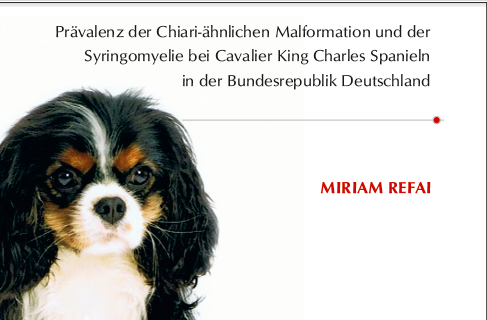 In a
July 2017 dissertation
by veterinary doctorate student Miriam Refai, she reports the results of
examining 339 cavaliers in Germany for Chiari-like malformation and/or
syringomyelia. The dogs ranged in age from 3 months to 11 years. Most
were asymptomatic of CM/SM and were being examined by MRI at the owners'
request for breeding purposes. She found that the risk of developing SM
appears to increase with the age of the CKCS. Additionally, she found
that SM can occur as a late onset disease. She found that SM does not
appear to be sex-linked. She concluded that her study confirms that CM
"appears to be ubiquitous in the CKCS breed and that almost half of all
dogs within the CKCS population seems to be affected by syringomyelia in
Germany."
In a
July 2017 dissertation
by veterinary doctorate student Miriam Refai, she reports the results of
examining 339 cavaliers in Germany for Chiari-like malformation and/or
syringomyelia. The dogs ranged in age from 3 months to 11 years. Most
were asymptomatic of CM/SM and were being examined by MRI at the owners'
request for breeding purposes. She found that the risk of developing SM
appears to increase with the age of the CKCS. Additionally, she found
that SM can occur as a late onset disease. She found that SM does not
appear to be sex-linked. She concluded that her study confirms that CM
"appears to be ubiquitous in the CKCS breed and that almost half of all
dogs within the CKCS population seems to be affected by syringomyelia in
Germany."
The statistics:
• 339 dogs examined by MRI
• Age range: 2.9 months to 11.2 years
• 329 dogs had CM = 97.1%
• 163 dogs had SM = 48.1%
• 25% of dogs under age 1 year had SM
• 63.7% of dogs over age 6 years had SM
June 2017:
German dermatologist successfully treats CM/SM-affected
cavaliers for itching with oclacitinib (Apoquel).
 In a
June
2017 article, a German internal medicine specialist, Stefanie
Kruppke (right), writes of
treating two cavalier King Charles spaniels with the main symptom of
"nonspecific itching", both diagnosed by MRI to have Chiari-like
malformation and syringomyelia, with oclacitinib (Apoquel), a selective
inhibitor of janus kinase (JAK1 and JAK3) enzymes, which are proteins
involved in signaling a pathway that results in itching and
inflammation. She stated that, in the case of allergic dermatitis,
oclacitinib inhibits itching in the neurological range.
In a
June
2017 article, a German internal medicine specialist, Stefanie
Kruppke (right), writes of
treating two cavalier King Charles spaniels with the main symptom of
"nonspecific itching", both diagnosed by MRI to have Chiari-like
malformation and syringomyelia, with oclacitinib (Apoquel), a selective
inhibitor of janus kinase (JAK1 and JAK3) enzymes, which are proteins
involved in signaling a pathway that results in itching and
inflammation. She stated that, in the case of allergic dermatitis,
oclacitinib inhibits itching in the neurological range.
She reported:
"In the two Cavalier King Charles Spaniels presented, a therapy with oclacitinib was initiated in the standard dose, which is recommended for atopic dermatitis (0.4-0.6 mg / kg 2 × daily for 14 days, then 1 × daily administration). ... Result and conclusion: After only 2 days the itching is clearly reduced, no scratching behavior can be observed after 1 week and the owners report a generally improved general condition. Both patients are taking the drug for a year now and are clinically inconspicuous, side effects have not occurred."
June 2017:
Ohio State University needs cavaliers for clinical study
of syringomyelia.
 Drs. Sarah Moore
(right) and
Ashley Hechler of Ohio State University in Columbus are seeking cavalier
King Charles spaniels with clinical signs of syringomyelia (SM)
for a clinical trial to test for the presence of neuropathic pain and
compare two drugs for treatment of that pain.
Drs. Sarah Moore
(right) and
Ashley Hechler of Ohio State University in Columbus are seeking cavalier
King Charles spaniels with clinical signs of syringomyelia (SM)
for a clinical trial to test for the presence of neuropathic pain and
compare two drugs for treatment of that pain.
First, the dogs' pain thresholds will be evaluated using the von Frey anesthesiometer. Then, the dogs will undergo anesthesia and an MRI scan to confirm they have SM. Afterwards, they will be randomly assigned to one of two groups -- one being treated with gabapentin and the other with amitriptyline. Amitriptyline (Elavil, Tryptizol, Laroxyl, Sarotex) is a tricyclic antidepressant (TCA) which occasionally has been prescribed by veterinarians as an alternative to gabapentin and is a first line drug in human medicine. The aim of the study is to compare how successful these drugs are at treating neuropathic pain.
To qualify for the study, the cavaliers must meet these criteria:
• Have clinical signs that are consistent with SM
• Overall health permits anesthesia
• No exposure to any medications 7 days prior to enrollment
• Owner able to administer medication 2 to 3 times daily
• Able to attend a follow-up appointment 4 weeks following the MRI
Benefits include the costs of general anesthesia, MRI, the von Frey procedure, and a 30 day supply of the assigned drug. For more information, see this webpage or contact Dr. Hechler at hechler.5@osu.edu or 614-292-3551.
June 2017:
International team of neurologists find cavaliers' gaits may be
affected by Chiari-like malformation.
 In
a
June 2017 article, a team of veterinary neurologists from Denmark,
the UK, and USA (Emil Olsen [right], Suiter EJ, Pfau T,
McGonnell IM, Matiasek K, Giejda A, Volk HA) compared the gaits (gait =
the pattern of movement of the dog's legs and paws) of 17 cavalier King
Charles spaniels (9 with both Chiari-like malformation [CM] and
syringomyelia [SM] and 8 with only CM) with 8 border terriers as a
control group. Previous studies had shown that clinical signs of CM and
SM include foreleg (thoracic) and hindleg (pelvic) incoordination,
thoracic muscular weakness and partial paralysis. The authors noted that
the cerebellum, which is primarily affected by CM in the CKCS, is
involved in gait coordination, stabilisation of motor control, and
inter-limb coordination. They measured six gait parameters, including
the distance between the forepaws and hindpaws on each side while
walking, and forepaw and hindpaw placement. They did not find any effect
of SM alone on gait parameters, but there was an effect of the changes
associated with CM which could suggest the cerebellum's involvement in
CM and the fine-tuning of gait. They concluded:
In
a
June 2017 article, a team of veterinary neurologists from Denmark,
the UK, and USA (Emil Olsen [right], Suiter EJ, Pfau T,
McGonnell IM, Matiasek K, Giejda A, Volk HA) compared the gaits (gait =
the pattern of movement of the dog's legs and paws) of 17 cavalier King
Charles spaniels (9 with both Chiari-like malformation [CM] and
syringomyelia [SM] and 8 with only CM) with 8 border terriers as a
control group. Previous studies had shown that clinical signs of CM and
SM include foreleg (thoracic) and hindleg (pelvic) incoordination,
thoracic muscular weakness and partial paralysis. The authors noted that
the cerebellum, which is primarily affected by CM in the CKCS, is
involved in gait coordination, stabilisation of motor control, and
inter-limb coordination. They measured six gait parameters, including
the distance between the forepaws and hindpaws on each side while
walking, and forepaw and hindpaw placement. They did not find any effect
of SM alone on gait parameters, but there was an effect of the changes
associated with CM which could suggest the cerebellum's involvement in
CM and the fine-tuning of gait. They concluded:
"Cavalier King Charles Spaniels with CM and CMSM have an increased variation of the ipsilateral distance between paws and length of the stride and a significantly wider base of support in the thoracic limbs but not in the pelvic limbs compared to Border Terriers. This could be an effect of cerebellar disease or cranial spinal cord disease however further breed-to-breed gait studies and objective quantification of hypermetria are necessary to further this conclusion. The increased spatial variation from CM and CMSM compared to control dogs could be used in rehabilitation and tracking of gait over time as well as monitoring for effect of treatment on gait changes and coordination."
January 2017:
UK study identifies characteristics that cause painful
Chiari-like malformation and syringomyelia in cavaliers.
 In
a
January 2017 article, a team of veteran neurologists and other
specialists (Susan P. Knowler [right], Chloe Cross, Sandra
Griffiths, Angus K. McFadyen, Jelena Jovanovik, Anna Tauro, Zoha Kibar,
Colin J. Driver, Roberto M. La Ragione, Clare Rusbridge) used novel
brain-mapping techniques to compare distance and angle measurements from
MRI scans of 162 cavalier King Charles spaniels to thereby determine the
relationship between the measure of physical characteristics obtainable
from MRI scans and resulting risk of pain caused by Chiari-like
malformation (CM) and syringomyelia (SM). They found that CM pain
appears to be associated with increased brachycephaly (shorteness of
muzzle), and that SM can result from different combinations of
abnormalities of the forebrain, caudal fossa, and craniocervical
junction which make up the neural parenchyma, and impede the flow of
cerebrospinal fluid.
In
a
January 2017 article, a team of veteran neurologists and other
specialists (Susan P. Knowler [right], Chloe Cross, Sandra
Griffiths, Angus K. McFadyen, Jelena Jovanovik, Anna Tauro, Zoha Kibar,
Colin J. Driver, Roberto M. La Ragione, Clare Rusbridge) used novel
brain-mapping techniques to compare distance and angle measurements from
MRI scans of 162 cavalier King Charles spaniels to thereby determine the
relationship between the measure of physical characteristics obtainable
from MRI scans and resulting risk of pain caused by Chiari-like
malformation (CM) and syringomyelia (SM). They found that CM pain
appears to be associated with increased brachycephaly (shorteness of
muzzle), and that SM can result from different combinations of
abnormalities of the forebrain, caudal fossa, and craniocervical
junction which make up the neural parenchyma, and impede the flow of
cerebrospinal fluid.
The study includes
a motion picture which highlights the dynamic changes of the skull
conformation and brain parenchyma associated with progressive
brachycephaly and airorhynchy [the upward rotation of the front of the
palate]. As the video morphs from the control dog to one with CM pain
that the nasal bone and hard palate become closer so that the hard
palate becomes more horizontal, the nasal cavity and frontal cavity
reduce in
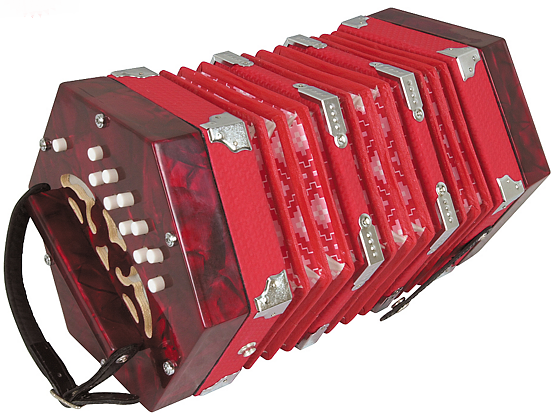 volume
and the rostral forebrain is flattened. As the model progresses into SM
case 1 the nasal and rostral forebrain changes become more extreme. In
addition to the forebrain changes, the hindbrain is pushed down and the
craniocervical junction kinks as a consequence of the cervical vertebral
being closer to the skull with flattening of the supraoccipital bone.
Consequently there is a “concertina” flexure of the brain with a
compensatory increase in height of the cranial fossa. In SM case 2 the
concertina flexure is more extreme lower with the cerebellum appear to
be folded back under the occipital lobe, and the olfactory bulbs are
much in size and displaced.
volume
and the rostral forebrain is flattened. As the model progresses into SM
case 1 the nasal and rostral forebrain changes become more extreme. In
addition to the forebrain changes, the hindbrain is pushed down and the
craniocervical junction kinks as a consequence of the cervical vertebral
being closer to the skull with flattening of the supraoccipital bone.
Consequently there is a “concertina” flexure of the brain with a
compensatory increase in height of the cranial fossa. In SM case 2 the
concertina flexure is more extreme lower with the cerebellum appear to
be folded back under the occipital lobe, and the olfactory bulbs are
much in size and displaced.
January 2017: UK study uses MRI scan measurements of hindbrain and craniocervical junction angles and distances to compare Chihuahuas, Affenpinschers and cavaliers with and without syringomyelia. In a January 2017 article, a team of UK researchers (Susan P. Knowler, Anna-Mariam Kiviranta, Angus K. McFadyen, Tarja S. Jokinen, Roberto M. La Ragione, Clare Rusbridge) examined MRI scans of the hindbrains and craniocervical junctions of 99 Chihuahuas, 42 Affenpinschers, and 132 cavalier King Charles spaniels to compare 22 specific features (line distances, angles, and ratios) of dogs with and without syringomyelia (SM), that were originally developed to investigate the genetic basis of Chiari-like malformation (CM) in the Griffon Bruxellois (GB). They concluded:
"The selected morphometries [physical measurements] successfully characterised conformational changes in the brain and craniocervical junction that might form the basis of a diagnostic tool for all breeds. The severity of SM involved a spectrum of abnormalities, incurred by changes in both angulation and size that could alter neural parenchyma compliance and/or impede cerebrospinal fluid channels."
Describing cavaliers specifically, the researchers stated:
"Ten of the fourteen significant variables were found in the CKCS with one, line a-c [see red line a-c in the diagram below], unique to the breed. Line a-c indicates the proximity of the sphenooccipital synchondrosis to the atlas bone. This study confirms the findings of others that the CKCS with SM have a reduced caudal fossa size a presumed consequence of early closure of the spheno-occipital and possibly other cranial sutures. Compared to other breeds including the GB, the CKCS has considerably greater incidence of cerebellar deformation by the supra-occipital bone and vermis herniation. These findings and the coexistence of occipital dysplasia and hypoplasia suggest that the CKCS may have additional predisposing risk factors for SM compared to the other breeds."
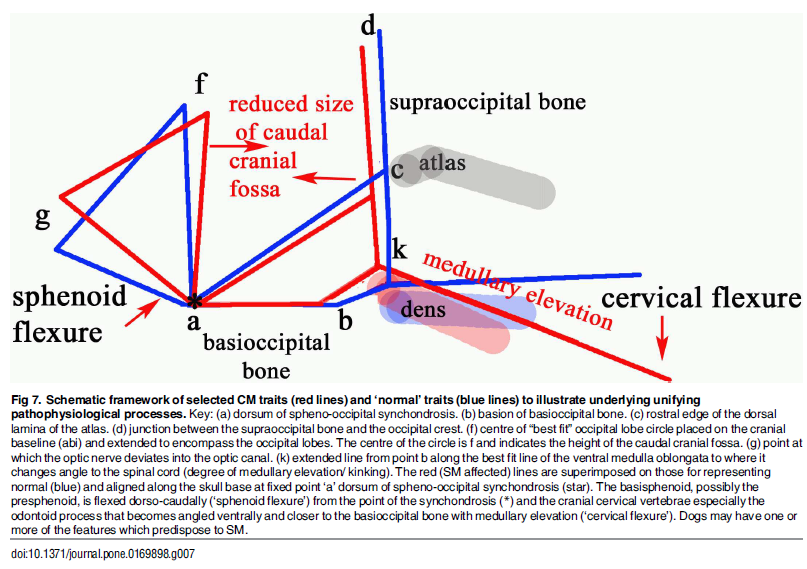
RETURN TO TOP
2016 News
November 2016:
Electronic von Frey aesthesiometer (eVF) testing fails to
distinguish pain levels in 70 cavaliers.
 In
a
November 2016 abstract, UK researchers (H. Williams, S. Sanchis, H.
A. Volk, L. Pelligand, J. Murrell, N. Granger) tested 70 cavalier King
Charles spaniels for skin sensitivity using the Electronic von Frey
aesthesiometer (eVF) (right). The eVF allows application of
increasing pressure onto the skin via a non-invasive plastic tip, until
the dog responds (i.e. demonstrating skin sensitivity threshold). The
eVF screen displays the pressure applied in grams.
In
a
November 2016 abstract, UK researchers (H. Williams, S. Sanchis, H.
A. Volk, L. Pelligand, J. Murrell, N. Granger) tested 70 cavalier King
Charles spaniels for skin sensitivity using the Electronic von Frey
aesthesiometer (eVF) (right). The eVF allows application of
increasing pressure onto the skin via a non-invasive plastic tip, until
the dog responds (i.e. demonstrating skin sensitivity threshold). The
eVF screen displays the pressure applied in grams.
The dogs were
categorized in three classes: (i) 37 dogs had syringomyelia and clinical
signs (syringomyelia-symptomatic – SM-S); (ii) 15 dogs had syringomyelia
without clinical signs (syringomyelia-asymptomatic – SM-A); and (iii) 18
dogs had no syringomyelia (syringomyelia-free - SM-F). The researchers
found that eVF assessment of skin sensitivity does not differ
significantly by syringomyelia status.
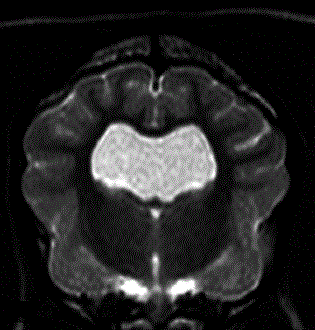 November 2016:
Cavaliers with ventriculomegaly may also have normal pressure
hydrocephalus (NPH). In an
October 2016 abstract, German researchers (M. J. Schmidt, A.
Hartmann, K. H. von Pückler, L. Hähnsen, N. Ondreka) compared the
perfusion of blood in the periventricular white matter of 23 cavalier
King Charles spaniels with ventriculomegaly (see white area in photo
at right) compared to control dogs
consisting of 10 healthy Beagles. They found that cerebral blood flow
and volume were significantly lower in the cavaliers. They concluded
that the dogs with ventriculomegaly may have a form of normal pressure
hydrocephalus (NPH).
November 2016:
Cavaliers with ventriculomegaly may also have normal pressure
hydrocephalus (NPH). In an
October 2016 abstract, German researchers (M. J. Schmidt, A.
Hartmann, K. H. von Pückler, L. Hähnsen, N. Ondreka) compared the
perfusion of blood in the periventricular white matter of 23 cavalier
King Charles spaniels with ventriculomegaly (see white area in photo
at right) compared to control dogs
consisting of 10 healthy Beagles. They found that cerebral blood flow
and volume were significantly lower in the cavaliers. They concluded
that the dogs with ventriculomegaly may have a form of normal pressure
hydrocephalus (NPH).
September
2016:
Acupuncture successfully controls pain symptoms in a
CM/SM-affected cavalier.
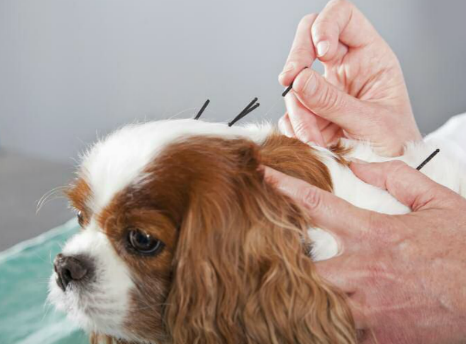 In a
September 2016 article, a UK veterinarian (Donal Joseph O'Leary)
reports on the successful use of acupuncture to control the signs of
pain in a female tricolor cavalier King Charles spaniel suffering from Chiari-like
malformation and syringomyelia (CM/SM). The acupuncture was in addition
to conventional medical treatment. He noted:
In a
September 2016 article, a UK veterinarian (Donal Joseph O'Leary)
reports on the successful use of acupuncture to control the signs of
pain in a female tricolor cavalier King Charles spaniel suffering from Chiari-like
malformation and syringomyelia (CM/SM). The acupuncture was in addition
to conventional medical treatment. He noted:
"This patient exhibited signs which suggested it was also suffering from headaches. It often presented with a frowning expression and during these times intensely disliked being touched, rubbed or patted on the head. Acupuncture had a definite positive effect on this patient with reductions in all the signs including the signs of phantom scratching and vocalisation."
August 2016:
Southeast Veterinary Neurology offers reduced cost CM/SM
screening for cavaliers.
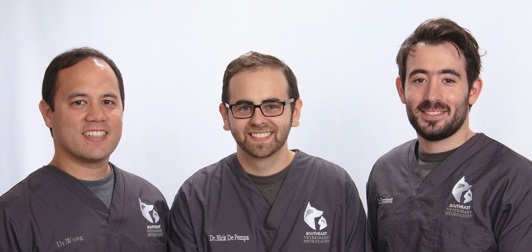 Board
certified veterinary neurologists Drs. Michael Wong, Nicholas De Pompa,
and Simon Kornberg (right) at Southeast Veterinary Neurology
(SEVN) have announced they are offering reduced cost screenings
($900.00) of cavalier King Charles spaniels to diagnose Chiari-like
malformation and syringomyelia. The package includes a full physical and
neurological exam, MRI scan using a high-field 1.5 Tesla MRI unit,
anesthesia, a computer disc of the MRI images, and a detailed report
reviewing the results in line with the BVA
breeding guidelines. All screenings will take place at SEVN's Miami
office. Call 305-274-2777 to schedule an appointment. Details are at
this Internet link.
Board
certified veterinary neurologists Drs. Michael Wong, Nicholas De Pompa,
and Simon Kornberg (right) at Southeast Veterinary Neurology
(SEVN) have announced they are offering reduced cost screenings
($900.00) of cavalier King Charles spaniels to diagnose Chiari-like
malformation and syringomyelia. The package includes a full physical and
neurological exam, MRI scan using a high-field 1.5 Tesla MRI unit,
anesthesia, a computer disc of the MRI images, and a detailed report
reviewing the results in line with the BVA
breeding guidelines. All screenings will take place at SEVN's Miami
office. Call 305-274-2777 to schedule an appointment. Details are at
this Internet link.
August 2016:
Cavaliers lead list of CM/SM-affected dogs treated in England
primary-care clinics, 2009-2014. In an
August 2016 article reviewing the clinical records of 187,326 dogs
treated at primary-care veterinary clinics in England, from September
2009 through April 2014, the cavalier King Charles spaniel led the list
of dogs diagnosed and treated for Chiari-like malformation and/or
syringomyelia (CM/SM).
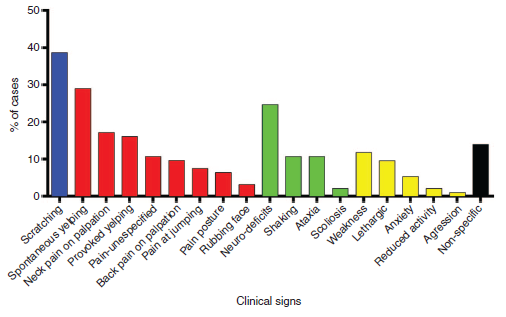 However,
the statistics are surprisingly low. Overall, only 93 dogs were
diagnosed or treated for CM/SM. Of those, 65 were cavaliers (69.9% of
all CM/SM-diagnosed/treated dogs), out of a total of the 4,046 CKCSs
which were included in the full study. So, only 1.6% of all cavaliers
were diagnosed or treated for CM/SM.
However,
the statistics are surprisingly low. Overall, only 93 dogs were
diagnosed or treated for CM/SM. Of those, 65 were cavaliers (69.9% of
all CM/SM-diagnosed/treated dogs), out of a total of the 4,046 CKCSs
which were included in the full study. So, only 1.6% of all cavaliers
were diagnosed or treated for CM/SM.
The researchers (Sanchis-Mora S,
Pelligand L, Thomas CL, Volk HA, Abeyesinghe SM, Brodbelt DC, Church DB,
Thomson PC, McGreevy PD, O'Neill DG) attribute the "underestimation of
the true prevalence" of CM/SM to lack of MRI scans. They also noted that
a significant proportion of dogs in the study were excluded because a
clinical diagnosis was not made despite possible signs of CM/SM being
present and because clinical signs could be confused with other
diagnosed diseases.
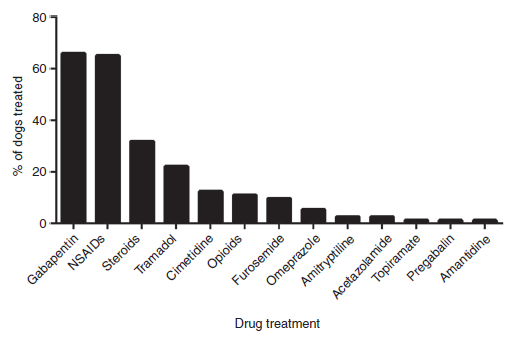 They
found an increased diagnosis level for insured dogs, suggesting that
financial and other constraints on diagnostic procedures may have
allowed the true prevalence of CM/SM in the overall population to be
underestimated.
They
found an increased diagnosis level for insured dogs, suggesting that
financial and other constraints on diagnostic procedures may have
allowed the true prevalence of CM/SM in the overall population to be
underestimated.
Pain was the most common sign reported for CM/SM (67 dogs, 72%). Others were phantom scratching (36 dogs, 38.7%), spontaneous yelping (27 dogs, 29%), neck pain on palpation (16 dogs, 17.2%), and provoked yelping (15 dogs, 16.1%). Treatment records for 89 of the affected dogs showed that 72 dogs received one or more drugs for treatment of CM/SM, and 17 dogs were unmedicated. Gabapentin (48 dogs - 67%), NSAIDs (47 dogs - 65%), and corticosteroids (23 dogs - 32%) were the most commonly prescribed treatments for CM/SM. Two dogs (2.1%) underwent surgery for CM/SM but the outcomes of surgery were not recorded. During the study period, 9 of the 93 dogs were euthanased/died (9.8%) as a result of CM/SM.
June 2016:
Ohio State University needs cavaliers for clinical study of Chiari-like
malformation and syringomyelia.
Dr. Sarah Moore of Ohio
State University is seeking cavalier King Charles spaniels
 (CKSC) for a
clinical trial to evaluate pain thresholds of cavaliers both with and
without Chiari-like malformation and syringomyelia (CM/SM). Both normal
and CM/SM-affected dogs are being recruited. The entire test is expected
to take only 20 minutes. It will involve a neurlogical examination and
then apply steady pressure to the dog's back leg paws, using a von Frey
anesthesiometer (VFA) (right) until the dog feels the pressure and pulls its
foot away. Anyone conveniently located near Columbus, Ohio may contact
the Blue Buffalo Clinical Trials Office by telephone 614-247-8706 or
email CVM-ClinicalTrials@osu.edu or check
this OSU webpage.
(CKSC) for a
clinical trial to evaluate pain thresholds of cavaliers both with and
without Chiari-like malformation and syringomyelia (CM/SM). Both normal
and CM/SM-affected dogs are being recruited. The entire test is expected
to take only 20 minutes. It will involve a neurlogical examination and
then apply steady pressure to the dog's back leg paws, using a von Frey
anesthesiometer (VFA) (right) until the dog feels the pressure and pulls its
foot away. Anyone conveniently located near Columbus, Ohio may contact
the Blue Buffalo Clinical Trials Office by telephone 614-247-8706 or
email CVM-ClinicalTrials@osu.edu or check
this OSU webpage.
June 2016:
In study of 54 cavaliers, craniocervical junction (CCJ)
abnormalities fail to predict future SM symptoms.
 In a
June 2016 report,
neurologists Sofia Cerda-Gonzalez (right) and Natasha J. Olby
conducted a long-term study of 54 cavalier King Charles spaniels (CKCS)
to determine if asymptomatic dogs with craniocervical junction (CCJ)
abnormalities would predict future development of clinical signs of
syringomyelia (SM). Over 80% of the asymptomatic dogs in the study had
CCJ abnormalities upon initial examination. Nevertheless, nearly
two-thirds of the asymptomatic CKCSs remained asymptomatic throughout
the study period. They concluded:
In a
June 2016 report,
neurologists Sofia Cerda-Gonzalez (right) and Natasha J. Olby
conducted a long-term study of 54 cavalier King Charles spaniels (CKCS)
to determine if asymptomatic dogs with craniocervical junction (CCJ)
abnormalities would predict future development of clinical signs of
syringomyelia (SM). Over 80% of the asymptomatic dogs in the study had
CCJ abnormalities upon initial examination. Nevertheless, nearly
two-thirds of the asymptomatic CKCSs remained asymptomatic throughout
the study period. They concluded:
"Craniocervical junction morphology assessed in our study did not appear to predict the development of new and worsened clinical signs or syringomyelia over time in our cohort of CKCS. The relationships between clinical progression and syringomyelia, AOO [overlap of the atlanto-occipital joint], and dorsal bands should be evaluated further in a larger cohort of dogs. Clinical progression in our cohort of medically managed CKCS did not differ substantially from published reports of those treated surgically."
May 2016: UK researchers find evidence that CM in cavaliers may be due to overall brain and skull size. Until now, Chiari-like malformation has been considered a hind brain conformation disorder in cavalier King Charles spaniels. But in an April 2016 abstract presented to the 2016 BSAVA Congress, a team of UK neurological researchers (Chloe Cross, Susan P. Knower, Angus K. McFayden, Jelena Jovanovik, Anna Tauro, Colin J. Driver, Noel Fitzpatrick, Clare Rusbridge) have found evidence that CM may be the result of an overall disorder of the conformation of the CKCS brain and skull.
They examined MRI scans of the skulls of 70 cavaliers, divided into four categories: SM with phantom scratching (15 CKCSs); clinical SM (e.g. pain) but no phantom scratching (17 CKCSs); behavioral signs of pain with CM but no SM (25 CKCSs); and CKCS with no SM and no behavioral signs of pain or scratching (13 dogs -- “CKCS control”). They also had an “other-breed-control” group of 19 dogs (including 5 brachycephalic -- short-muzzled), with normal brain sizes.
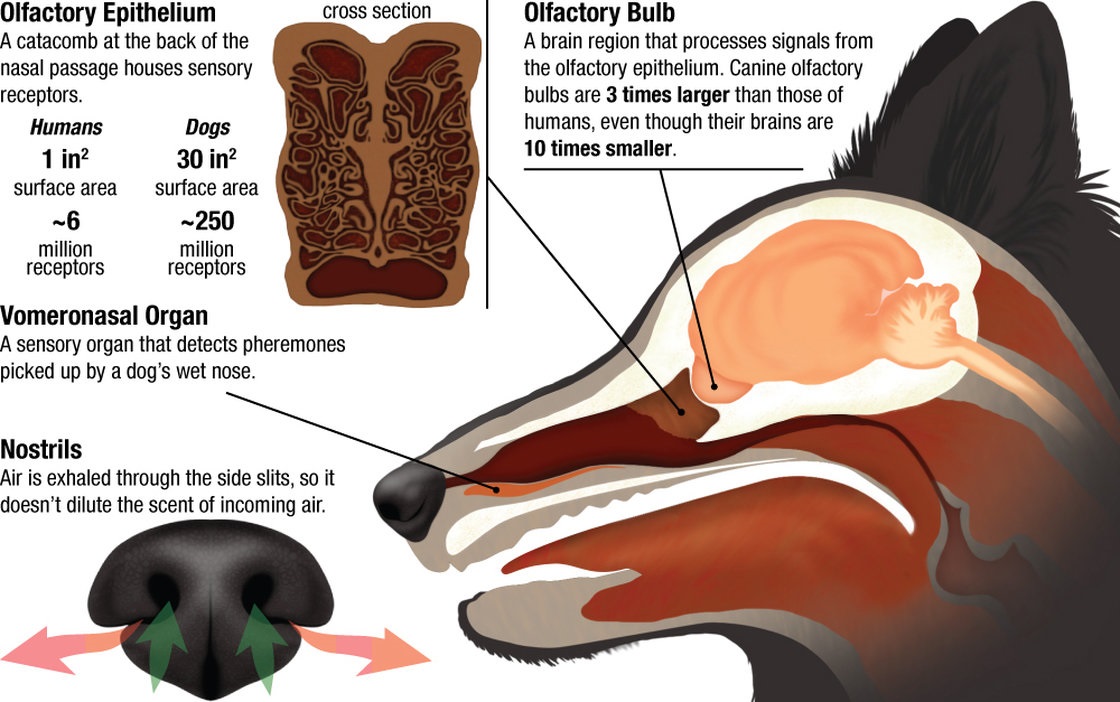
They
hypothesized that there may be insufficient room within the skull for
the forebrain, and that may contribute to backward displacement and
overcrowding of the hindbrain. They focused upon the forebrain's
olfactory bulb (OB -- also called olfactory lobe), which is at the lower front of the forebrain and
directly behind the olfactory receptor cells in the dog’s nose. (See
diagram above.) The more brachycephalic (short-muzzled) the dog, the
more the OB tends to be lower and the more the frontal lobe tends to be
flattened against the front of the skull. (Compare the normal
location of the canine forebrain in the diagram at the left below, with the
flattened frontal lobe and the lower olfactory lobe of a CM/SM-affected
cavalier, at the right below.)
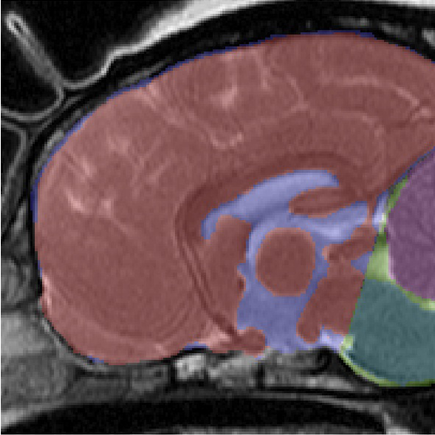
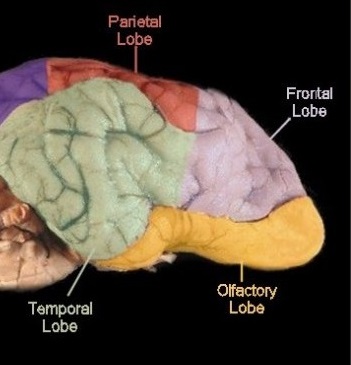
They found that the more severe the CM/SM condition of the cavaliers in the study, the smaller the mean size of the OB, and that there was a significant difference between the cavaliers' OB in the four CM/SM groups and the dogs' OB in the other-breed-control group. They also noticed a trend towards more ventrally (lower) orientated OB with increasing CM/SM severity. They concluded:
“This study suggests that CM should be considered a more global brain and skull conformational disorder with features of extreme brachycephaly including smaller more ventrally orientated OB; however, further work is required and the measurement technique has been refined for future studies. We recommend that future studies into MRI conformation of CM and SM uses rigorous phenotyping based on clinical signs and age.”
EDITOR'S NOTE: This study admittedly is preliminary, as its conclusion suggests. However, it does not begin to explain why the cavalier King Charles spaniel breed has such a high incidence of CM and SM. There must be something unique in the CKCS (and perhaps one or two other breeds), beyond just being brachycephalic, which differentiates them from other short-muzzled breeds which do not have such a high incidence of these two disorders. We suggested as much in our blog entry, “The accordion-muzzled cavalier King Charles spaniel”.
May 2016: UK researchers find that phantom scratching in CM/SM-affected cavaliers is due to the location and size of the syrinx. In an April 2016 abstract presented to the 2016 BSAVA Congress, a team of UK neurological researchers (Zoe R. Nalborczyk, Angus K. McFadyen, Jelena Jovanovik, Anna Tauro, Colin J. Driver, Noel Fitzpatrick, Susan P. Knower, Clare Rusbridge) reported a study of 37 cavalier King Charles spaniels to try to determine why, if affected dogs experience unusual sensations, they nevertheless make little or no skin contact.
 They investigated two hypotheses: (1) That the phenomenon of phantom
scratching is associated with a large dorsolateral syrinx in the upper
cervical spinal cord segments; and (2) Whether there is an association
to damage in other areas of the cervical spinal cord and that phantom
scratching is not just associated with a dorsolateral syrinx but one
that extends to the superficial dorsal horn (SDH).
They investigated two hypotheses: (1) That the phenomenon of phantom
scratching is associated with a large dorsolateral syrinx in the upper
cervical spinal cord segments; and (2) Whether there is an association
to damage in other areas of the cervical spinal cord and that phantom
scratching is not just associated with a dorsolateral syrinx but one
that extends to the superficial dorsal horn (SDH).
The study found that phantom scratching is associated with a large dorso-lateral syrinx that extends to the SDH in the C3-C6 spinal segments (C2-C5 vertebrae). The study did not find an association to damage of other areas of cervical spinal cord. They concluded that:
"Phantom scratching in the dog is associated with a large syrinx that extends to the SDH in the C3-C6 spinal segments. We propose that phantom scratching is due to damage to projection neurons in lamina I of the SDH with consequent reduced descending inhibition to the lumbosacral scratching CPG [central pattern generator -- neural circuits controlling a stereotyped sequence of muscle contractions]. ... If a dog has SM extending to the SDH then it is at risk for phantom scratching. If an itchy SM affected dog has no SDH involvement then alternative explanations for scratching (e.g. allergic skin disease) should be investigated."
They added that drugs affecting the SDH may be useful for management of phantom scratching. (See also this November 2017 item about an article published by the same team of investigators.)
May 2016:
UK neurological researchers test electronic von Frey aesthesiometer to
measure SM-associated neuropathic pain in cavaliers. In an
April 2016 abstract presented to the 2016 BSAVA Congress, a team of UK
neurological researchers (Heather Williams, Sandra Sanchis, Ludovic
Pelligand, Holger
 Volk, Joanna Murrell, Nicolas Granger) tested the
electronic von Frey aesthesiometer (eVF) (at left) on twelve cavalier King Charles
spaniels (CKCS) to determine if they could quantify the dogs' cervical
skin sensitivity. They decided that the number of dogs was insufficient
to reach any conclusions, and they announced plans to study a larger
group of CKCSs and divide them by CM/SM status. Their aim is to
establish a protocol to quantify neck pain in cavaliers with neuropathic
pain.
Volk, Joanna Murrell, Nicolas Granger) tested the
electronic von Frey aesthesiometer (eVF) (at left) on twelve cavalier King Charles
spaniels (CKCS) to determine if they could quantify the dogs' cervical
skin sensitivity. They decided that the number of dogs was insufficient
to reach any conclusions, and they announced plans to study a larger
group of CKCSs and divide them by CM/SM status. Their aim is to
establish a protocol to quantify neck pain in cavaliers with neuropathic
pain.
May 2016:
UK study shows SM-affected cavaliers have more blood vessels and stiffer
vessel walls adjacent to lateral ventricles.
 In an
April 2016 abstract (titled: "Contents Under Pressure") presented to
the 2016 BSAVA Congress, a team of UK neurological researchers (Clare
Rusbridge [right], Silvia Guilluna, Daniela Menezes, Duncan Grainger, Anna
Tauro, Nicholas Jeffery, Fernando Constantinocasa, Penny Watson,
Francisco Salguero) examined brain tissue from 26 deceased cavalier King
Charles spaniels -- 18 affected by CM/SM with ventriculomegaly and 8
without SM -- to determine differences in the quantities of blood
vessels and the vessels' fibrous tissue between the two groups. They
hypothesized that these increased numbers of vessels and fibrous tissues
adjacent to syrinx cavities suggested a response to increased intra-cord
pressure. They found from their examination of the tissues from the
cerebral cortex that SM-affected cavaliers had significant increases in
the number of blood vessels, associated with increases in the widths of
the vessels' walls due to thicker fibers. They also found abnormal
increases in the number of astrocytes (star-shaped glial cells in the
central nervous system). They concluded:
In an
April 2016 abstract (titled: "Contents Under Pressure") presented to
the 2016 BSAVA Congress, a team of UK neurological researchers (Clare
Rusbridge [right], Silvia Guilluna, Daniela Menezes, Duncan Grainger, Anna
Tauro, Nicholas Jeffery, Fernando Constantinocasa, Penny Watson,
Francisco Salguero) examined brain tissue from 26 deceased cavalier King
Charles spaniels -- 18 affected by CM/SM with ventriculomegaly and 8
without SM -- to determine differences in the quantities of blood
vessels and the vessels' fibrous tissue between the two groups. They
hypothesized that these increased numbers of vessels and fibrous tissues
adjacent to syrinx cavities suggested a response to increased intra-cord
pressure. They found from their examination of the tissues from the
cerebral cortex that SM-affected cavaliers had significant increases in
the number of blood vessels, associated with increases in the widths of
the vessels' walls due to thicker fibers. They also found abnormal
increases in the number of astrocytes (star-shaped glial cells in the
central nervous system). They concluded:
"The logical explanation of this histomorphological change is a mechanical response to elevated arterial pressure. This arterial stiffening may further affect the ability to reduce the arterial pulse wave and decrease the CNS compliance."
April 2016:
UK
neurologist calls
for study of whether furosemide can delay syrinx growth in cavaliers. In
a brief
April 2016 article, UK veterinary neurologist Luca Motta
(right) reports
studying the effect
 of furosemide therapy upon the progression of syrinx
growth in seven cavalier King Charles spaniels. He states:
of furosemide therapy upon the progression of syrinx
growth in seven cavalier King Charles spaniels. He states:
"In all seven dogs, syrinx width and length increased at the follow-up MRI and in four cases a new syrinx had developed (Table 1). Furosemide did not prevent further syrinx expansion nor reduce the size of the syrinx but it remains unknown whether the medical treatment may have delayed the inevitable expansion of the syrinx. Studies of a larger population and prospective, randomised, blinded comparisons between different treatments (medical, surgical, medical vs surgical) are needed to ascertain which will produce the best clinical results."
March 2016:
Accidental mixed
breeding of Griffon Bruxellois (GB) provides an experiment in reducing
risk of Chiari-like malformation and syringomyelia.
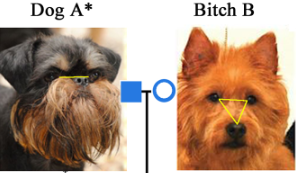 An accidental
breeding of a Griffon Bruxellois (GB) -- Brussels Griffon -- and an
Australian terrier (right) results in a useful experiment in out-crossing and
back-crossing to reduce the incidence of Chiari-like malformation and
syringomyelia in that breed. In a
March 2016 article, a team of
researchers and a Dutch GB breeder (Susan P. Knowler, Henny van den Berg
[breeder], Angus
McFadyen, Roberto M. La Ragione, Clare Rusbridge) analyzed the offspring
and subsequent generation of the cross-breeding over a period of four
years.
An accidental
breeding of a Griffon Bruxellois (GB) -- Brussels Griffon -- and an
Australian terrier (right) results in a useful experiment in out-crossing and
back-crossing to reduce the incidence of Chiari-like malformation and
syringomyelia in that breed. In a
March 2016 article, a team of
researchers and a Dutch GB breeder (Susan P. Knowler, Henny van den Berg
[breeder], Angus
McFadyen, Roberto M. La Ragione, Clare Rusbridge) analyzed the offspring
and subsequent generation of the cross-breeding over a period of four
years.
Their aims:
1. To investigate the effectiveness of a crossbreeding a brachycephalic GB with CM and a mesaticephalic Australian terrier without CM as a means of reducing the incidence of traits associated with CM and risk for SM.
2. To elucidate the inheritance by comparing phenotypic traits related to both CM and SM that have been previously shown to be statistically significant [1] for the conditions.
3. To clarify the phenotype of CM with an ultimate aim of improving the CM/SM grading system and generate robust EBVs that are appropriate for all breeds.
They rhetorically asked and answered:
"Did the outcross reduce the risk of inherited CM and SM?" --- "An outcross does have the potential to reduce prevalence of inherited CM and SM. ... Although the offspring were too young to confirm SM clear status, the morphometric measurements used in this study provide an indicator of risk for SM."
"Did the study indicate any patterns of inheritance for CM/SM?" --- "This study is too small to make conclusions about inheritance. However, the F2 backcross had CM1 status from CM2 parents despite the high incidence of inherited CM in the other family members. These results, together with the fact CM is known to skip a generation in an earlier familial study of 33 GB, suggests the involvement of recessive traits that are protective against CM and/or gene penetrance is variable involving individual traits that are additive in severity. ... SM2 dog E and SM1 dogs C and K were mated to SM0 dogs. Of their eight offspring two were SM2 and two SM1. SM0 parents A and H when mated together produced both an SM0 and SM2 offspring. All these findings support evidence from two previous studies of inheritance in the BG."
"Is it possible to retain Breed Standard in an outcross?"--- "... The head and body conformation of the F2 backcross abfg is sufficiently similar to the GB breed standard that, in the next generation GB backcross (CM0), a suitable F3 offspring would be accepted in the GB Stud book of the European FCI. Since facial length has a different morphogenesis and embryological origin to that of the basisphenoid and occipital bones it should be possible to select against a reduced hind skull. ... The introduction of new genes in a mixed breed cross means progeny may be phenotypically less predictable. Despite this, the dog skull is particularly variable, and this study has illustrated that with careful selection of external and internal traits in the proposed mate, it might be possible to avoid risk of CM and SM and regain the external conformation which best characterises the breed."
This study has enabled its researchers to refine the definition of Chiari-like malformation, as follows:
"This study supports the hypothesis that CM in the dog is a more global skull disorder rather than a caudal skull abnormality. ... The definition of CM is refined as a more global cranium and craniocervical junction abnormally characterized by insufficiency of the supra and basioccipital bones with compensatory rostral cranium doming, shortening of the skull base and increased proximity of the cervical vertebrae to the occiput resulting in overcrowding of the neural parenchyma in the caudal fossa."
January 2016:
Cornell Univ. neurologist Cerda-Gonzalez finds a close association of
atlanto-occipital overlapping (AOO) in cavaliers with clinical signs of
SM.
 In a
March 2016 report, Cornell University
neuroglogist
Dr. Sofia Cerda-Gonzalez (right) and her research team
(K.F. Bibi, A.T. Gifford, E.L. Mudrak, P.V. Scrivani) examined the
MRIs of 271 dogs, measuring the proximity of the atlas to the foramen
magnum. They found a close association (higher than previously reported)
between atlanto-occipital overlapping (AOO) and small breeds,
including cavalier King Charles spaniels, affected with clinical signs
of syringomyelia (SM). CKCS were more likely (86%) than non-CKCS (44%)
to have AOO.
In a
March 2016 report, Cornell University
neuroglogist
Dr. Sofia Cerda-Gonzalez (right) and her research team
(K.F. Bibi, A.T. Gifford, E.L. Mudrak, P.V. Scrivani) examined the
MRIs of 271 dogs, measuring the proximity of the atlas to the foramen
magnum. They found a close association (higher than previously reported)
between atlanto-occipital overlapping (AOO) and small breeds,
including cavalier King Charles spaniels, affected with clinical signs
of syringomyelia (SM). CKCS were more likely (86%) than non-CKCS (44%)
to have AOO.
EDITOR'S NOTE: The atlas is the spinal vertebra (C1) closest to the skull. It sits next to the foramen magnum, which is the hole in the occipital bone. The "atlanto-occipital joint" is the connection between the atlas and the occipital bone, and is stabilized by ligaments. "Atlanto-occipital overlapping" (AOO) is characterized by a decreased distance between the atlas and the occipital bone. In some cases, the dorsal arch of the atlas may actually protrude into the foramen magnum. See the image below (courtesy of: www.wikispaces.com). See also these related articles: May 2009; October 2009; January 2010; April 2013; February 2014; and November 2015.
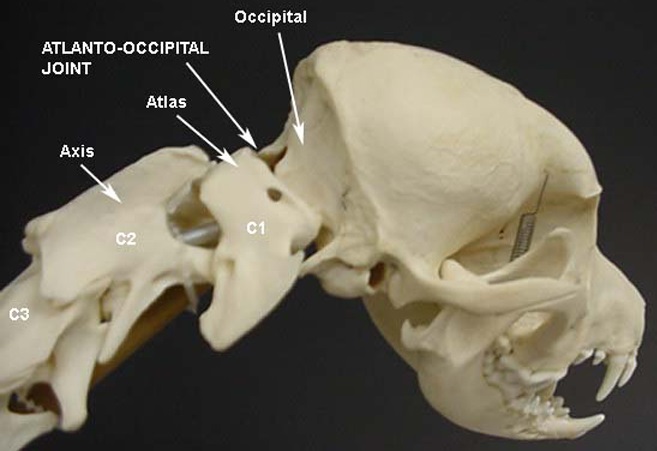
RETURN TO TOP
2015 News
December 2015: SM syrinx formation computer model discounts likelihood that cerebrospinal fluid abnormalities create syrinxes. In a September 2015 abstract before the ESVN-ECVN, UK researchers (R. Lloyd, S. Cirovic, J. Jovanovik, H. Volk, C. Rusbridge) created a computer model of the spinal cord, subarachnoid space (SAS), dura mater, and the epidural space of a cavalier King Charles spaniel affected with CM/SM. They performed exaggerated movement of the spinal cord during the cardiac cycle, seeking to confirm a theory that abnormities in the circulation of the cerebrospinal fluid (CSF) generate pressures that drive the fluid into the cord. Instead, they found that CSF pressure gradients are unlikely to cause fluid movement into the cord, sufficient to generate syrinxes. They concluded:
"On the other hand, although the shear stress in the cord is low, its location and cyclic nature indicates the possibility that this may be the factor that generates the initial tissue damage, which eventually leads to the formation of syrinxes."
December 2015:
Neurologist Jason King sums up Chiari-like malformation.
 In
a December 2015 blog article, US veterinary neurologist
Dr. Jason King
(right)
has written a summary of Chiari-like malformation as he sees it. He
clings to what we had thought was some replaced terminology, particularly "Caudal Occipital
Malformation Syndrome (COMS)" rather than Chiari-like malformation (CM
or CLM) and "syringo-hydromyelia" rather than syringomyelia (SM), but he also provides some newer information about how the
spinal cord works and why affected dogs feel phantom sensations. He states:
In
a December 2015 blog article, US veterinary neurologist
Dr. Jason King
(right)
has written a summary of Chiari-like malformation as he sees it. He
clings to what we had thought was some replaced terminology, particularly "Caudal Occipital
Malformation Syndrome (COMS)" rather than Chiari-like malformation (CM
or CLM) and "syringo-hydromyelia" rather than syringomyelia (SM), but he also provides some newer information about how the
spinal cord works and why affected dogs feel phantom sensations. He states:
"The part of the spinal cord that is towards the chest of a person or animal carries information from the brain to the body, instructions on how to move. The part of the spinal cord towards the back of the person or animal carries information from the body to the brain, sensory information if you will. Interestingly enough, SM almost always forms in the sensory part of the spinal cord. So it leads to abnormal sensations rather than weakness or abnormal movments. That means that dogs with SM manifest some very odd and quite varied behaviors secondary to the abnormal sensations that their spinal cord is causing them to feel. Imagine, that every time you got excited your toes began to itch and burn, your ear began to feel hot, or your arm became numb and tingly... The most striking manifestation of this abnormal sensation is called 'phantom scratching'. In this situation, dogs will begin to scratch 'at' their ear, but just a little bit off to the side. Almost as if they were scratching the air!"
December 2015:
UK vet
schools need cavaliers for neck pain study.
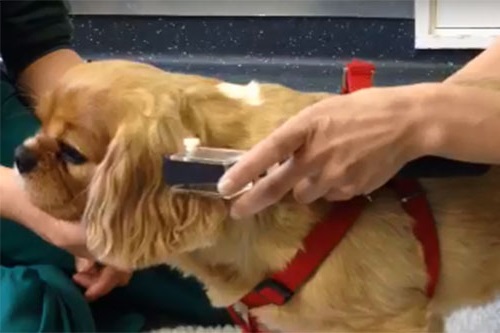 Researchers at
the UK's University of Bristol vet school and the Royal Veterinary
College are conducting a study to find a pain-free method of detecting
neck pain of neurological origin in dogs. The study involves owners
completing questionnaires and assessments of the dogs' neck skin
sensitivity with a pain-free electronic pressure device, a von Frey
aesthesiometer (see photo at right), being applied to the skin, while monitoring for the
dogs' responses. To take part in the study, email
vet-neuroresearch@bristol.ac.uk. For more details, see
this press
release.
Researchers at
the UK's University of Bristol vet school and the Royal Veterinary
College are conducting a study to find a pain-free method of detecting
neck pain of neurological origin in dogs. The study involves owners
completing questionnaires and assessments of the dogs' neck skin
sensitivity with a pain-free electronic pressure device, a von Frey
aesthesiometer (see photo at right), being applied to the skin, while monitoring for the
dogs' responses. To take part in the study, email
vet-neuroresearch@bristol.ac.uk. For more details, see
this press
release.
November 2015:
Dr. Loughin summarizes the current view of
Chiari-like malformation.
 In a
March 2016 article, veterinary brain surgeon
Dr. Catherine
Loughlin (right), summarizes the current research on
Chiari-like malformation for general practice veterinarians. She writes:
In a
March 2016 article, veterinary brain surgeon
Dr. Catherine
Loughlin (right), summarizes the current research on
Chiari-like malformation for general practice veterinarians. She writes:
"Chiari-like malformation (CLM) is a condition of the craniocervical junction in which there is a mismatch of the structures of the caudal cranial fossa (CCF), often causing the cerebellum to herniate into the foramen magnum. Affected dogs have a smaller CCF with relatively more brain parenchyma within the fossa compared to unaffected dogs. This smaller CCF leads to cerebellar compression and herniation through the foramen magnum, kinking of the medulla, and disruption of cerebrospinal fluid (CSF) at this junction. This malformation is found most commonly in the Cavalier King Charles spaniel (CKCS), is inherited, and is thought to affect as much as 95% of the population. ... Chiari-like malformation is diagnosed on MRI by identifying cerebellar herniation, cerebellar compression, and attenuation of cerebrospinal fluid, but kinking of the medulla, ventriculomegaly/hydrocephalus, and syringomyelia are also noted in many dogs. Some patients respond favorably to medical management; foramen magnum decompression with a durotomy is the surgical treatment of choice in improving or resolving clinical signs in dogs with Chiari-like malformation."
November 2015:
UK researchers need CM/SM-affected cavaliers for pain treatment study.
The
 Royal Veterinary College (RVC) is seeking CM/SM-affected cavalier
King Charles spaniels in the UK for a clinical trial to evaluate the
effect of pregabalin (Lyrica) on neuropathic pain. Pregabalin, an
anticonvulsant, is closely related to gabapentin and was developed by
Pfizer, which also developed gabapentin. Pfizer reports that pregabalin
is more potent than gabapentin and achieves its effect at lower doses.
Referrals to RVC's researchers, Sandra Sanchis-Mora (right), Ludovic Pelligand,
Holger A. Volk, and Stobhan M. Abeyesinghe, must be made by
veterinarians. The dogs' CM/SM diagnosis must have been made by
a recent or pending MRI scan. Suitable dogs should only have received
non-steroidal anti-inflammatory drugs as analgesics. Dr. Sanchis-Mora's
email address is ssanchismora@rvc.ac.uk
Royal Veterinary College (RVC) is seeking CM/SM-affected cavalier
King Charles spaniels in the UK for a clinical trial to evaluate the
effect of pregabalin (Lyrica) on neuropathic pain. Pregabalin, an
anticonvulsant, is closely related to gabapentin and was developed by
Pfizer, which also developed gabapentin. Pfizer reports that pregabalin
is more potent than gabapentin and achieves its effect at lower doses.
Referrals to RVC's researchers, Sandra Sanchis-Mora (right), Ludovic Pelligand,
Holger A. Volk, and Stobhan M. Abeyesinghe, must be made by
veterinarians. The dogs' CM/SM diagnosis must have been made by
a recent or pending MRI scan. Suitable dogs should only have received
non-steroidal anti-inflammatory drugs as analgesics. Dr. Sanchis-Mora's
email address is ssanchismora@rvc.ac.uk
August 2015: Statistical analysis of MRI-scanned asymptomatic cavaliers show that the presence of a syrinx is a risk factor for later development of clinical signs of CM/SM. In an August 2015 abstract, UK researchers (A. Vanhaesebrouck, L. Doyle, M. Holmes, T. Williams, E. Ives) studied 79 cavalier King Charles spaniels which had been MRI-scanned for pre-breeding screenings between 2006 and 2009. Their age range at the time of the MRI-scans were between 2.2 years and 3.5 years. A syrinx was identified in 32% of the 79 dogs which had been scanned. As of 2013, 16% of the dogs had developed clinical signs compatible with CM/SM, with an age range of 4 years to 7 years. Of those, 36% had a visible syrinx on their earlier MRI-scans, and 7% had no visible syrinx. The researchers concluded that the presence of a syrinx in cavaliers, on an MRI screening, appears to represent a risk factor for later development of clinical signs consistent with CM/SM.
August 2015:
UK neurologist
seeks CM/SM-affected cavaliers for non-invasive pain
assessment study.
 Dr. Nicolas Granger of the University of
Bristol in the UK is seeking referrals of cavalier King Charles spaniels
affected with CM/SM for a study of assessing neurological pain with the
electronic von Frey aesthesiometer (right), an inexpensive bedside instrument
which applies light pressure from its plastic conical tip to the dog's
skin to assess pain response. The instrument provides a reading of the
applied pressure in grams. The aim of this study is to: (a) validate a
practical non-invasive objective method of quantitatively assessing
cervical skin hypersensitity in CM/SM-affected dogs; and (b) compare the
results with normal CKCSs and dogs affected with other forms of
neurological pain. Contact Dr. Granger at
nicolas.granger@bristol.ac.uk
or +44 (0) 117 331 9113.
Dr. Nicolas Granger of the University of
Bristol in the UK is seeking referrals of cavalier King Charles spaniels
affected with CM/SM for a study of assessing neurological pain with the
electronic von Frey aesthesiometer (right), an inexpensive bedside instrument
which applies light pressure from its plastic conical tip to the dog's
skin to assess pain response. The instrument provides a reading of the
applied pressure in grams. The aim of this study is to: (a) validate a
practical non-invasive objective method of quantitatively assessing
cervical skin hypersensitity in CM/SM-affected dogs; and (b) compare the
results with normal CKCSs and dogs affected with other forms of
neurological pain. Contact Dr. Granger at
nicolas.granger@bristol.ac.uk
or +44 (0) 117 331 9113.
August 2015:
UK researchers compare anti-convulsants gabapentin and topiramate in a
study of 33 cavaliers with CM/SM. In an
August 2015 report, a team of
UK neurologists (I. N. Plessas, H. A. Volk, C. Rusbridge, A. E.
Vanhaesebrouck, N. D. Jeffery) compared the effect of gabapentin versus
topiramate, both anti-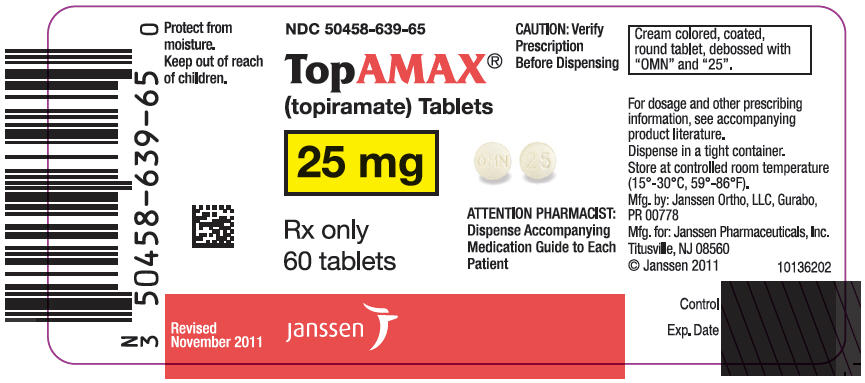 convulsants, in combination with the NSAID
carprofen (Rimadyl) on 33 cavalier King Charles spaniels affected with CM/SM. They
found no significant difference upon the quality-of-life of the treated
dogs, and that either of the two drugs may be more effective than
carprofen alone. They noted that the most common side effect of both
gabapentin and topiramate was sedation, and that an additional effect of
topiramate was inappetence. Overall, side effects of topiramate were
more severe than those of gabapentin.
convulsants, in combination with the NSAID
carprofen (Rimadyl) on 33 cavalier King Charles spaniels affected with CM/SM. They
found no significant difference upon the quality-of-life of the treated
dogs, and that either of the two drugs may be more effective than
carprofen alone. They noted that the most common side effect of both
gabapentin and topiramate was sedation, and that an additional effect of
topiramate was inappetence. Overall, side effects of topiramate were
more severe than those of gabapentin.
The brand names of gabapentin are Neurontin and Gabarone, and the brand name of topiramate is Topamax.
August 2015:
Belgium researchers find computed tomography (CT) can be used to
diagnose syringomyelia in dogs.
 In
an
August 2015 report, a team of Belgium researchers (Kaatje Kromhout
[right], H. van Bree, B.J.G. Broeckx, S. Bhatti, S. De Decker, I.
Polis, I. Gielen) compared computed tomography (CT) and magnetic
resonance (MR) scans of 32 dogs, including 12 cavalier King Charles
spaniels. They found that low-field MR and multislice CT imaging
provided comparable information regarding the presence of SM, and that
CT can be used as a diagnostic tool for SM when MRI is not available.
They conclude, however, that "CT cannot replace MRI as the standard
screening technique for the detection of SM in Cavalier King Charles
Spaniel for breeding purposes." See also the
November 2014 Research News item by the same team of researchers,
reaching the same conclusion.
In
an
August 2015 report, a team of Belgium researchers (Kaatje Kromhout
[right], H. van Bree, B.J.G. Broeckx, S. Bhatti, S. De Decker, I.
Polis, I. Gielen) compared computed tomography (CT) and magnetic
resonance (MR) scans of 32 dogs, including 12 cavalier King Charles
spaniels. They found that low-field MR and multislice CT imaging
provided comparable information regarding the presence of SM, and that
CT can be used as a diagnostic tool for SM when MRI is not available.
They conclude, however, that "CT cannot replace MRI as the standard
screening technique for the detection of SM in Cavalier King Charles
Spaniel for breeding purposes." See also the
November 2014 Research News item by the same team of researchers,
reaching the same conclusion.
June 2015:
Out-crossing Griffon Bruxellois with Australian terrier
reduced Chiari-like malformation and maintained breed standard in second
generation.
 In a June 2015 report at the ACVIM Forum by UK and Dutch
researchers (Susan Knowler, Henny van den Berg [right], Eric Noorman, Roberto La
Ragione, Clare Rusbridge), they crossed a CM-affected Griffon Bruxellois
(GB -- Brussels Griffon) with a normal Australian terrier, and then back-crossed the
offspring to a GB. The test group consisted of 12 dogs in the same
family, which were used in 8 different mating combinations resulting in
19 progeny. They conclude:
In a June 2015 report at the ACVIM Forum by UK and Dutch
researchers (Susan Knowler, Henny van den Berg [right], Eric Noorman, Roberto La
Ragione, Clare Rusbridge), they crossed a CM-affected Griffon Bruxellois
(GB -- Brussels Griffon) with a normal Australian terrier, and then back-crossed the
offspring to a GB. The test group consisted of 12 dogs in the same
family, which were used in 8 different mating combinations resulting in
19 progeny. They conclude:
"The quantitative findings in this study revealed these traits to be significant for CM-affectedness. Furthermore the external phenotypes showed that by outcrossing breed types and selecting appropriate conformation characteristics in the F1 generation, it is possible to regain the GB breed standard in the F2 generation and reduce the degree of CM. However this is dependent on careful selection of conformation and screening for CM and SM at 1 year of age. The 4 dogs affected with SM in the study all exhibited reduced caudal skull development compared to their relatives. We showed that traits on MR images were useful to distinguish the phenotype and these exhibited segregation and may be additive towards the severity of CM. It suggests such traits might be useful to quantify the condition and the risk to SM. We propose that grading of CM takes account of quantitative traits that can be used in Estimated Breeding Values (EBV) to assist breeders with their mate selections. Such a system will have to be verified to ensure appropriateness for all breeds at risk."
May 2015:
US researchers find associations between lesions at the atlantoaxial
junction and SM in cavaliers. In a
May 2015 study of 36
mature cavalier King Charles spaniels (5 to 12 years old), US
researchers (S. Cerda-Gonzalez, N. J. Olby, E. H. Griffith) found:
• 34
had Chiari-like malformation (CM);
• 26 had syringomyelia (SM);
• 20 had
neuropathic pain.
They also report that 31 of the CKCSs had compressive lesions at the "atlantoaxial junction (AA)" (the joint between the atlas and axis -- the first two cervical vetebrae), and 23 of those dogs with AA also had SM. They concluded that the prevalence of AA bands in older cavaliers appears to be high, and there were significant associations among AA bands, clinical signs, and SM in dogs with CM.
A cavalier King Charles spaniel positioned in an
extended/straight position in Figure A, and in a flexion, resembling a standing posture in Figure B. Dorsal atlantoaxial (AA)
band-associated compression (long arrow) is more prominent in flexion
than in extension. A Chiari-like malformation is also present (short
arrow), along with dorsal subarachnoid space dilation cranial to the AA
band.
resembling a standing posture in Figure B. Dorsal atlantoaxial (AA)
band-associated compression (long arrow) is more prominent in flexion
than in extension. A Chiari-like malformation is also present (short
arrow), along with dorsal subarachnoid space dilation cranial to the AA
band.
May 2015:
NC State vet school needs cavaliers with Chiari-like malformation for
pain studies.
 At the North Carolina State veterinary school,
neurologists Natasha Olby and Sofia Cerda-Gonzalez are conducting two
studies of cavaliers with Chiari-like malformation.
At the North Carolina State veterinary school,
neurologists Natasha Olby and Sofia Cerda-Gonzalez are conducting two
studies of cavaliers with Chiari-like malformation.
They expect to use quantitative data from magnetic resonance imaging (MRI) to perform a more appropriate genetic analysis of this important and common disease. The researchers will also investigate sensory thresholds in CM/SM-affected and normal CKCS to improve the ability to document and treat pain in SM patients. The project hopes to define the genetic etiology of the disease with the long-term aim of developing genetic tests for use by breeders, and to quantify the sensory dysfunction experienced by SM-affected dogs to facilitate objective therapeutic trials.
The candidate CKCSs should be over 2.5 years old. Details are outlined here. Contact Courtney Rousse at 919-513-7235 or ckcschiari@gmail.com for more information.
May 2015: Dutch master's student examines MRIs and reports of 848 cavaliers and finds no significant relationship between clinical signs and CM/SM grade. In a May 2015 master's thesis, Netherland's researcher D. L. Schuil reviewed the MRI scans of 848 cavalier King Charles spaniels and answers to questionaires by the dogs' owners. 233 completed surveys were returned. According to the owners 45 dogs had clinical signs (19.3%) and 188 dogs did not (80.7%). From his analysis of the grades of SM and the reported clinical signs, he could not find any significant relationships between the clinical signs and the MRI scans.
April 2015:
US neurologists find association between medullary elevation and signs
of SM, and that brainstem position relates to SM in CKCSs.
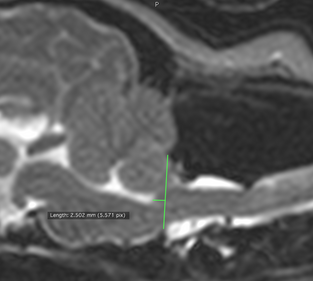 In
an April 2015 study of 36 cavaliers, US neurologists S.
Cerda-Gonzalez, N.J. Olby, and E.H. Griffith reported finding that higher
elevation of kinking of the medulla related to neurological clinical
signs of CM/SM. They also found that brainstem position measurements at
the caudodorsal-most border of the fourth ventricle (called the "obex
position") were associated with both the presence and severity of
syringomyelia. An obex position measurement of ≤3.5 was sensitive (79%)
and highly specific (90%) for the presence of syringomyelia.
In
an April 2015 study of 36 cavaliers, US neurologists S.
Cerda-Gonzalez, N.J. Olby, and E.H. Griffith reported finding that higher
elevation of kinking of the medulla related to neurological clinical
signs of CM/SM. They also found that brainstem position measurements at
the caudodorsal-most border of the fourth ventricle (called the "obex
position") were associated with both the presence and severity of
syringomyelia. An obex position measurement of ≤3.5 was sensitive (79%)
and highly specific (90%) for the presence of syringomyelia.
(The authors' photo at right shows how the position of the brainstem was evaluated by measuring the distance between the obex (the caudodorsal-most border of the fourth ventricle) and a line drawn parallel to the foramen magnum. This was termed the "obex measurement". )
April 2015: More VetCompass analysis shows low diagnoses of CM and SM in cavaliers. In an April 2015 report by UK and Australian veterinarians (Jennifer F Summers, Dan G O’Neill, David B Church, Peter C Thomson, Paul D McGreevy, David C Brodbelt), the veterinary records of 1,875 cavalier King Charles spaniels treated between 2009 and 2013 and on the database of the VetCompass animal health surveillance project, were dissected. Only 75 of the 1,875 cavaliers had a confirmed KC-registration status. Magnetic Resonance Imaging (MRI) confirmed diagnoses of either syringomyelia (SM), Chiari-like malformation (CM) or both were recorded in approximately 2% of study dogs, with SM ranked 28th among the most frequently recorded specific diagnoses. Regarding this statistic, the authors note:
"Including only those diagnoses of either condition made with reference to MRI results (i.e. excluding those suggested by clinical signs alone) could have underestimated the true level in the population, as not all clinically suspicious cases underwent MRI scanning. The sometimes vague nature of clinical signs may result in failure to offer scanning in some cases, while reluctance (or financial limitations) of owners to pursue MRI diagnosis may be the limiting factor in others. Bias linked to comparative willingness to request high level diagnostic investigation may be of particular relevance in breeding animals, if breeders are more (or less) likely to volunteer breeding animals for MRI through screening programs. The link between signs of SM/CM visible on MRI and appearance of clinical signs can also be inconsistent, as not all dogs with a visible syrinx on MRI display clinical signs at the time of imaging."
April 2015:
VetCompass records from 2009-2014 show 37 out of 3,860 CKCSs were
diagnosed by MRI to have CM/SM.
 In an
April 2015 report, a
team of UK and Australian researchers (Claire Thomas, Sandra
Sanchis-Mora, Ludovic Pelligand, Holger Volk, David Church, Paul
McGreevy, Peter Thomson, Dave Brodbelt, Dan O’Neill) examined the
Veterinary Companion Animal Surveillance System (VetCompass) veterinary
clinic records of 187,365 dogs treated from September 2009 to June 2014,
to find how many were diagnosed as affected with Chiari-like
malformation/syringomyelia (CM/SM) by MRI scans. They found 59 CM/SM
cases, of which 37 were cavalier King Charles spaniels (CKCS), out of a
CKCS population of 3,860, a CKCS breed prevalence of 0.96%. Practitioners had reported that 84 additional
cavaliers were suspected of having CM/SM but were unconfirmed. Other
breeds found to be affected were: King Charles Spaniels [a/k/a English
toy spaniels] (12 dogs), crossbreed (3 dogs), Yorkshire Terrier (2
dogs), and Affenpinscher, Pug, English Toy Spaniel, Jack Russell Terrier
and Chihuahua (1 dog each).
In an
April 2015 report, a
team of UK and Australian researchers (Claire Thomas, Sandra
Sanchis-Mora, Ludovic Pelligand, Holger Volk, David Church, Paul
McGreevy, Peter Thomson, Dave Brodbelt, Dan O’Neill) examined the
Veterinary Companion Animal Surveillance System (VetCompass) veterinary
clinic records of 187,365 dogs treated from September 2009 to June 2014,
to find how many were diagnosed as affected with Chiari-like
malformation/syringomyelia (CM/SM) by MRI scans. They found 59 CM/SM
cases, of which 37 were cavalier King Charles spaniels (CKCS), out of a
CKCS population of 3,860, a CKCS breed prevalence of 0.96%. Practitioners had reported that 84 additional
cavaliers were suspected of having CM/SM but were unconfirmed. Other
breeds found to be affected were: King Charles Spaniels [a/k/a English
toy spaniels] (12 dogs), crossbreed (3 dogs), Yorkshire Terrier (2
dogs), and Affenpinscher, Pug, English Toy Spaniel, Jack Russell Terrier
and Chihuahua (1 dog each).
Other statistics in the study: (a) the median (interquartile range) age at diagnosis was 4.33 years; (b) the most common clinical signs associated with CM/SM were expression of pain (14 dogs), characteristic CM/SM-associated motor signs (scratching or facial rubbing without underlying skin disease) (11 dogs) and ataxia or weakness (7 dogs). Analgesics (alone or in combination) were prescribed to 49 cases, the most common analgesic treatments being gabapentin (32 dogs), NSAIDs (18 dogs), glucocorticoids (30 dogs) and tramadol (13 dogs). Practitioners reported 31 dogs (63.26%) showed apparent clinical improvement following treatment.
EDITOR'S NOTE: The significance of these statistics regarding the percentage of CM/SM in the cavalier needs to be taken with a giant grain of salt. First of all, they contradict nearly all findings of the percentages of CM/SM within the CKCS in other studies. This study may be a "consider the source" situation, and several questions come to mind. Like, do most general practice vets even know enough about SM to recognize the need for MRIs? And, what role did insurance play in the vets' decisions about having MRI scans performed? We suspect this report properly will be marked down as a gross anomaly.
April 2015: UK research finds no correlation between barometric pressure changes and comfort levels of cavaliers with CM/SM. In an April 2015 report, UK researchers William Warman, Edward Ives, and Clare Rusbridge compared daily barometric pressure changes with the comfort levels (reported by dogs' owners) of 22 cavalier King Charles spaniels (CKCS) affected by Chiari malformation and syringomyelia (CM/SM) for 3 months. They found no evidence supporting an association between barometric pressure and the degree of discomfort experienced by CKCS with CM/SM.
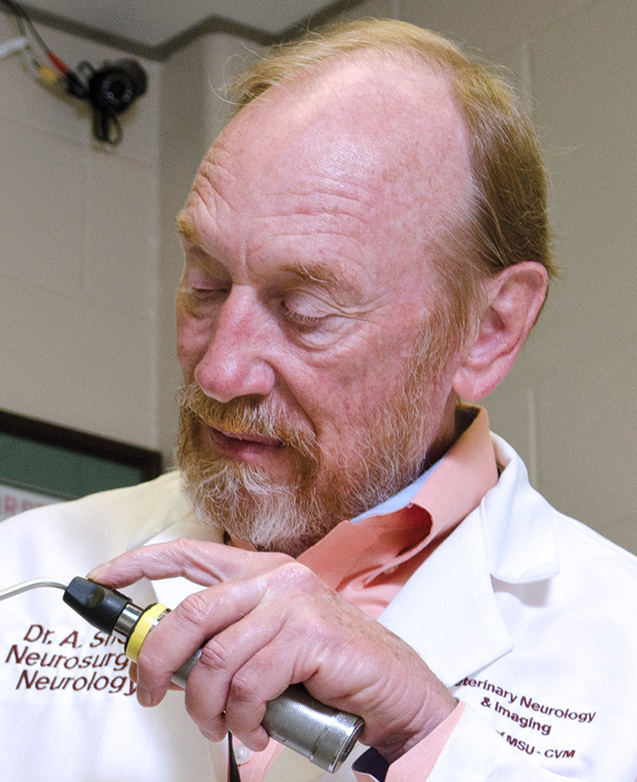 March 2015:
Mississippi State University surgeons report long-term success of
Chiari-like malformation surgeries. In a
March 2015 report,
the neuro-surgery team at Mississippi State University (N. Ortinau, S.
Vitale, E. Y. Akin, M. Beasley, Andy Shores, right) surveyed 17 patients
following foramen magnum decompression surgeries over three years. They
found that none of the dogs has required additional surgery to date, and
that all but one had some improvement in quality of life after surgery,
and none were judged to deteriorate to less than the pre-surgical
status. They concluded that the surgical procedure, combined with
medical therapy, resulted in favorable long-term outcomes.
March 2015:
Mississippi State University surgeons report long-term success of
Chiari-like malformation surgeries. In a
March 2015 report,
the neuro-surgery team at Mississippi State University (N. Ortinau, S.
Vitale, E. Y. Akin, M. Beasley, Andy Shores, right) surveyed 17 patients
following foramen magnum decompression surgeries over three years. They
found that none of the dogs has required additional surgery to date, and
that all but one had some improvement in quality of life after surgery,
and none were judged to deteriorate to less than the pre-surgical
status. They concluded that the surgical procedure, combined with
medical therapy, resulted in favorable long-term outcomes.
March 2015:
Flanders, Belgium requires CM/SM and MVD testing of cavalier breeding
stock. The government of
the Flemish region of Belgium announced on March 3, 2015, new breeding
rules for cavalier King Charles spaniels, requiring that all breeding
stock be tested for mitral valve disease (and Chiari-like malformation
and syringomyelia) in order for litters to be registered by the Flemish
government. Twenty other breeds also will now have additional testing
requirements.
The government of
the Flemish region of Belgium announced on March 3, 2015, new breeding
rules for cavalier King Charles spaniels, requiring that all breeding
stock be tested for mitral valve disease (and Chiari-like malformation
and syringomyelia) in order for litters to be registered by the Flemish
government. Twenty other breeds also will now have additional testing
requirements.
 Joke Schauvliege (left),
Flemish Minister for Environment, Nature and Agriculture, signed the
ministerial decision, which will come into force, along with details of
the testing procedures, 10 days after official publication in the
government's journal, which is expected to occur in April. The new
regulation is the result of a study ordered by Minister Schauvliege two
years ago, involving the calculation of the genetic diversity and most
common health problems in the 21 breeds, which also includes the
Schipperke, Papillon, Bichon Frise, Groenendael, Petit Brabancon,
Ardennes cattle dog, Laekenois, Bloodhound, Golden Retriever, Irish
setter and border collie.
Joke Schauvliege (left),
Flemish Minister for Environment, Nature and Agriculture, signed the
ministerial decision, which will come into force, along with details of
the testing procedures, 10 days after official publication in the
government's journal, which is expected to occur in April. The new
regulation is the result of a study ordered by Minister Schauvliege two
years ago, involving the calculation of the genetic diversity and most
common health problems in the 21 breeds, which also includes the
Schipperke, Papillon, Bichon Frise, Groenendael, Petit Brabancon,
Ardennes cattle dog, Laekenois, Bloodhound, Golden Retriever, Irish
setter and border collie.
RETURN TO TOP
2014 News
November 2014:
UK researchers find asymptomatic cavaliers with a syrinx appear more
likely to display clinical signs later in life than those without.
 In
a
November 2014 study of 79 cavalier King Charles spaniels without any
symptoms related to Chiari-like malformation or syringomyelia, a team of
researchers (Edward J. Ives [right], L. Doyle, M. Holmes, T.L. Williams, A.E.
Vanhaesebrouck) at the Queen's Veterinary School Hospital, University of
Cambridge in the UK investigated an association of magnetic resonance
imaging findings in asymptomatic dogs and clinical signs in later life.
They found that a significantly greater proportion of CKCSs with a
syrinx visible on MRI screening showed clinical signs in later life
(9/25, 36%) than dogs without a visible syrinx (4/54, 7%). However, they
concluded that whether their findings can be used to indicate the
likelihood of an asymptomatic CKCS developing clinical signs consistent
with SM in later life warrants further study with a larger group of
dogs.
In
a
November 2014 study of 79 cavalier King Charles spaniels without any
symptoms related to Chiari-like malformation or syringomyelia, a team of
researchers (Edward J. Ives [right], L. Doyle, M. Holmes, T.L. Williams, A.E.
Vanhaesebrouck) at the Queen's Veterinary School Hospital, University of
Cambridge in the UK investigated an association of magnetic resonance
imaging findings in asymptomatic dogs and clinical signs in later life.
They found that a significantly greater proportion of CKCSs with a
syrinx visible on MRI screening showed clinical signs in later life
(9/25, 36%) than dogs without a visible syrinx (4/54, 7%). However, they
concluded that whether their findings can be used to indicate the
likelihood of an asymptomatic CKCS developing clinical signs consistent
with SM in later life warrants further study with a larger group of
dogs.
November 2014:
Belgian researchers find no significant difference
between CT scans and MRI scans detecting Chiari-like malformation in
cavaliers.
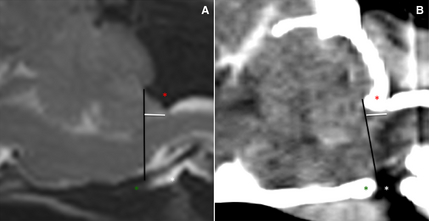 In
a November 2014 study
of 15 cavalier King Charles spaniels
by a team of Belgian researchers, they compared computed tomography (CT)
scans with MRI scans and analyzing them statistically, they found "no
significant difference between the different observers and techniques
for the detection of CH [cerebellar herniation] and measurement of CHL
[cerebellar herniation length]." However, they found, "Overall, the CHL
was longer on the CT images." They concluded:
In
a November 2014 study
of 15 cavalier King Charles spaniels
by a team of Belgian researchers, they compared computed tomography (CT)
scans with MRI scans and analyzing them statistically, they found "no
significant difference between the different observers and techniques
for the detection of CH [cerebellar herniation] and measurement of CHL
[cerebellar herniation length]." However, they found, "Overall, the CHL
was longer on the CT images." They concluded:
"Both techniques are useful for detecting CH and measuring CHL. Because CHL does not have a known direct impact on the clinical presentation of CM, CT can be used as a diagnostic tool in a routine clinical practice for CM in CKCS when MRI is not available. We emphasize that MRI is the standard screening technique in CKCS for breeding purposes to detect the presence of CM and SM and, at the current time, CT cannot replace MRI."
The two images above are (A) an MRI midsagittal T2WSE image and (B) a postcontrast CT image (soft tissue window) of the brain of the same CKCS. The supraoccipital bone (red asterisk), basioccipital bone (green asterisk) and occipitoatlantoaxial joint is visible (white asterisk). The foramen magnum limit is set (black line) from the rostrodorsal aspect of the supraoccipital bone to the most caudal aspect of the basioccipital bone. The cerebellar herniation length (mm, white line) is measured caudal from the foramen magnum. See also, this March 2014 item below.
 November
2014:
Colin Driver joins the UK's Canine Chiari and Syringomyelia Research
Group. Colin John Driver (right), BSc
BVetMed(Hons) MVetMed PhD DipECVN MRCVS, and European Specialist in
Veterinary Neurology and Neurosurgery, has left private practice in
Hampshire to join the Canine Chiari and Syringomyelia Research Group at
Fitzpatrick Referrals and the University of Surrey in the UK. He will
continue work on his Ph.D. thesis entitled “The pathogenesis of
syringomyelia secondary to Chiari-like malformation in dogs” at the
University of Ghent in Belgium.
November
2014:
Colin Driver joins the UK's Canine Chiari and Syringomyelia Research
Group. Colin John Driver (right), BSc
BVetMed(Hons) MVetMed PhD DipECVN MRCVS, and European Specialist in
Veterinary Neurology and Neurosurgery, has left private practice in
Hampshire to join the Canine Chiari and Syringomyelia Research Group at
Fitzpatrick Referrals and the University of Surrey in the UK. He will
continue work on his Ph.D. thesis entitled “The pathogenesis of
syringomyelia secondary to Chiari-like malformation in dogs” at the
University of Ghent in Belgium.
October 2014: Syringomyelia in South African cavaliers is 41%. South African veterinary neurologist A. J. Carter reported in a paper before the World Small Animal Veterinary Assosciation Congress (WSAVA) in September 2014 that SM "is highly prevalent within the South African Cavalier King Charles Spaniels." He found that the prevalence is 41%.
October 2014:
Three
definitions of Chiari-like malformation are compared in asymptomatic
non-CKCS dogs.
 In an
October 2014 study by a team of UK researchers (T.R.
Harcourt-Brown (right), J. Campbell, C. Warren-Smith, N.D. Jeffery, N.P.
Granger), they examined MRI scans of 199 dogs -- 14 cavaliers and 185
dogs of
other breeds -- to establish the prevalence of Chiari-like malformation
(CM) in non-CKCS dogs which met three different defintions of CM. The
three definitions are:
In an
October 2014 study by a team of UK researchers (T.R.
Harcourt-Brown (right), J. Campbell, C. Warren-Smith, N.D. Jeffery, N.P.
Granger), they examined MRI scans of 199 dogs -- 14 cavaliers and 185
dogs of
other breeds -- to establish the prevalence of Chiari-like malformation
(CM) in non-CKCS dogs which met three different defintions of CM. The
three definitions are:
1. Indentation: "Indentation of the caudal aspect of the cerebellum -- defined as a concave, rather than flattened or convex, caudal border of the cerebellum."
2. Impaction: "Impaction of the cerebellar vermis into the foramen magnum -- defined as deformation of the shape of caudo-ventral vermis into a point such that the angle between lines drawn along the caudal and ventral borders of the cerebellum meet at an acute, rather than an obtuse, angle. This definition was considered analogous to descent into the foramen magnum that has been used previously."
3. Herniation: "Herniation of the cerebellar vermis through the foramen magnum -- defined as extension of the cerebellar vermis caudal to a line drawn between the ventral aspect of the supraoccipital bone (opisthion) and the caudal border of the basioccipital bone (basion)."
They found that, among the 185 non-CKCS dogs, indentation was identified in 44% and impaction in 22%. No non-CKCS dogs showed herniation; 29% of CKCSs showed herniation (11–55%). They concluded:
"We conclude there is a high prevalence of cerebellar indentation and impaction in the normal canine population, suggesting they are unreliable as defining factors for CM. Our data supported the hypothesis that some measures of brachycephaly are associated with indentation or impaction, but the overlap in these measurements among breeds showed that construction of control groups based on subjective assessment of skull type could be inappropriate. Instead, it may be better for future studies investigating the relationship between abnormalities of the caudal cranial fossa and clinical signs or syringomyelia to define control groups based on the absence of specific anatomical features considered important (eg, cerebellar herniation, obstruction to CSF flow at the foramen magnum)."
EDITOR'S NOTE: It appears that the authors of this study divided one definition of CM into three -- indentation, impaction, and herniation. But herniation always has been part of the definition of CM, so to find other breeds with indentation and impaction but no herniation -- as this study found no herniation among the non-CKCSs -- does not mean these other breeds had CM. It just means the other dogs did not have CM.
October 2014: SM study of all cavaliers registered in Denmark in 2001 shows 15.4% have SM symptoms after age 6 years. In a 6+ year study of all 240 cavalier King Charles spaniels registered in Denmark in 2001, the researchers found that 15.4% had SM symptoms after age 6 years, and that 93% of asymptomatic SM dogs remained asymptomatic at age 6 years. Thirteen symptomatic and 9 asymptomatic siblings participated in a litter study. 21 of 22 littermates had syrinxes (95%). Syrinx diameter and mean syrinx : spinal cord ratio were significantly correlated with clinical signs (P < .01). Estimated heritability of symptomatic SM was 0.81. They concluded that the prevalence of symptomatic SM is high and that genetics have a high impact on clinical disease expression.
August 2014: Study
of 84 American Brussels Griffons finds syringomyelia and Chiari-like
malformation to be prevalent.
 In an
August 2014 study of 84 "American" Brussels Griffon dogs,
researchers A.C. Freeman, S.R. Platt, M. Kent, E. Huguet, C. Rusbridge,
and S. Holmes found that SM and CM are "prevalent" and that "Syrinx size
is associated with neurologic deficits, CM, larger ventricles, a smaller
craniocervical junction height, neurologic deficits, and cerebellar
herniation."
In an
August 2014 study of 84 "American" Brussels Griffon dogs,
researchers A.C. Freeman, S.R. Platt, M. Kent, E. Huguet, C. Rusbridge,
and S. Holmes found that SM and CM are "prevalent" and that "Syrinx size
is associated with neurologic deficits, CM, larger ventricles, a smaller
craniocervical junction height, neurologic deficits, and cerebellar
herniation."
The stats: 65% had CM. 52% had SM. 28% had neurologic deficits and 20% had neck pain. 52% of the SM dogs were clinically normal.
July 2014: UK researchers find two aspects of cavalier skull conformation are associated with the development of SM. A team of UK veterinary neurology researchers, Thomas J. Mitchell, Susan P. Knowler, and Clare Rusbridge, and consultants in the Netherlands and Canada, Henny van den Berg and Jane Sykes, examined the skulls of 133 cavaliers to determine if skull measurements could predict the presence or development of syringomyelia (SM), They found that as the dog's cranium is shortened and broadened, the risk of developing SM increases. They stated in their July 2014 article:
"The study found two aspects of conformation to be associated with the development of SM in the CKCS: the cephalic index and the distribution of cranium across the length of the head. It was found that a higher cephalic index and, separately, a lower percentage of the cranium distributed caudally [towards the back of the head] were significantly associated with disease development."
"The cephalic index is the ratio of the width of the cranium of an organism (taken behind the cheekbones in this study) divided by its length (i.e., in the horizontal plane, or front to back). It is usually expressed as a %. It differs from craniofacial index in that it does not relate to the length of the muzzle."
"The conformational indicator of caudal cranium distribution was found to significantly, correctly classify cases as SM clear or affected at the level of three years of age, five years of age, and when comparing a sample of SM clear dogs over five years to those affected and younger than three. Cephalic index was able to significantly, correctly classify cases at the latter level. Results suggest that these indicators are irrelevant of age (after 18 months of age), gender and parity. These, therefore, represent invaluable tools in determining breeding plans in that they are not only protective against developing the condition in the first three years of life but they are protective against developing the condition at all, maintaining SM clear status beyond the age of five years."
See also a YouTube video explaining this article.
July 2014:
UK's Royal Veterinary College seeks CKCSs for neuropathic pain
assessment study.
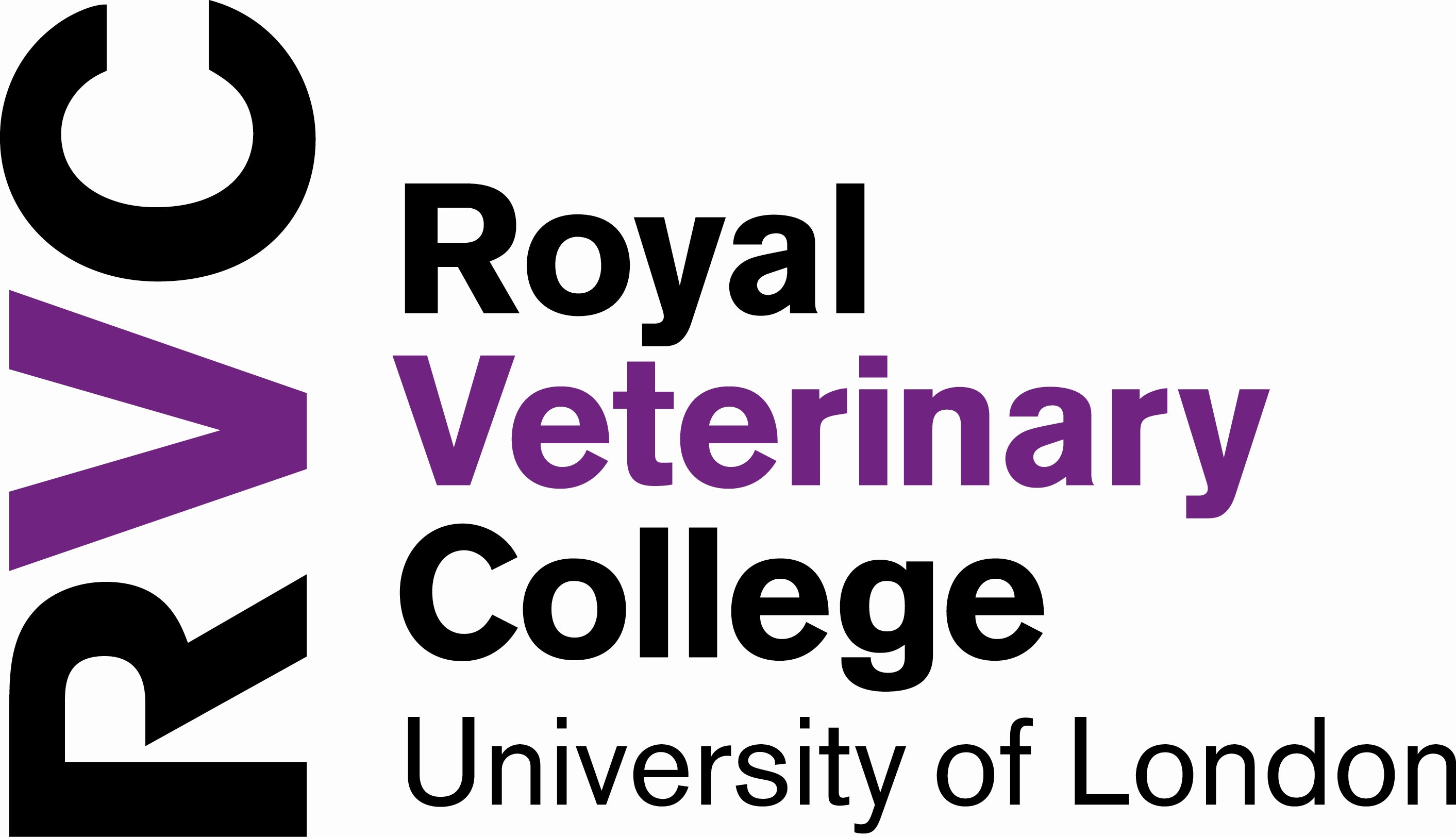 The Royal Veterinary College is
conducting a study of clinical signs and behaviors which predict
presence or severity of neuropathic pain in cavalier King Charles
spaniels with Chiari-like malformation and syringomyelia. In this study,
RVC proposes to identify if thermal and pressure sensory testing
improves clinical assessments of neuropathic pain in dogs. RVC is
recruiting healthy UK CKCSs and cavaliers affected by CM/SM and their
owners to participate in the development of an owner questionnaire and
the validation of a sensory testing protocol to be used to evaluate
severity of NeP and response to treatment. This is a non-invasive and
interactive study for both pets and their owners. For further
information, please contact:Sandra Sandlis at neyropathucpain@rvc.ac.uk
or 01707 666605.
The Royal Veterinary College is
conducting a study of clinical signs and behaviors which predict
presence or severity of neuropathic pain in cavalier King Charles
spaniels with Chiari-like malformation and syringomyelia. In this study,
RVC proposes to identify if thermal and pressure sensory testing
improves clinical assessments of neuropathic pain in dogs. RVC is
recruiting healthy UK CKCSs and cavaliers affected by CM/SM and their
owners to participate in the development of an owner questionnaire and
the validation of a sensory testing protocol to be used to evaluate
severity of NeP and response to treatment. This is a non-invasive and
interactive study for both pets and their owners. For further
information, please contact:Sandra Sandlis at neyropathucpain@rvc.ac.uk
or 01707 666605.
May 2014: US neurologists find that high compression lesions due to thickened dural bands may relate to more severe pain and more severe syringomyelia in cavaliers. In a May 2014 abstract prepared for the June 2014 ACVIM Forum, USA Drs. S. Cerda-Gonzalez, N.J. Olby, E.H. Griffith assessed 36 cavalier King Charles spaniels for neurologic pain and dysfunction. They found that 20 of the dogs demonstrated neuropathic pain; that dural bands (compressive lesions caused by abnormally thickened dura matter at the craniocervical junction) were present in 31 of the dogs; that 34 of the dogs had Chiari-like malformation; that 23 of the dogs had syringomyelia (and 21 of those 23 dogs had dural bands). They also found that dural bands were associated with both the presence and severity of clinical signs and the presence of SM, and that higher compression indices were associated with more severe SM. They concluded that:
"Dural bands appear to play a significant clinical role. Compression indices provide a better assessment of dural band severity compared to grading."
May 2014:
German researchers compare CKCSs with other breeds and find body weight
can affect brain volumes, but no brain volume difference between CKCSs
with and without SM. In a
May 2014 study, a team of German
neurologists and other specialists (Martin J Schmidt, Kerstin H Amort,
 Klaus Failing, Melanie Klingler, Martin Kramer and Nele Ondreka,
all of Justus-Liebig-University in Giessen, Germany)
compared 20 cavaliers with SM and 20 cavaliers without SM and 35 brachycephalic dogs of other breeds and 35 non-brachycephalic dogs of
other breeds, to determine if their brain volumes were affected by their
body weights. They report that they could not find a difference in
absolute or relative brain volumes between CKCSs with and without SM
after relating these values to body weight; and that relative volume of
the hindbrain parenchyma (caudal fossa parenchyma percentage) was larger
in brachycephalic dogs than in CKCSs, without causing herniation or SM.
They concluded that:
Klaus Failing, Melanie Klingler, Martin Kramer and Nele Ondreka,
all of Justus-Liebig-University in Giessen, Germany)
compared 20 cavaliers with SM and 20 cavaliers without SM and 35 brachycephalic dogs of other breeds and 35 non-brachycephalic dogs of
other breeds, to determine if their brain volumes were affected by their
body weights. They report that they could not find a difference in
absolute or relative brain volumes between CKCSs with and without SM
after relating these values to body weight; and that relative volume of
the hindbrain parenchyma (caudal fossa parenchyma percentage) was larger
in brachycephalic dogs than in CKCSs, without causing herniation or SM.
They concluded that:
"An influence of body weight exist in dogs, which can be sufficiently large to render conclusions on the difference in volumes of the brain and skull unsafe unless some account of the body weight is taken in the analysis. The results of this study challenge the role of overcrowding for the development of SM in dogs."
 April
2014:
UK's Dogs Trust funds the search for genes for syringomyelia and painful
Chiari-malformation in cavaliers. The UK's Dog Trust has
awarded the University of Surrey a major grant to fund "Identification
of gene(s) predisposing to syringomyelia associated with Chiari-like
malformation in the Cavalier King Charles". Dr. Clare Rusbridge will
lead the research in collaboration with Dr. Zoha Kibar, of the Montreal
University CHUM Research Centre. The team plans to use an approach
called "Qualitative Trait Locus" (QTL) analysis which involved linking
two types of information -– phenotypic data (trait measure-ments) and
genotypic data (usually molecular markers) -- in an attempt to explain
the genetic basis of variation and to find a genetic cause for both
painful Chiari-malformation and syringomeylia in the breed and lead to
improved diagnosis and treatment options.
April
2014:
UK's Dogs Trust funds the search for genes for syringomyelia and painful
Chiari-malformation in cavaliers. The UK's Dog Trust has
awarded the University of Surrey a major grant to fund "Identification
of gene(s) predisposing to syringomyelia associated with Chiari-like
malformation in the Cavalier King Charles". Dr. Clare Rusbridge will
lead the research in collaboration with Dr. Zoha Kibar, of the Montreal
University CHUM Research Centre. The team plans to use an approach
called "Qualitative Trait Locus" (QTL) analysis which involved linking
two types of information -– phenotypic data (trait measure-ments) and
genotypic data (usually molecular markers) -- in an attempt to explain
the genetic basis of variation and to find a genetic cause for both
painful Chiari-malformation and syringomeylia in the breed and lead to
improved diagnosis and treatment options.
April 2014:
Researchers identify two
genomic regions associated with Chiari-like malformation (CM) in the Brussels
Griffon.
 In an
April 2014 report, a team of geneticists and
neurologists led by Dr. Zoha Kibar (others: Philippe Lemay, Susan P.
Knowler [right], Samir Bouasker, Yohann Nédélec, Simon Platt, Courtenay Freeman,
Georgina Child, Luis B. Barreiro, Guy A. Rouleau, and Clare Rusbridge)
has identified two DNA regions strongly associated with Chiari-like
malformation in the Griffon Bruxellois dog. Using a quantitative trait
locus (QTL) approach linking DNA molecular markers with MRI information,
they were able to identify the two novel genomic regions involved in
development of the skull and which also have been associated with a
disease linked to Chiari malformation in humans. However, this is just
another step towards a hopeful solution to CM and SM in this breed. As
they state at the end of their report:
In an
April 2014 report, a team of geneticists and
neurologists led by Dr. Zoha Kibar (others: Philippe Lemay, Susan P.
Knowler [right], Samir Bouasker, Yohann Nédélec, Simon Platt, Courtenay Freeman,
Georgina Child, Luis B. Barreiro, Guy A. Rouleau, and Clare Rusbridge)
has identified two DNA regions strongly associated with Chiari-like
malformation in the Griffon Bruxellois dog. Using a quantitative trait
locus (QTL) approach linking DNA molecular markers with MRI information,
they were able to identify the two novel genomic regions involved in
development of the skull and which also have been associated with a
disease linked to Chiari malformation in humans. However, this is just
another step towards a hopeful solution to CM and SM in this breed. As
they state at the end of their report:
"While QTL analysis represents a strong tool used to identify associations between multiple traits and diseases, our limited cohort size did not suffice to obtain a strong genetic portrait of this complex disease. While the genetic complexity of this disease has probably been reduced by the high homogeneity of a purebred dog, it remained largely oligogenic and no single major locus could be found. However, our study has successfully identified new QTL associated to CM and provides novel insights into the complex genetics of this disease. Clearly additional genetic studies in larger cohorts and/or novel genomic approaches (for example whole genome or targeted exome sequencing) are needed to further investigate these regions and better define their contribution to CM in the dog."
March 2014: German doctorate dissertation concurs that the causes of Chiari-like malformation and syringomyelia are related to a growth disturbance of the cranial base .A German doctoral student, Annabell Johanna Grübmeyer, reports in her January 2014 dissertation that all 107 cavaliers examined by computed tomography and MRI had Chiari-like malformation and that 63 of the CKCSs had syringomyelia. The purposes of the study were to determine if a shortening of the cranial base give rise to pathological changes in CM and the development of SM, and if there is a difference in the cranial base length with or without syringomyelia. She found that the incidence of SM correlated with age and indices of skull base, presphenoid, and basisphenoid, with reduced lengths of the cranial base, presphenoid, and the basioccipital bones and an increase in breadth in dogs with syringomyelia. She concluded that the results support the assumption that the cause of the Chiari-like malformation and syringomyelia is up to a growth disturbance of the cranial base.
March 2014:
Belgium researchers find computed tomography (CT) can be used to diagnose
 Chiari-like
malformation in CKCSs. In a
2013 study of nine cavaliers with neurological disorders, a team of
Ghent University (Belgium) veterinary radiologists compared the dogs' MRIs
and computed tomographs (CTs) and concluded:
Chiari-like
malformation in CKCSs. In a
2013 study of nine cavaliers with neurological disorders, a team of
Ghent University (Belgium) veterinary radiologists compared the dogs' MRIs
and computed tomographs (CTs) and concluded:
"The statistical analysis suggested that both techniques are useful for detecting CH [cerebellar herniation]. However because the bias was significantly different from zero, one of the methods consistently led to the determination of longer or shorter HL [cerebellar herniation length] than the other method. For most comparisons, the HL was on average longer on CT. MRI provides greater soft tissue detail with no beam-hardening artifacts, which may improve the delineation of the cerebellum. Because HL does affect a diagnosis of CM, so CT can be used as a primary diagnostic tool for diagnosing CM in CKSs when MRI is not available."
Editor's Note: Since this study was limited to detecting Chiari-like malformation, there remains a question of the comparative value of CT-scanning for diagnosing syrinxes.
March 2014: Syringomyelia in Hong Kong Pet Population: 2003-2013. In a review of MRIs of 182 dogs in Hong Kong, in a September 2013 abstract before the 26th Symposium of the ESVN-ECVN (published in March 2014), researchers found only four cavalier King Charles spaniels had SM. The most common breed was the Pomeranian (62 cases), followed by the Chihuahua (36 cases), and the Yorkshire terrier (20 cases).
March 2014:
Danish
study finds 15.4% CKCSs with symptomatic SM and progression from
 asymptomatic
to symptomatic as late as after 6 years. In a multi-year study by a
team of researchers at the University of Copenhagen -- M.S. Thofner,
A.A. Madry, C.S. Stougaard, C.S. Knudsen, H. Berg, C.S.E. Jensen, R.M.L.
Handby, and M. Berendt -- of all 240 cavaliers
born and registered in Denmark in 2001, they report in
a September 2013 abstract before the 26th Symposium of the ESVN-ECVN
(published in March 2014):
asymptomatic
to symptomatic as late as after 6 years. In a multi-year study by a
team of researchers at the University of Copenhagen -- M.S. Thofner,
A.A. Madry, C.S. Stougaard, C.S. Knudsen, H. Berg, C.S.E. Jensen, R.M.L.
Handby, and M. Berendt -- of all 240 cavaliers
born and registered in Denmark in 2001, they report in
a September 2013 abstract before the 26th Symposium of the ESVN-ECVN
(published in March 2014):
"This study found a high prevalence (15.4%) of symptomatic SM in the Danish CKCS population and revealed that despite positive SM findings on MRI, affected dogs may be clinically silent. Asymptomatic dogs may develop clinical signs rather late in life (in this study after the age of six). Despite the high number of affected dogs, euthanasia motivated by SM is relatively moderate. From a clinical point of view our results necessitate further examination of the progression of the disease and assessment of the threshold of outbreak of clinical symptoms."
February 2014:
UK researchers find skulls of Brussels Griffons with Chiari-like
malformation
 have
skull-shape differences. In a
February 2014 article,
UK researchers Susan P. Knowler, Angus K. McFadyen, Courtenay
Freeman, Marc Kent, Simon R. Platt, Zoha Kibar, and Clare
Rusbridge, compared 155
Brussels Griffons with Chiari-like malformation (CM) to normal Griffons.
They found that Griffons with CM had taller foreheads and that the CM had
caused the shape of the brain to change, with severely affected animals
having their cerebellum pushed underneath the main part of the brain. They
have included a
YouTube video showing a normal Griffon's skull and brain morphing into
one with Chiari-like malformation.
have
skull-shape differences. In a
February 2014 article,
UK researchers Susan P. Knowler, Angus K. McFadyen, Courtenay
Freeman, Marc Kent, Simon R. Platt, Zoha Kibar, and Clare
Rusbridge, compared 155
Brussels Griffons with Chiari-like malformation (CM) to normal Griffons.
They found that Griffons with CM had taller foreheads and that the CM had
caused the shape of the brain to change, with severely affected animals
having their cerebellum pushed underneath the main part of the brain. They
have included a
YouTube video showing a normal Griffon's skull and brain morphing into
one with Chiari-like malformation.
In an accompanying press release, Dr. Rusbridge stated:
"Our latest discoveries will be significant in driving this research forward and hopefully allow us to identify which genes may be associated with the condition. Our next steps will be to apply our technique to other breeds with Chiari malformation and investigate more sophisticated ways of screening, so that risk of disease can be detected more easily, at an earlier age and with a single MRI scan.
"We want to engage breeders and give them practical advice about the condition, but it is also important that the public recognises that breeding dogs in a certain way to influence how they look might not be in the animal’s best interest. There are responsible breeders out there, who have invested in screening and who are breeding for health as well as producing attractive puppies, and it is vital that people only look to buy from them."
In their report, the authors conclude:
"This study supports the view that CM is a multifactorial condition that includes the shortening of the entire basicranium, loss of convexity of the supraoccipital bone, invagination of the cerebellum under the occipital lobes and possibly by increased proximity of the atlas to the occiput. As a compensatory change, there is increased height of the rostral cranial cavity and lengthening of the dorsal cranial vault. Overcrowding in the caudal cranial fossa and the craniocervical junction is a defining feature. The study provides the basis of a quantitative assessment of CM which might identify risk of syringomyelia and suggests that CM should be redefined so that account is taken of the overcrowding of the entire cranial fossa and craniocervical junction with reorganization of the brain.
January
2014:
Dr. Penny Watson looks for ties between fibrosis in MVD, SM, and chronic
 pancreatitis in CKCSs. Dr. Penny Watson (right) of UK's Cambridge University's veterinary school is
spearheading a new study into whether several of the CKCS breed's hereditary
health problems are the result of the same genetic defect. Specifically, she
intends to explore the possibility that disparate cavalier diseases,
including mitral valve disease (MVD), syringomyelia (SM), and chronic
pancreatitis are connected at the cellular level by unusual patterns of
fibrotic changes. "Pronounced perivescular fibrosis", a feature in dogs with
chronic pancreatitis, also has been tied to a condition of the central
nervous system in cavaliers with SM. Dr. Watson has suggested that
deterioration of cavaliers' mitral valves also may be a result of a process
connected to the causes of fibrosis.
pancreatitis in CKCSs. Dr. Penny Watson (right) of UK's Cambridge University's veterinary school is
spearheading a new study into whether several of the CKCS breed's hereditary
health problems are the result of the same genetic defect. Specifically, she
intends to explore the possibility that disparate cavalier diseases,
including mitral valve disease (MVD), syringomyelia (SM), and chronic
pancreatitis are connected at the cellular level by unusual patterns of
fibrotic changes. "Pronounced perivescular fibrosis", a feature in dogs with
chronic pancreatitis, also has been tied to a condition of the central
nervous system in cavaliers with SM. Dr. Watson has suggested that
deterioration of cavaliers' mitral valves also may be a result of a process
connected to the causes of fibrosis.
The CKCS breed's documented overabundance of serotonin, a neurotransmitter protein, has been identified as a plausible mechanism which may trigger the development of fibrotic changes in the heart's valves. Her study entails establishing primary stellate cell (SC) cultures from CKCS and define 5HT receptor subtype expression. Stellate cell (SC) activation is a key event in the development of hepatic and pancreatic fibrosis. Serotonin has been shown to activate SCs via 5HT receptors. The study is measuring the response of these cells to serotonin and other stimulators of fibrosis. She then intends to attempt to block SC activation in vitro using 5HTreceptor antagonists. Increased understanding of the factors driving fibrosis will be of benefit to the CKCS and may allow a drug trial in the breed.
RETURN TO TOP
2013 News
 November
2013:
Univ. of Glasgow thesis reports MRI noise causes hearing loss and
reduced cochlear
function in dogs. In a
2013 Master of Science (Research) thesis at the University of
Glasgow, Rebecca Elisabeth Venn reports that all of 36 dogs
(including four cavalier King Charles spaniels) which underwent MRI
scans, experienced reduced cochlear function and more than half of
the 36 dogs had hearing loss using Distortion Product Otoacoustic
Emissions (DPOAE) testing. Ms. Venn noted that the post-MRI testing
was not repeated weeks after the MRIs, so it is not known if the
hearing loss was temporary or permanent. She also noted that
evidence from human MRI noise exposure suggests that the hearing
loss is temporary. She recommends that "all dogs having MRI studies
performed should have ear protection as a standard precautionary
measure."
November
2013:
Univ. of Glasgow thesis reports MRI noise causes hearing loss and
reduced cochlear
function in dogs. In a
2013 Master of Science (Research) thesis at the University of
Glasgow, Rebecca Elisabeth Venn reports that all of 36 dogs
(including four cavalier King Charles spaniels) which underwent MRI
scans, experienced reduced cochlear function and more than half of
the 36 dogs had hearing loss using Distortion Product Otoacoustic
Emissions (DPOAE) testing. Ms. Venn noted that the post-MRI testing
was not repeated weeks after the MRIs, so it is not known if the
hearing loss was temporary or permanent. She also noted that
evidence from human MRI noise exposure suggests that the hearing
loss is temporary. She recommends that "all dogs having MRI studies
performed should have ear protection as a standard precautionary
measure."
November 2013: Finnish Kennel Club sets official SM scanning guidelines; to publish results. The Finnish Kennel Club has established a set of official scanning guidelines for syringomyelia. It also will begin publishing the results for SM-scanned dogs in January 2014. See details (in Finnish only) here.
October
2013:
Dr. Rusbridge summarizes the current status of CM/SM research.
In a wide- ranging article published in the
Autumn 2013 EJCAP Online issue for the Federation of European
Companion Animal Veterinary Associations (FECAVA), Dr. Clare
Rusbridge thoroughly summarizes the current status of research in
canine Chiari-like malformation and syringomyelia.
She concludes:
ranging article published in the
Autumn 2013 EJCAP Online issue for the Federation of European
Companion Animal Veterinary Associations (FECAVA), Dr. Clare
Rusbridge thoroughly summarizes the current status of research in
canine Chiari-like malformation and syringomyelia.
She concludes:
"Chiari-like malformation and syringomyelia is an inherited disorder with a high morbidity in many brachycephalic toy breeds. It is characterised by overcrowding of the craniocervical junction, obstruction of CSF flow through the foramen magnum and development of fluid filled cavities in the central spinal cord. Although some cases are asymptomatic, dogs with Chiari-like malformation and syringomyelia can present with neurological signs of which the most important is pain. Surgical and medical treatment options are available but these have limited success and from a welfare point of view it would be better to implement a breeding program limiting the occurrence of this disabling disease."
October 2013: UK's Dr. Peter Smith asks why SM surgeries are failures. In a December 2013 editorial in the Veterinary Journal ("Pathogenesis and pain in Chiari-like malformation"), UK neurologist Dr. Peter M. Smith (right) makes his maiden appearance among CM/SM veterinary journal articles by seeming to criticize others' studies for focusing on the cerebellum protruding through the foramen magnum (i.e., the Chiari-like malformation), indicating that perhaps CM and SM may be coincidental rather than SM due to CM. He suggests the need to understand why the syrinx forms, in order to improve surgical treatments and strategies aimed at preventing development of the syrinx. He then asks, seemingly out of the blue:
"Why, then, does the syrinx not collapse in dogs that undergo decompressive surgery? Perhaps surgery fails to address the key problem in affected dogs."
He does not mention any findings that decompression surgeries have not been successful. While they may not cause the syrinx to collapse, it does not mean that most of those surgeries have been unsuccessful in easing or eliminating the pain and stopping the progression. He goes on:
"Although veterinary studies document exploration of the sub-arachnoid space during surgery, it is possible that this is insufficient to fully restore normal CSF flow at the foramen magnum. ... It seems it is now time to divert our attention from simple morphological observations of the CKCS skull to developing a better understanding of the pain suffered by affected dogs. With greater insight into how the syrinx develops, ably documented by Driver et al. (2013), we should not only aim to understand why some dogs that undergo surgery fail to resolve their syrinx, but perhaps also try to pre-empt the development of the syrinx in the first place."
Dr. Smith does not offer any new strategies aimed at preventing development of syrinxes or achieving better understanding of the pain suffered by affected dogs.
 September
2013: New
study of the causes of pain and discomfort suffered by cavalier King
Charles spaniels with CM and/or SM. Dr. Clare Rusbridge
of Fitzpatrick Referrals in the UK and others are conducting a study to
understand the causes of pain and discomfort in cavalier King Charles
spaniels, seeking to improve the ability to predict painful episodes, and to
anticipate and better manage break-through pain, in order to improve the
quality of life of cavaliers suffering from CM. Owners of CKCSs with CM
and/or SM are asked to complete a questionnaire and then follow the protocol
issued by the researchers.
Details are here.
September
2013: New
study of the causes of pain and discomfort suffered by cavalier King
Charles spaniels with CM and/or SM. Dr. Clare Rusbridge
of Fitzpatrick Referrals in the UK and others are conducting a study to
understand the causes of pain and discomfort in cavalier King Charles
spaniels, seeking to improve the ability to predict painful episodes, and to
anticipate and better manage break-through pain, in order to improve the
quality of life of cavaliers suffering from CM. Owners of CKCSs with CM
and/or SM are asked to complete a questionnaire and then follow the protocol
issued by the researchers.
Details are here.
August 2013: German dissertation reports that cavaliers' cranial base growth plates close very early at 5th month. In a 2013 doctorate dissertation, German Dr. Melanie Klinger studied the cranial base growth plates of 58 cavaliers and 24 other brachycephalic dogs and 67 mesocephalic dogs for the their first 18 months. She found that:
"In the CKCS the growth plate closure occurred about the 5th month of life. The second group which was composed of the brachycephalic participants of the study followed next. Finally the synchondrosis sphenooccipitalis ossificated in representatives of mesocephalic breeds around the 13.5th month."
She concluded:
"The results confirm the assumption that the premature ossification of the sphenooccipital synchondrosis is the cause of the reduced skull length for brachycephalic breeds. ... With regard to the pathogenesis of the CM the present results support the exceptional position which the CKCS possesses among the brachycephalic breeds."
See also, this June 2013 item.
August 2013:
UK researchers suggest CM causes reduced craniospinal compliance,
resulting in pressure changes causing SM.
 UK neurologists
C.J. Driver, H.A. Volk, C. Rusbridge (right), and L.M. Van Ham,
in an
August 2013 review of the relationship between Chiari-like malformation
and syringomyelia, propose that the extent of cerebellar pulsation seen in
cavaliers with CM and SM may be a reflection of "craniospinal compliance".
They define craniospinal compliance as "the sum of the ability of both the
cranial and spinal compartments to accommodate changes in parenchymal, blood
or CSF volumes, which all exist in a state of dynamic equilibrium." They
propose that CM is the cause of that reduced craniospinal compliance,
resulting in a larger pressure difference between the blood and cerebral
spinal fluid (CSF) in the cranial and spinal systems. They conclude, "...
however, it remains unclear whether this is a cause or effect of this
change."
UK neurologists
C.J. Driver, H.A. Volk, C. Rusbridge (right), and L.M. Van Ham,
in an
August 2013 review of the relationship between Chiari-like malformation
and syringomyelia, propose that the extent of cerebellar pulsation seen in
cavaliers with CM and SM may be a reflection of "craniospinal compliance".
They define craniospinal compliance as "the sum of the ability of both the
cranial and spinal compartments to accommodate changes in parenchymal, blood
or CSF volumes, which all exist in a state of dynamic equilibrium." They
propose that CM is the cause of that reduced craniospinal compliance,
resulting in a larger pressure difference between the blood and cerebral
spinal fluid (CSF) in the cranial and spinal systems. They conclude, "...
however, it remains unclear whether this is a cause or effect of this
change."
June 2013: Royal Veterinary College still needs 3 more cavaliers to compare neuropathic pain medications for SM. The Royal Veterinary College is seeking three more UK cavaliers diagnosed with symptomatic CM and/or SM to participate in a study comparing two neuropathic pain medications. Eligible dogs must show clinical signs of neck/ back pain, air scratching, facial rubbing, screaming/ yelping episodes or wobbliness. Dogs with kidney or gastro-intestinal disease cannot be included. For more information, contact Johnny Plessas at the RVC at iplessas@rvc.ac.uk or 01707 666366 or click here.
June 2013: UK researchers find cavaliers affected with CM/SM have greater cerebellar pulsation during the cardiac cycle. In a June 2013 study in the Veterinary Journal, UK researchers C.J. Driver, V. Watts, A.C. Bunck, L.M. Van Ham, and H.A. Volk found that cavalier King Charles spaniels affected with syringomyelia (SM) have significantly greater cerebellar pulsation of cerebrospinal fluid (CSF) during the contraction in the cardiac cycle than non-CKCS control dogs and cavaliers with Chiari-like malformation (CM) only. They concluded that their finding suggests that cerebellar pulsation plays a role in the pathophysiology of SM secondary to CM in dogs.
The panelists discussed the two current theories -- the piston theory and the intramedullary pulse pressure theory -- which share the belief that herniation of the cerebellum creates a high-pressure pulse of CSF during cardiac contraction ("systole"). As this wave establishes a difference in pressure between the subarachnoid space and the spinal cord, it is subjected to a distending centrifugal force distal to the blockage, favoring the formation of a syrinx. The primary objective of the study was to use cardiac-gated cine MRI to compare the degree of cerebellar pulsation during the cardiac cycle between three groups: small breed dogs without CM, CKCS with CM alone, and CKCS with CM and SM. A secondary objective was to assess the correlation between cerebellar pulsation and the width of the syrinx, when present.
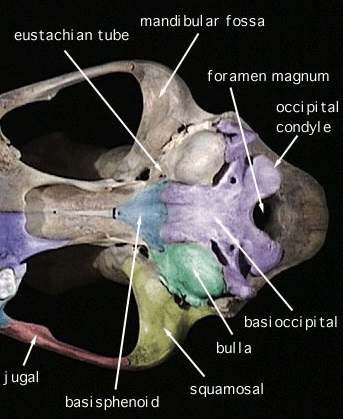 June
2013:
UK & German researchers find earlier closure of cavaliers' cranial joints
than in other breeds. In
a June 2013 study by UK and German
researchers Martin J. Schmidt, Holger Volk, Melanie Klingler, Klaus Failing,
Martin Kramer, and Nele Ondreka, they examined MRIs of 174 dogs under 18 months
of age, to compare the open or closed status of cranial joints ("synchondroses")
between mesaticephalic (e.g., Labrador retriever), brachycephalic (e.g.,
pug), and cavalier King Charles spaniel dogs. They found statistically
significant differences in the closure time of the joint between the skull's
sphenoid bone and occipital bone between all three categories of the dogs.
They have concluded that earlier closure of the spheno-occipital joint in
the CKCS could explain the breed's "caudal occipital malformation syndrome
(COMS)".
June
2013:
UK & German researchers find earlier closure of cavaliers' cranial joints
than in other breeds. In
a June 2013 study by UK and German
researchers Martin J. Schmidt, Holger Volk, Melanie Klingler, Klaus Failing,
Martin Kramer, and Nele Ondreka, they examined MRIs of 174 dogs under 18 months
of age, to compare the open or closed status of cranial joints ("synchondroses")
between mesaticephalic (e.g., Labrador retriever), brachycephalic (e.g.,
pug), and cavalier King Charles spaniel dogs. They found statistically
significant differences in the closure time of the joint between the skull's
sphenoid bone and occipital bone between all three categories of the dogs.
They have concluded that earlier closure of the spheno-occipital joint in
the CKCS could explain the breed's "caudal occipital malformation syndrome
(COMS)".
EDITOR'S NOTE: This group's use of "COMS" probably is due to Drs. Schmidt's, Kramer's, and Ondreka's belief that "Chiari-like malformation" does not appropriately describe the disorder. See their September 2012 comments.
June 2013: UK & German neurologists find connection between venous drainage and parenchyma overcrowding in CKCSs with CM/SM. In a June 2013 report, UK and German neurology researchers Joe Fenn, Martin J. Schmidt, Harriet Simpson, Colin J. Driver, and Holger A. Volk, having compared 22 cavaliers with SM and 12 without SM, found that in CKCSs with SM the percentage of space taken by venous sinuses in the brain is significantly lower than the volume occupied by the brain's parenchyma. Venous sinuses are a network of channels in the brain, which receive blood from the brains veins and also receive cerebrospinal fluid (CSF) and empty blood into the jugular vein.
The report concludes that: "These results support a role for reduced venous drainage and parenchymal ‘overcrowding’ of the CCF [caudal cranial fossa] in the pathophysiology of SM."
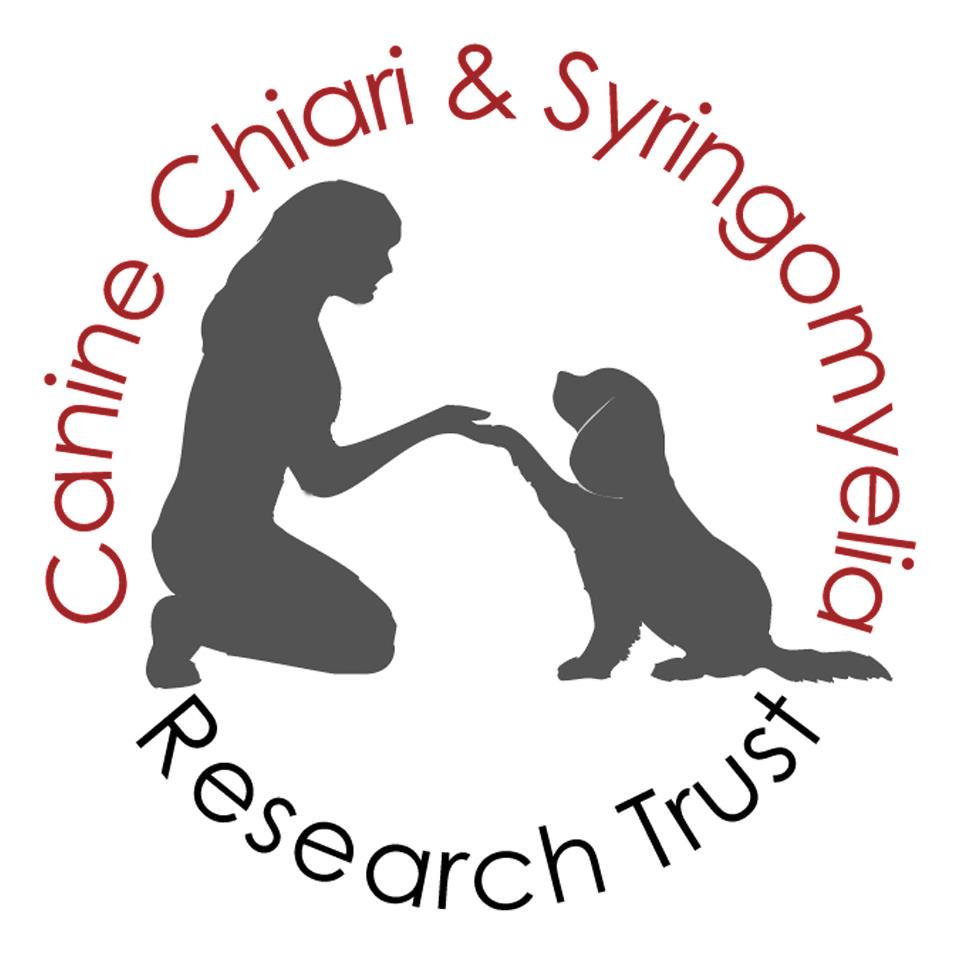 May
2013: CM/SM Trust website is up. The website of the CM/SM
Trust's canine chiari and syringomyelia research is up and running.
Click here. It
provides information about CM/SM in both humans and dogs and is worth a good
long look. There is extensive information about research projects, upcoming
events, biographies of leading researchers and supporters, where and how to
contribute, and even a gift shop.
May
2013: CM/SM Trust website is up. The website of the CM/SM
Trust's canine chiari and syringomyelia research is up and running.
Click here. It
provides information about CM/SM in both humans and dogs and is worth a good
long look. There is extensive information about research projects, upcoming
events, biographies of leading researchers and supporters, where and how to
contribute, and even a gift shop.
May
2013: UK
Kennel Club announces syringomyelia as a "candidate" for EBVs.
The UK Kennel
 Club, in its
2012 Dog Health Group Annual Report, announced that syringomyelia (along
with mitral valve disease) "are candidates for the development of EBVs
[estimated breeding values] but require appropriate data collection
procedures to be in place." The report goes on:
Club, in its
2012 Dog Health Group Annual Report, announced that syringomyelia (along
with mitral valve disease) "are candidates for the development of EBVs
[estimated breeding values] but require appropriate data collection
procedures to be in place." The report goes on:
"A BVA/KC scheme for syringomyelia was launched in 2012 and once enough data has accumulated through the scheme then EBVs for the condition will become a possibility."
For more information about EBVs, see our webpage on the topic.
April 2013:
German researchers find relationship between pain and asymmetrical syrinxes
and dorsal horn involvement in cavaliers with SM. In
a 2013
study of 26 cavaliers (11 dogs without clinical signs of pain; 6 dogs
with pain and symmetrical syrinxes; 9 dogs with pain and asymmetrical
syrinxes), German researchers found "an association" between pain and SM
asymmetry, and they found "a strong association" between pain and dorsal
horn involvement of SM. CKCSs with clinical signs of pain showed either
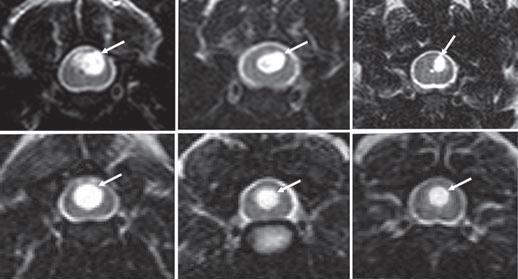 asymmetrical
syrinxes or involvement of the dorsal horn gray matter. They also found that
cavaliers with clinical signs of pain showed a presence of interleukin-6 (a
key component of the nervous system’s response to injury) and substance P (a
neurokinin that regulates the immune functions of spinal glial cells) in
their cerebrospinal fluid (CSF). The researchers conclude that the release
of interleukin-6 and substance P is a factor in the development of
persistent pain in cavaliers with SM. They suggest that this information
could offer new diagnostic and treatment options for CKCSs with SM. (In
the study's photo above, the top three syrinxes are asymmetrical; the bottom
three are symmetrical.)
asymmetrical
syrinxes or involvement of the dorsal horn gray matter. They also found that
cavaliers with clinical signs of pain showed a presence of interleukin-6 (a
key component of the nervous system’s response to injury) and substance P (a
neurokinin that regulates the immune functions of spinal glial cells) in
their cerebrospinal fluid (CSF). The researchers conclude that the release
of interleukin-6 and substance P is a factor in the development of
persistent pain in cavaliers with SM. They suggest that this information
could offer new diagnostic and treatment options for CKCSs with SM. (In
the study's photo above, the top three syrinxes are asymmetrical; the bottom
three are symmetrical.)
February 2013: UK neurologists report cavaliers' CM/SM may either result from independent development of the occipital bone and cerebellum or dysregulation of a growth mechanism signal. In a February 2013 report, UK researchers T. A. Shaw, I. M. McGonnell, C. J. Driver, C. Rusbridge, and H. A. Volk compared MRI scans of 45 CKCSs, 38 dogs of other small breeds, and 26 Labrador retrievers, and concluded:
"The data support the hypothesis that CM/SM in CKCS is a multifactorial disease process governed by the effects of increased hindbrain volume and impaired occipital bone development. The present authors recently reported that CM/SM is linked to increased cerebellar volume (Shaw and others 2012). In view of this, the aetiopathogenesis of CM/SM may equivocally be mediated by conditions independently affecting the developing occipital bones and cerebellum, or by dysregulation of a signalling mechanism coordinating the growth of the developing hindbrain and occipital skull."
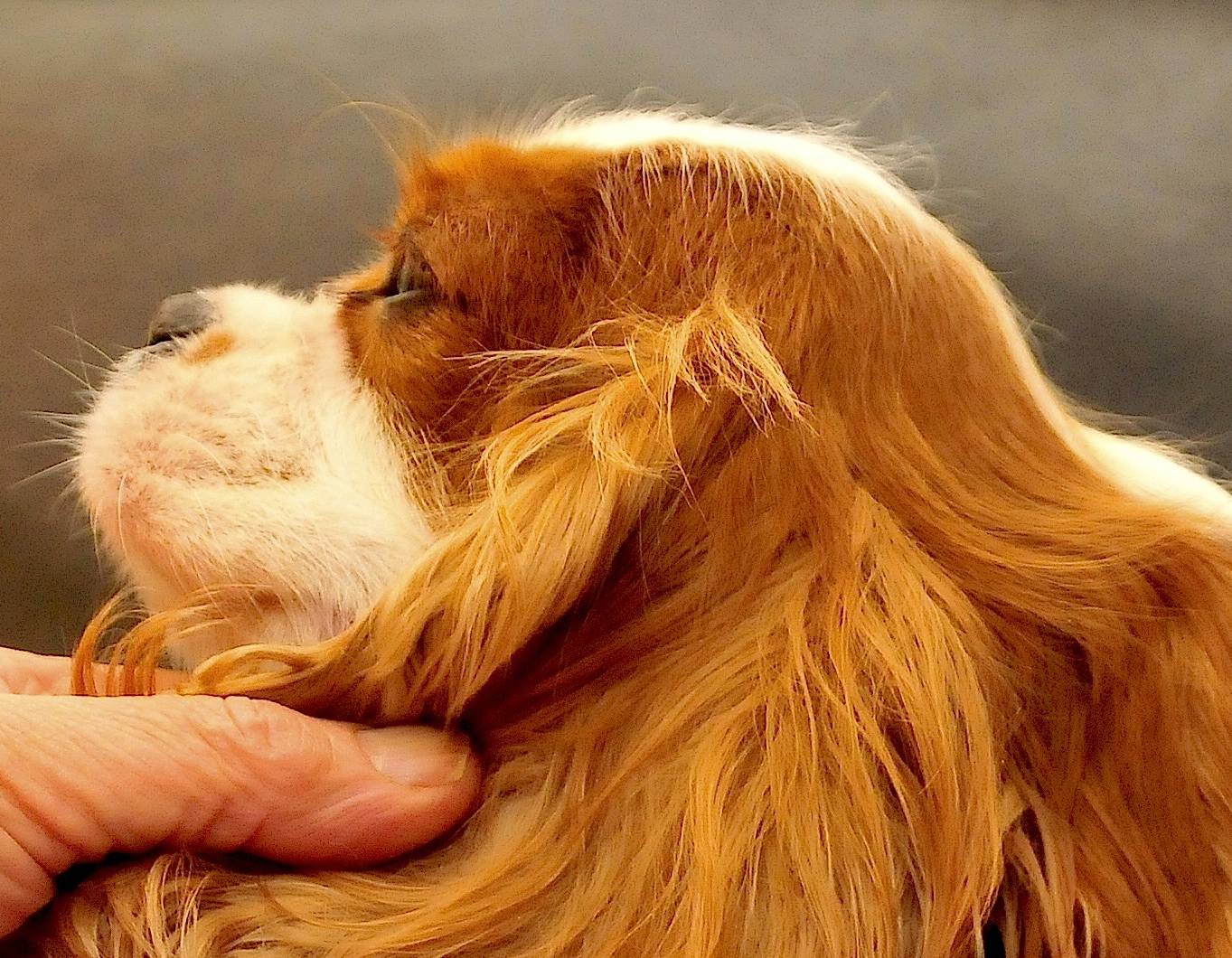 January
2013: UK's
Bristol University seeks CKCS head size data worldwide for The
Conformational Indicators Study. Thomas Mitchell,
Bristol University researcher, has announced that
The Conformational Indicators Study (of whether there is a relationship
between head size and shape and CM or SM) now can accept shape and size data
from cavaliers worldwide via a new website.
January
2013: UK's
Bristol University seeks CKCS head size data worldwide for The
Conformational Indicators Study. Thomas Mitchell,
Bristol University researcher, has announced that
The Conformational Indicators Study (of whether there is a relationship
between head size and shape and CM or SM) now can accept shape and size data
from cavaliers worldwide via a new website.
Mr. Mitchell states:
"We are now at the point where we can progress the research further and collect some data internationally for analysis and discussion. We have compiled an instruction manual of measurements that everyone can follow, and we have a fancy webpage where everyone can input the information. By doing this, we will be able to get some definitive answers for the questions that have been brought up here and validate some of our theories! I have already been hard at work taking measurements in the UK to contribute and likewise Henny in the Netherlands, and we will continue to do so; however, this part of the study will allow for people to contribute measurements of all their MRId dogs worldwide! Of course - I will be able to measure the UK dogs, so anybody who wishes to get involved in the UK can contact me directly to organise a visit by email at cmsmresearch@gmail.com The best thing about this study is that it is going to give all breeders an evidence base to work from in choosing what conformation they want to strive for - hopefully one that will enable better results upon health testing - long in advance of matings, etc."
The instructional guide for compiling the data is at www.cmsmtrust.org/resources/Catalogue-of-Measurements.pdf The data may be input on an on-line measurement collection form here: www.cmsmtrust.org/page31/page47/Mes/index.php
January 2013: US neurologists need previously MRI'd cavaliers for brain/skull size study. Dr. Sofia Cerda-Gonzalez of Cornell University in New York and Dr. Natasha J. Olby of North Carolina State University are performing a study looking into the relationship between brain structure/skull size and clinical changes (development, worsening, or absence of clinical signs) in cavalier King Charles spaniels. This study will help to better understand which, if any, MRI findings are predictive of a cavalier developing new or more pronounced clinical signs in the future. Such information is crucial to understanding the clinical significance of imaging findings and being able to make more informed treatment decisions for Cavaliers.
As such, they are inviting owners of CKCSs that have had an MRI of their brain and/or neck performed four or more years ago to participate in this effort. Through the study, they will provide a no-cost MRI of the brain and neck to a limited number of cavaliers. Owners of participating dogs will be asked to fill out a simple questionnaire, and will be provided with the results MRI imaging at the time of participation. If you are interested in participating, contact Dr. Cerda-Gonzalez at sc224@cornell.edu or at 607-253-3060.
RETURN TO TOP
2012 News
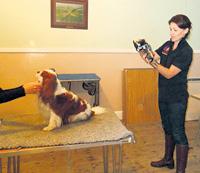 November
2012:
UK clinic studies thermal imaging to detect CM/SM.
Stephanie Godfrey of
Veterinary Thermal Imaging Limited in Churt, Surrey, UK is
studying
thermal imaging of dogs to detect Chiari-like
malformation and syringomyelia. She states:
November
2012:
UK clinic studies thermal imaging to detect CM/SM.
Stephanie Godfrey of
Veterinary Thermal Imaging Limited in Churt, Surrey, UK is
studying
thermal imaging of dogs to detect Chiari-like
malformation and syringomyelia. She states:
"A study came to my attention from an American Veterinarian, Dr. Dominic Marino. A preliminarily study was carried out to establish if a thermographic imaging protocol would be feasible for dogs suspected of having Chiari- Like Malformation (CLM). The preliminarily results have shown that dogs with abnormal MRI findings revealed a 'cooler thermographic pattern' compared to those with normal MRI results. This suggested that thermal imaging may be a useful imaging modality for the screening of CLM detection in dogs. As a veterinary thermographer, I decided that I would like to trial a study over here in the UK to see if this 'cooler reading' would show a correlation to the MRI findings."
The procedure used to explore the use of thermal imaging for the screening of CLM is non-invasive. Thermal images are taken of the dog's head and neck. The images can be taken without the need for sedation, and in the dog's home. The thermographer then examines these images, along with MRI results, to see if a correlation can be seen between skull and neck structures in the affected animals.
Veterinary Thermal Imaging Limited is located on Hale House Lane, Churt, Surrey, GU10 2JG. For more information, contact Stephanie Godfrey at Stephanie.godfrey@vtiuk.com, telephone 0844 544 3314, website www.veterinary-thermal-imaging.com
November
2012: German researchers assess effect of gabapentin on
post-operative pain after
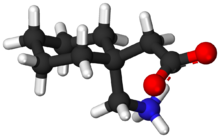 intervertebral disc surgery. In
a
November 2012 report in Veterinary Anaesthesia and Analgesia, involving 63
dogs, German neurologists compared the pain-relief value of gabapentin when
added to opioid analgesia. They concluded that gabapentin administered
orally twice a day "did not result in a detectable reduction in pain
behaviour compared to background opioid analgesia alone." However, they
recommend further studies to determine if the results were related to
effective background analgesia or an ineffective dose of gabapentin.
intervertebral disc surgery. In
a
November 2012 report in Veterinary Anaesthesia and Analgesia, involving 63
dogs, German neurologists compared the pain-relief value of gabapentin when
added to opioid analgesia. They concluded that gabapentin administered
orally twice a day "did not result in a detectable reduction in pain
behaviour compared to background opioid analgesia alone." However, they
recommend further studies to determine if the results were related to
effective background analgesia or an ineffective dose of gabapentin.
October 2012: UK researchers conclude that neuropathic pain progresses in 75% of CKCSs with CM and/or SM. In an October 2012 study by leading UK CM/SM researchers, they studied the clinical signs of neuropathic pain in 48 cavalier King Charles spaniels for a mean average of over a three year period. Nine of the 48 dogs had only CM. None had been treated surgically. They found that the clinical signs suggest that neuropathic pain progressed in 75% of the dogs with either CM/SM or just CM. They noted that it is not fully understood how CM/SM causes neuropathic pain, and that their study does not make any such finding.
October
2012:
UK's Penderis views CKCS's high prevalence of CM and limited genetic
diversity as "major difficulties".
 In
an editorial in the Veterinary Journal, UK researcher Dr. Jacques Penderis
(right) comments upon recently reported research into Chiari-like
malformation and syringomyelia in the cavalier King Charles spaniel. He
concludes:
In
an editorial in the Veterinary Journal, UK researcher Dr. Jacques Penderis
(right) comments upon recently reported research into Chiari-like
malformation and syringomyelia in the cavalier King Charles spaniel. He
concludes:
"The high prevalence of Chiari-like malformation in the breed and the confirmation that brain morphology is directly influenced by head phenotype (Hussein et al., 2012), suggests that Chiari-like malformation in the CKCS is likely to be the inadvertent consequence of misguided breeder selection to emphasise certain cranial features deemed to be desirable. The high breed prevalence of Chiari-like malformation (estimated at 95%) points to limited genetic diversity within the CKCS, resulting in major difficulties if breeding away from conformations associated with Chiari-like malformation is attempted in the future."
 October
2012:
UK's Bristol Univ. plans study of cavaliers' head shapes for CM/SM
characteristics. Thomas Mitchell, a researcher
at the University of Bristol, in Bristol, UK, seeks to answer the common
question, "Can you tell if a dog has CM or SM by looking at it?"
He heads "The Conformational Indicators Study" and is
investigating the extent to which conformational characteristics -- the
external appearance of dogs, such as head shape -- indicate the presence of
Chiari-like malformation (CM) and/or syringomyelia (SM). The study seeks to
determine if aspects of the conformation are risk factors for CM/SM. This
may identify an additional method of indicating disease by measuring the
head and body of the dogs, and thereby enable cavalier breeders (and Griffon
Bruxellois breeders) to identify which prospective breeding stock to scan
and perhaps allow breeders to decide on future matings based upon the
overall conformation of the dog and not only on the results of MRI scans.
October
2012:
UK's Bristol Univ. plans study of cavaliers' head shapes for CM/SM
characteristics. Thomas Mitchell, a researcher
at the University of Bristol, in Bristol, UK, seeks to answer the common
question, "Can you tell if a dog has CM or SM by looking at it?"
He heads "The Conformational Indicators Study" and is
investigating the extent to which conformational characteristics -- the
external appearance of dogs, such as head shape -- indicate the presence of
Chiari-like malformation (CM) and/or syringomyelia (SM). The study seeks to
determine if aspects of the conformation are risk factors for CM/SM. This
may identify an additional method of indicating disease by measuring the
head and body of the dogs, and thereby enable cavalier breeders (and Griffon
Bruxellois breeders) to identify which prospective breeding stock to scan
and perhaps allow breeders to decide on future matings based upon the
overall conformation of the dog and not only on the results of MRI scans.
Breeders of cavaliers with current MRI certificates are being sought to aid this study. All information obtained in the study will be kept confidential, and privacy will be maintained throughout the study. First, the participating breeders are asked to submit their dogs' MRI certificates to a confidential email address, fax number, or postal box. A trained researcher would visit the breeders' premises (or dog show or other breed event) and take a series of non-invasive measurements. A unique ID number will be assigned to each dog, so that the researcher will not know in advance the MRI status of the dog. The ID number also will provide owner confidentiality.
If you are a cavalier breeder and are willing to participate or have questions, contact Thomas Mitchell at CMSMresearch@gmail.com or join the group's Facebook page. See also Dr. Clare Rusbridge's blog article for more information.
September 2012: UK researchers find that CKCSs with SM have narrower jugular foramen than unaffected CKCSs. In a September 2012 report, a team of UK researchers compared 20 cavaliers with SM and 20 without SM and found that the jugular foramen (a space between the temporal bone and the occipital bone, containing the jugular vein), was narrower in the SM-affected cavaliers. They concluded that the narrower gap of the jugular foramen in SM-affected CKCSs may affect the pressure waves of cerebrospinal fluid (CSF) and serve as an additional factor (other than cerebellar herniation) causing SM.
July 2012: Australian vet surgeons find cavalier with life-threatening dysphagia caused by Chiari-like malformation. A team of Australian veterinary surgeons report of foramen magnum decompression surgery resolving a cavalier King Charles spaniel suffering from life-threatening dysphagia (difficulty in swallowing food caused by disease or impairment of the nervous system). They conclude that CM can be a cause of dysphagia in dogs.
July 2012: UK researchers find no connection between Chiari-like malformation and epilepsy in cavaliers. In a 2012 report in the Veterinary Journal, UK neurology researchers C.J. Driver, K. Chandler, G. Walmsley, N. Shihab, and H.A. Volk examined the MRIs of 85 cavalier King Charles spaniels, looking for a relationship between Chiari-like malformation (CM), ventriculomegaly, and seizures in the dogs. The 85 CKCSs all had CM; 27 of them also had had seizures. They found no association between CM, ventriculomegaly, and the seizures. The seizures were classified as having partial onset -- meaning that they occur in in one area of the brain, unlike generalized seizures which typically affect nerve cells throughout the brain -- in 61% of the dogs. They also stated that "Another cause of recurrent seizures in CKCS (such as familial epilepsy) is suspected, as previously reported."
July 2012: International neuropathic pain study is completed; results are awaited. A multi-school clinical study evaluating the efficacy of a novel treatment for the control of pain associated with syringomyelia in cavalier King Charles spaniels has been completed, We first reported this study in November 2007. The study was part of a collaborative effort between a pharmaceutical company, and the vet schools at the UK's Royal Veterinary College, the University of Pennsylvania, and the University of Minnesota. The study recruited patients from November 2007 to October 2008 and after screening 119 dogs, a total of fifty two patients participated in the trial. Following statistical analysis, the report is that the results are promising, and that there is potential for further development of this new medication to help alleviate the pain associated with syringomyelia.
 July
2012: UK Kennel Club adds a CM/SM recommendation for
cavaliers to its Assured Breeder Scheme. Effective July 1,
2012, the UK Kennel Club's
Assured Breeder Scheme recommends that all CKCSs being bred
first comply with the
BVA/KC
Chiari Malformation/Syringomyelia Scheme breeding guidelines.
This is not a mandatory requirement for participants of the
Assured Breeder Scheme.
July
2012: UK Kennel Club adds a CM/SM recommendation for
cavaliers to its Assured Breeder Scheme. Effective July 1,
2012, the UK Kennel Club's
Assured Breeder Scheme recommends that all CKCSs being bred
first comply with the
BVA/KC
Chiari Malformation/Syringomyelia Scheme breeding guidelines.
This is not a mandatory requirement for participants of the
Assured Breeder Scheme.
June
2012:
UK researchers report results of questionnaires on neuropathic pain in
CM/SM-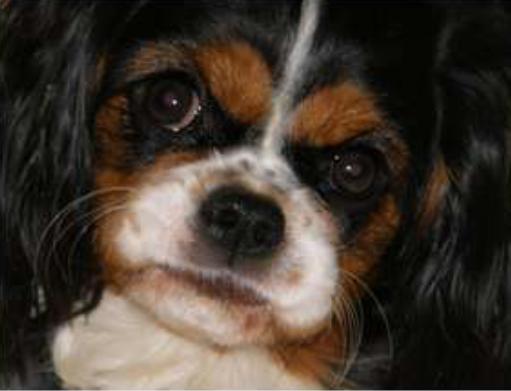 affected cavaliers. In a
2012 study, UK
researchers (Lynda Rutherford, Annette Wessmann, Clare Rusbridge,
Imelda M. McGonnell, Siobhan Abeyesinghe, Charlotte Burn, and
Holger A. Volk). of cavaliers with neuropathic pain report on the
results of extensive questionnaires completed by the owners of 122
CM/SM-affected CKCSs. They found that owners who noticed evidence of
neuropathic pain in their dogs also found the dogs to have increased
fear-related behaviors (such as acting more fearfully when approached by
strangers, or when in unfamiliar situations, or when sudden loud noises
occurred, such as thunderstorms). These dogs also were more clingy to their
owners and appeared to be more fearful when left alone. They also showed
decreased willingness to exercise, and problems in settling, including sleep
disturbances. Not surprisingly, the study also showed that owners found that
their affected dogs had reduced quality of life.
affected cavaliers. In a
2012 study, UK
researchers (Lynda Rutherford, Annette Wessmann, Clare Rusbridge,
Imelda M. McGonnell, Siobhan Abeyesinghe, Charlotte Burn, and
Holger A. Volk). of cavaliers with neuropathic pain report on the
results of extensive questionnaires completed by the owners of 122
CM/SM-affected CKCSs. They found that owners who noticed evidence of
neuropathic pain in their dogs also found the dogs to have increased
fear-related behaviors (such as acting more fearfully when approached by
strangers, or when in unfamiliar situations, or when sudden loud noises
occurred, such as thunderstorms). These dogs also were more clingy to their
owners and appeared to be more fearful when left alone. They also showed
decreased willingness to exercise, and problems in settling, including sleep
disturbances. Not surprisingly, the study also showed that owners found that
their affected dogs had reduced quality of life.
June
2012: German researchers dispute
that cavaliers have Chiari-like malformation. In a
June 2012 report in
Veterinary Radiology & Ultrasound, German neurologists and radiologists
Martin J. Schmidt, Martin Kramer, and Nele Ondreka
compared the volumes of occipital bones of cavaliers with and without
syringomyelia and of French bulldogs. They did not find a reduced volume of
the occipital bone of CKCSs,
 compared to the bulldogs. They concluded:
compared to the bulldogs. They concluded:
"These results do not support occipital hypoplasia as a cause for syringomyelia development, challenging the paraxial mesoderm insufficiency theory. This also suggests that the term Chiari-like malformation, a term derived from human studies, is not appropriate in the Cavalier King Charles spaniel."
EDITOR'S NOTE: The authors of this article seemed mired in the pre-2010 definition of Chiari-like malformation. They state:
"... [T]he Chiari-like malformation in the Cavalier King Charles spaniel is characterized by indentation of the occipital (bone) with cerebellar herniation and is more correctly termed caudal occipital malformation syndrome."
They also appear to be unduly dismissive of the studies beginning in 2009 which found that the cavalier's cerebellum is relatively larger than that in other breeds. The authors of this June 2012 article did not include cerebellum size in their study, and their comment about the 2009-2012 reports simply is:
"Results of studies proposing a mismatch between cerebellar and caudal cranial fossa volume in this breed and in comparison to other breeds were controversial. In some studies, there was a mismatch between caudal fossa parenchyma and caudal fossa volume in dogs with syringomyelia and overcrowding was proposed as a cause of syringomyelia development. In most studies, however, no difference was found between caudal fossa volume in Cavalier King Charles spaniels with and without syringomyelia, although this was not universal." (Emphasis added.)
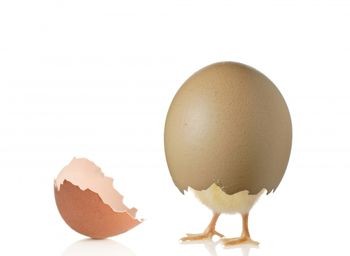 April
2012: RVC to compare
chicken and mouse cerebellar development with that of CKCSs.
Royal Veterinary College researchers Dr. Imelda McGonnell
and Dr. Holger Volk plan to investigate
April
2012: RVC to compare
chicken and mouse cerebellar development with that of CKCSs.
Royal Veterinary College researchers Dr. Imelda McGonnell
and Dr. Holger Volk plan to investigate
 cerebellar
development in various chicken, dogs and mouse models, in hopes that this
research will lead to a better understanding of the Chiari-like malformation
disease process and provide therapeutic targets. This project is being
jointly undertaken in the laboratories of Drs. McGonnell and Volk at the RVC
and Dr. Albert Basson at the Dept Craniofacial Development, Kings College
London, and is being funded by the Wellcome Trust. Read more
here.
cerebellar
development in various chicken, dogs and mouse models, in hopes that this
research will lead to a better understanding of the Chiari-like malformation
disease process and provide therapeutic targets. This project is being
jointly undertaken in the laboratories of Drs. McGonnell and Volk at the RVC
and Dr. Albert Basson at the Dept Craniofacial Development, Kings College
London, and is being funded by the Wellcome Trust. Read more
here.
April 2012: UK researchers find an association between syringomyelia and the cavalier's oversized cerebellum. In an April 2012 report, UK researchers Thomas A. Shaw, Imelda M. McGonnell, Colin J. Driver, Clare Rusbridge, and Holger A. Volk, confirmed previous studies that cavalier King Charles spaniels have proportionately larger cerebellums than other small breeds and Labradors. They also found an association between the CKCS's oversized brains and SM. 75 cavalier MRI scans were reviewed. They concluded:
"These findings support the hypothesis that it is a multifactorial disease process governed by increased cerebellar volume and failure of the CCF to reach a commensurate size."
 April 2012:
RVC needs cavaliers to compare neuropathic pain medications for SM.
The Royal Veterinary College is seeking UK and US cavaliers diagnosed with
symptomatic CM and/or SM to participate in a study comparing two neuropathic
pain medications. Eligible dogs must show clinical signs of neck/ back pain,
air scratching, facial rubbing, screaming/ yelping episodes or wobbliness.
Dogs with kidney or gastro-intestinal disease cannot be included.
April 2012:
RVC needs cavaliers to compare neuropathic pain medications for SM.
The Royal Veterinary College is seeking UK and US cavaliers diagnosed with
symptomatic CM and/or SM to participate in a study comparing two neuropathic
pain medications. Eligible dogs must show clinical signs of neck/ back pain,
air scratching, facial rubbing, screaming/ yelping episodes or wobbliness.
Dogs with kidney or gastro-intestinal disease cannot be included.
The RVC and the Queen Mother Hospital Royal Veterinary College and Queens Veterinary School Hospital and Stone Lion Veterinary Group, all in the UK, as well as the College of Veterinary Medicine, Iowa State University, in Ames, Iowa USA, are participating. For more information, email tckcstrial@gmail.com or click here.
April 2012: Geoff Skerritt and Dr. Luca Motta find shunt surgery successful for relieving SM pain. UK neurosurgeons Geoffrey Skerritt and Dr. Luca Motta report in an April 2012 study that:
"[Syringosubarachnoid shunt] S-S shunting is a safe and relatively effective surgical technique that may improve the neurological signs and the quality of life of dogs affected by CM and associated SHM/SM. Postoperative complications or lack of clinical improvement may occur in a small number of cases and a secondary surgery may be needed. This study also suggests that the S-S shunt may lead to a satisfactory outcome in dogs where the FMD [foramen magnum decompression] technique has failed. Comparisons between different surgical techniques are needed to create objective criteria that may suggest which procedure will produce the best surgical results."
The researchers performed surgeries on nine cavaliers and two Yorkshire terriers. Ten of the dogs survived the study. They also devised a Pain Score Scheme (see table above under Symptoms) to evaluate the levels of pain the dogs experienced both before and following the surgeries.
 March
2012: UK's BVA and KC issue CM/SM breeding guidelines. The British Veterinary Association (BVA) and the UK's Kennel
Club (KC) issued in March 2012 a set of
Chiari-like malformation
and syringomyelia (CM/SM) breeding guidelines,
with the aim of removing from breeding programs, cavalier King Charles spaniels
with early-onset SM, and thereby reducing or even eliminating the incidence of
CM/SM in future generations of cavaliers. This SM
breeding protocol is limited to cavaliers (and other breeds) registered with the
UK's Kennel Club. The two USA national cavalier clubs have refused to
acknowledge the existence of any SM breeding guidelines, and the US clubs place
no restrictions on breeding cavaliers with CM/SM.
March
2012: UK's BVA and KC issue CM/SM breeding guidelines. The British Veterinary Association (BVA) and the UK's Kennel
Club (KC) issued in March 2012 a set of
Chiari-like malformation
and syringomyelia (CM/SM) breeding guidelines,
with the aim of removing from breeding programs, cavalier King Charles spaniels
with early-onset SM, and thereby reducing or even eliminating the incidence of
CM/SM in future generations of cavaliers. This SM
breeding protocol is limited to cavaliers (and other breeds) registered with the
UK's Kennel Club. The two USA national cavalier clubs have refused to
acknowledge the existence of any SM breeding guidelines, and the US clubs place
no restrictions on breeding cavaliers with CM/SM.
RETURN TO TOP
2011 News
December 2011: The Cavalier Foetal Tissue Research Project's website is online. Sheena Stevens has created a website about the Cavalier Foetal Tissue Research Project: http://www.ftrproject.com Check it out to learn more about this research program and how to contribute funds to it. Also, read more about the project here.
December 2011: UK researchers confirm that cavaliers with only CM suffer pain and that CM/SM is progressive. In a December 2011 study at the Royal Veterinary College, researchers studied 49 clinically affected CKSCs. They found: (a) 25% did not have SM; (b) the severity of SM was positively correlated with patient age; and (c) there is a very high potential for CKCS with clinical signs of CM/SM to develop SM in more than one spinal cord region.
October 2011: Univ. of Penna. cardiologists study torsemide as alternative to furosemide. University of Pennsylvania veterinary cardiologists report that they have tested the loop diuretic torsemide as alternative to furosemide in dogs with advanced heart failure, including a 12 year old cavalier. They have found torsemide "has several characteristics that make it suitable for treatment of advanced heart failure including longer half-life, increased potency of diuretic action, and anti-aldosterone effects."
October 2011:
SM Breeding Protocol
Statistics.
 In an October 2011 report
of the statistical results of following the SM
protocol, the researchers, Dr. Clare Rusbridge (right), Penny Knowler,
and A. K. McFadyen stated that:
In an October 2011 report
of the statistical results of following the SM
protocol, the researchers, Dr. Clare Rusbridge (right), Penny Knowler,
and A. K. McFadyen stated that:
"This study investigated the early outcome of existing SM breeding guidelines. Six hundred and forty-three dogs, 550 Cavalier King Charles spaniels (CKCS) and 93 Griffon Bruxellois (GB), were identified as having either one (454 dogs) or both parents (189 dogs) with MRI-determined SM status.
• Offspring without SM were more common when the parents were both clear of SM (SM-free; CKCS 70 per cent, GB 73 per cent).
• Conversely, offspring with SM were more likely when both parents had SM (SM-affected; CKCS 92 per cent, GB 100 per cent).
• A mating of one SM-free parent with an SM-affected parent was risky for SM affectedness with 77 per cent of CKCS and 46 per cent of GB offspring being SM-affected.
It is recommended that all breeding dogs from breeds susceptible to SM be MRI screened; that the SM status at five years old is established; and all results submitted to a central database that can be used by dog breeders to better enable mate selection based on estimated breeding values."
September 2011: UK researchers examine distribution of pain-related neuropeptides in cavaliers with SM. They observe that CKCSs with clinical signs of SM also show disruption in the structure of their spinal cord's dorsal horn. See report summary. The researchers conclude:
"This current study provides evidence to suggest that the disruption of the dorsal horn structure is a significant event in the production of clinical signs in CKCS. The spinal cord dorsal horn in symptomatic CKCS is significantly more asymmetric than that of control animals, whereas the asymptomatic CKCS have changes that are midway between control and symptomatic CKCS. This suggests the possibility that progression from mild to severe asymmetry in CKCS is associated with development of clinical signs; however such a conclusion cannot be definitively supported by this study because of the cross sectional nature of the data collected."
September 2011: Researchers find that SM is associated with degenerative changes in the spinal cord. In a study published in the Journal of Comparative Pathology, researchers H.Z. Hu, Clare Rusbridge, F. Constantino-Casas, and Nick Jeffery report that:
"SM is associated with degenerative changes in the spinal cord and may develop through primary disruption of ependymal integrity followed by vascular hypertrophy and proliferation. Glial and fibrous proliferation appears to be associated with expression of clinical signs."
 The ependyma is the epithelial membrane which lines the spinal cord.
Vascular hypertrophy means the increase in the volume of blood vessels.
Glial are cells that provide protection for the brain's neurons
(right), among other
things.
The ependyma is the epithelial membrane which lines the spinal cord.
Vascular hypertrophy means the increase in the volume of blood vessels.
Glial are cells that provide protection for the brain's neurons
(right), among other
things.
Commenting on the findings by one of the article's authors, Dr. Clare Rusbridge, she writes on her blog:
"The pathology suggested that the primary development of syringomyelia is associated with central canal dilatation and damage which is accompanied by blood vessel changes. This is an important finding because there is so much debate on how syringomyelia develops in all species."
August 2011: Head position affects extent of cerebellar herniation in MRI scans. UK researchers examining 14 CKCS MRI scans (7 with CM/SM and 7 with just CM) comparing scans in both extended and flexed head positions. In their report, they have found the degree of cerebellar herniation was significantly worse in dogs with a flexed compared to an extended head position. When cerebrospinal fluid (CSF) space between the cerebellum and brainstem was compared in CKCS with and without SM, there was a significant increase in CSF space in CKCS with CM alone compared to those with CM/SM when head position was flexed. Based upon their findings, they state that it may be appropriate to position patients in a more flexed head position for optimal imaging in order to identify morphologic changes more accurately. They stated that this is important to consider for imaging CKCS with CM especially when studying the pathogenesis of CM/SM.
The researchers also found:
"When CSF space between the cerebellum and brainstem was compared in CKCS with and without SM, there was a significant increase in CSF space in CKCS with CM alone compared to those with CM/SM when head position was flexed. In their cine MR imaging study of CSF flow dynamics in CKCS with CM or CM/SM, Cerda-Gonzalez and others (2009a) found that turbulent CSF flow and jets are associated with SM presence and severity and CSF flow velocity at C2/3 is inversely related to the presence of SM. The reduced CSF space in CM/SM dogs reported in this study could explain this jet like CSF flow in dogs with CM/SM compared to those with CM alone."
This could mean that the severity of CM/SM, or even the presence or future presence of SM, could be predicted based upon the measure of cerebrospinal fluid space between the cerebellum and the brainstem. If so, this could go a long way to distinguishing whether a CM-only cavalier is either likely or unlikely to develop SM in the future. This distinction could be a way to fine-tune a breeding protocol, considering that we now know that over half of cavaliers with SM develop it after their 3rd birthday. If we could reliably count on this measurement of CSF space to tell us if a young dog will, or will not, develop SM in the future, then we could more reliably select SM-free breeding stock at a younger age than the present 2.5 years and the 3+ years the researchers may recommend in the future.
June 2011: Montreal team of researchers identify chromosome 2 region associated with Chiari-like malformation in the Brussels Griffon breed. See summary here. Researchers include Lemay P, Trinh QH, Dubé MP, Rusbridge C, Rouleau GA, and Kibar Z.
June 2011: UK researchers find that CM is progressive
in CKCSs; that foramen magnum size and cerebellar herniation increase
significantly.
 UK researchers, including Drs. Rusbridge
(right),
Driver, and McGonnell, reported to the ACVIM in
a
June 2011 study that twelve CM-affected cavaliers'
foramen magnums and the length of cerebellar herniation "increased
significantly" between MRI scans which averaged 9.5 months apart. they concluded:
UK researchers, including Drs. Rusbridge
(right),
Driver, and McGonnell, reported to the ACVIM in
a
June 2011 study that twelve CM-affected cavaliers'
foramen magnums and the length of cerebellar herniation "increased
significantly" between MRI scans which averaged 9.5 months apart. they concluded:
"This work could suggest that overcrowding of the caudal cranial fossa in conjunction with the movements of cerebrospinal fluid and cerebellar tissue secondary to pulse pressures created during the cardiac cycle causes pressures on the occipital bone. This leads to a resorption of the bone and therefore an increase in caudal cranial fossa and foramen magnum size allowing cerebellar herniation length to increase."
June 2011: UK researchers report CKCS has relatively larger cerebellum than both small breeds and Labradors. In a June 2011 report to the ACVIM, UK researchers, including Drs. McGonnell, Driver, and Rusbridge, compared cerebellar size of cavaliers with other small breed dogs and with Labrador retrievers. They conclude: "Our findings show that the CKCS has a relatively larger cerebellum than small breed dogs and Labradors and there is an association between increased cerebellar volume and SM in CKCS."
 June 2011:
Long Island Veterinary Specialists report 97.3%
accuracy in thermography diagnosing Chiari-like malformation in CKCSs.
Drs. Catherine Loughin and Dominic Marino released a
June 2011 study of 105 cavaliers,
comparing the results of medical infrared imaging (MII), also called
thermography, with MRIs to detect the presence of CM. The results: "The top
of head and front of head ROI [regions of interest] were 89.2% and 97.3%
successful in identifying dogs with CLM. Based on these preliminary
findings, MII may be a viable screening tool to detect CLM in dogs."
Thermography does not require sedation.
June 2011:
Long Island Veterinary Specialists report 97.3%
accuracy in thermography diagnosing Chiari-like malformation in CKCSs.
Drs. Catherine Loughin and Dominic Marino released a
June 2011 study of 105 cavaliers,
comparing the results of medical infrared imaging (MII), also called
thermography, with MRIs to detect the presence of CM. The results: "The top
of head and front of head ROI [regions of interest] were 89.2% and 97.3%
successful in identifying dogs with CLM. Based on these preliminary
findings, MII may be a viable screening tool to detect CLM in dogs."
Thermography does not require sedation.
June 2011: Omeprazole profoundly increases dogs' serum gastrin concentration in two weeks. US researchers studying the effect of two weeks of omeprazole doses on healthy dogs reported "a profound and sustained increase in serum gastrin concentration in dogs. This effect is rapidly reversible after cessation of the treatment. No effect on calcium metabolism was observed."
June 2011: Alastair Cockburn to study pain due to SM. The Universities Federation for Animal Welfare (UFAW) has awarded a Research Training Scholarship to Alastair Cockburn of the University of Bristol. He will investigate methods for assessing pain, underlying emotional state and quality of life in dogs with chronic pain conditions of syringomyelia and osteoarthritis. The aim of the research project is to deliver a useful clinical tool to measure chronic pain in dogs, a problem area due to the often very subtle changes in behavioral indicators of pain and the difficulty of assessing underlying emotional state and cumulative experience of pain – factors of critical importance in assessing quality of life.
June 2011: UK study of 555 cavaliers shows percentage with SM up to 70% in older dogs with no symptoms. A UK study of 555 (reportedly) asymptomatic CKCSs found 25% of 12 month olds with syringomyelia, increasing to 70% in cavaliers 6 years and older. The researchers concluded:
"The evidence for a lower prevalence in younger animals is more reliable (because of the higher numbers included in the present study and the lower likelihood of false inclusion) and this effect lasts until dogs are at least three years of age. This finding has important implications for the design of a screening test procedure and may conflict with the current recommendations that the optimum age for screening should be 30 months. These data would imply that it is probable that dogs aged up to three years may yet have reduced odds for the diagnosis of syringomyelia. However, there is a need for the dogs to be creened when they are reasonably young so that breeders can decide at an early stage whether their animals are suitable for breeding; many breeders would consider 36 months unduly old. ... The high lifetime prevalence of syringomyelia raises concerns for the welfare of the CKCS breed and also suggests that eliminating the genetic risk factors for the disease by selective breeding may be difficult, because the heritability has previously been shown to be complex, and the prevalence of the determinant genes within the population is therefore likely to be high. The true prevalence of syringomyelia in the general CKCS population is expected to be higher than that found in this sample population because symptomatic dogs were specifically excluded."
May 2011: Somatosensory-evoked potentials' (SEP) amplitude is more sensitive measure of spinal cord function in CKCSs with SM. UK researchers report that SEP amplitude at the C1 vertebra was a more sensitive measure of spinal cord function in CKCSs with syringomyelia, compared with results of EMG or TMMEP assessment. Measurement of SEP amplitude may have use as an objective assessment of the evolution and treatment of this disease. Read the details here.
March 2011: UK researchers find that the development of syringomyelia is accompanied by alterations in cerebrospinal fluid composition. Read their summary here.
 February 2011:
Rupert’s Fund Report for 2010. Rupert's Fund
reports that in 2010, its fund raising paid for 29 dogs (all over 6 years
except for one over 5 year years old male). The average age was 7.7 years
and the oldest dog scanned was 12 years. Results: 18 CKCS were graded A (11
females and 7 males); 11 CKCS were graded D (6 female and 5 males). All had
CM, two with only mild CM. Dr. Clare Rusbridge and
Penny Knowler report:
February 2011:
Rupert’s Fund Report for 2010. Rupert's Fund
reports that in 2010, its fund raising paid for 29 dogs (all over 6 years
except for one over 5 year years old male). The average age was 7.7 years
and the oldest dog scanned was 12 years. Results: 18 CKCS were graded A (11
females and 7 males); 11 CKCS were graded D (6 female and 5 males). All had
CM, two with only mild CM. Dr. Clare Rusbridge and
Penny Knowler report:
"Older dogs scanned have highlighted that SM can be late onset and/or progressive. Several dogs were selected because they already had previously scanned clear but had subsequently developed SM even after the age of 4 years. Such valuable additional information allows the researchers to investigate factors which might influence why some syrinxes progress rapidly and others don’t. Analysis of litters produced using the interim breeding guidelines revealed that higher numbers of dogs which were SM-clear over five years were produced if a parent was also clear of SM over 5 years.
"Donations from RF continue to fund MRIs. Priority is given to male dogs over 6 years, particularly if they have already had a SM-clear scan, but we are also interested in stud dogs of 5 years of age and bitches that have had a scan over 4 years of age or unknown MRI status over 8 years of age and asymptomatic. However, all requests made for Rupert's Fund are considered on an individual basis, and no one should be deterred in applying if they can justify how it helps the breed."
January 2011: Chiari-like malformation has been re-defined. On the website of syringomyelia researcher Dr. Clare Rusbridge, CM now is defined as "a condition characterized by a mismatch in size between the brain (too big) and the skull (too small). There is not enough room for the brain and the back part (cerebellum and medulla) is pushed out the foramen magnum." The foramen magnum is a hole in the back of the skull -- in the occipital bone -- leading to the spinal cord. Dr. Rusbridge goes on to explain that the cavalier appears to have a brain more appropriate for a bigger dog. Go here for more discussion.
January 2011: UK researchers find distribution of SM along entire spinal cord of cavaliers; syrinx size positively correlated with age. In MRI studies of 49 cavaliers, reported in 2011 in the Veterinary Journal, Dr. Clare Rusbridge and others found that "Syrinx formation was present in the C1–C4 region and in other parts of the spinal cord. The maximal dorsoventral syrinx size can occur in any region of the spinal cord." Seventy-six per cent of CKCS with a cranial cervical syrinx also had a syrinx in more caudal spinal cord regions.
They concluded that, "MRI restricted to the cervical region may underestimate the extent of SM and the severity of the disease process in the majority of dogs." Therefore, so-called "mini-MRI-scans" of only the cervical region, such as those scans for breeding protocol purposes, may not necessarily locate all syrinx which an SM-affected cavalier may have. They also found that total syrinx size positively correlated with the age of the dog.
RETURN TO TOP
2010 News
October 2010: Long Island Veterinary Specialists has started "The Canine Chiari Institute", with the mission "To improve the lives of dogs afflicted with Chiari-like Malformation and related disorders through research and continuing education." Its website is under construction, but parts of it are operative.
October 2010:
Current results of following the SM
Breeding Protocol.
 In an
interim report of the statistical results of
393 cavalier offspring of MRI-scanned breeding stock,
Dr. Clare Rusbridge (right) stated that:
In an
interim report of the statistical results of
393 cavalier offspring of MRI-scanned breeding stock,
Dr. Clare Rusbridge (right) stated that:
• Matings of Code A CKCS to Code A CKCS have
produced 75.9% offspring with no SM.
• Matings of Code A CKCS to either Code
D, E, or F CKCS have produced 41.9% offspring with no SM.
• Matings of Code A CKCS to unscanned CKCS
have produced 50.0% offspring with no SM.
• Matings of Code D CKCS to Code D, E, or F CKCS have produced no
offspring free of SM
June 2010: Canadian researchers find TMMEP, SSEP, SEP and BAER testing for SM do not work. In a 2010 report, a group of Canadian neurologists tested fifty cavaliers to evaluate the validity of BAER as well as transcranial magnetic motor evoked potentials (TMMEP), somatosensory evoked potentials (SSEP), and spinal evoked potentials (SEP), compared to MRIs. The researchers found: "TMMEP, SSEP, SEP and BAER do not appear to be valuable tests in detecting functional abnormalities of the motor and sensory pathways throughout the central nervous system of CKCS dogs with and without neurological signs secondary to SM diagnosed by MRI."
They also found a significant linear correlation between the severity of neurologic dysfunction and size of the syrinx, with a larger syrinx being associated with more severe neurologic signs.
June 2010: UK researchers report severe SM relates to greater hindbrain - caudal fossa volume mis-matches. In an abstract (A Comparison of Ventricular and Caudal Fossa Volumes in Cavalier King Charles Spaniels > 5 years of age that have not developed Syringomyelia vs those Affected when < 2 years) presented to the BSAVA by Colin Driver, Dr. Rusbridge, et al., they found that severe SM in cavaliers under 2 years old is associated with greater mis-match between hindbrain and caudal fossa volume than found in older CKCSs with CM but no SM. MRIs of 21 cavalier King Charles spaniels under 2 years affected with CM/SM, and 14 CKCSs over 5 years with only CM were analyzed.
June 2010: A UK study of 59 cavalier King Charles spaniels (71% having syringomyelia) confirms earlier findings that the variations in the dimensions of the cavaliers' posterior cranial fossa* is not associated with syringomyelia. Instead, this study, led by Colin Driver, BSc, BVetMed (Hons), MRCVS, points to two other possible connections. First, they found that a cavalier with a higher volume of parenchyma (brain matter) within the cranial fossa is more likely to have SM, and the greater the volume of parenchyma, the larger the syrinx. They state:
"There was a significant difference in [percentage of parenchyma within the caudal cranial fossa] CCFP between those without or with SM. ... More marked brain and skull volume mismatches result in SM because a higher parenchyma percentage (CCFP) is associated with the presence of a cervical syrinx. This could explain the high incidence of SM secondary to CM in CKCS reported by Rusbridge and Knowler (2003). Although statistically significant, the difference in means for CCFP between the two groups appears small. It is therefore hypothesised that only a small difference in parenchymal volume is necessary to influence the development of a cervical syrinx. Furthermore, as the total volume of parenchyma and ventricular CSF within the CCF correlates with cervical syrinx dimensions, it can be hypothesised that more marked overcrowding of the caudal fossa results in greater compression of the subarachnoid space and subsequent syrinx dilatation."
Second, they also found a direct relationship between between the dimensions of the ventricles** and the size of the syrinx. They state:
"Furthermore, there is an association between ventricle and syrinx dimensions which supports the theory that SM development is the result of altered CSF dynamics."
* The posterior (or caudal -- for "rear") cranial fossa is part of the cavity within the skull. It contains the brainstem and cerebellum, and towards its rear, it is enclosed by the occipital bone, which also frames the opening called the foramen magnum.
** Brain ventricle: One of a system of four communicating cavities within the brain that are continuous with the central canal of the spinal cord. The four ventricles consist of the two lateral ventricles, the third ventricle and the fourth ventricle.
The researchers also discuss some What-Could-Be theories (a few admittedly are laden with technical verbiage: (1) "CM might be the result of paraxial mesoderm insufficiency during embryogenesis"; (2) "There is failure of communication between the paraxial mesoderm and the cranial somites with the closing neural tube, resulting in loss of coordination between skull and brain growth (paraxial mesoderm forms the supraoccipital bone, somitic mesoderm forms the exoccipital and basioccipital bones)"; (3) "Overgrowth of the cerebellum causes the mis-match because CKCS have proportionately more hindbrain parenchyma than other small breed dogs"; and (4) "Early growth plate closure may result in CM because despite the dynamic nature of osseous tissue, it would be unable to accommodate the developing brain."
They concluded that:
"The mild but significant difference of CCFP in CKCS with or without SM reflects the clinical difficulty in identifying those dogs that will develop SM. This study does not correlate the presence of SM with clinical signs or disease progression, which would be important for guiding the choice of therapeutic intervention. It therefore remains appropriate to continue to make clinical decisions on the basis of severity of clinical signs. Further studies evaluating these measurements as prognostic indicators are therefore warranted."
For more on this 2010 UK research report, go here and here. See, also 2009 ECVN abstract.
May 2010: Dr. Rusbridge reports genetic researchers may have found the site for SM on the cavalier's genome. In a May 20, 2010 update on her website, Dr. Rusbridge publishes an interim report in highly technical wording, which states that they have located a haplotype which contains mutations in SM-affected dogs and does not contain such mutations in unaffected cavaliers. Gene sequencing and additional mapping of the locus is under way.
May 2010: Dr. Clare Rusbridge says microchips can interfere with MRI scans. Dr. Rusbridge stated that if a microchip is located near the upper spinal column being scanned, it could block the view of a syrinx. She said that a microchip will warp the image, resulting in a hole in the scan. She recommended that microchips be placed as low as possible over the thoracic vertebrae. Dr. Rusbridge spoke on May 2, 2010 at a syringomyelia symposium sponsored by the Griffon Bruxellois Club of the UK.
May 2010: Dr. Sarah Blott issues her first report on using estimation of breeding values (EBVs). She writes in her May 2010 article:
"EBVs will allow breeders to distinguish between potential parents of high and low risk, after removing the influence of life history events. Analysis of current population structure, including numbers of dogs used for breeding, average kinship and average inbreeding provides a basis from which to compare breeding strategies. Predictions can then be made about the number of generations it will take to eradicate disease, the number of affected individuals that will be born during the course of selective breeding and the benefits that can be obtained by using optimisation to constrain inbreeding to a pre-defined sustainable rate."
April 2010: Dr. Thomas Schubert uses LactoSorb SE mesh instead of titanium in CM cranio-plasty surgeries. LactoSorb SE is a biodegradable polymer designed to resorb in the human body by hydrolysis within a year. It is being used instead of titanium mesh in cranioplasty surgeries performed on cavaliers by Dr. Thomas Schubert at the University of Florida. This product reportedly is equal in strength to titanium at initial placement, retains 70% of its initial strength for the first eight weeks, and then gradually is eliminated from the body. It is manufactured by Biomet Microfixation, LLC of Jacksonville, Florida.
March 2010:
UK researchers ask owners to
describe how their SM-affected cavaliers behave.
 Drs. Lynda
Rutherford and Holger Volk (right) of The Royal Veterinary College's neurology
service offer an on-line questionnaire for owners to complete, about the
impact of SM on the owner's dog and the owner's life. They state, "It is
also important to consider the general 'happiness' in a breed as this might
have an impact on how an animal can live with a certain condition. We hope
this information will help other owners caring for dogs with SM as well as
veterinary surgeons in communicating issues associated with the disease."
Drs. Lynda
Rutherford and Holger Volk (right) of The Royal Veterinary College's neurology
service offer an on-line questionnaire for owners to complete, about the
impact of SM on the owner's dog and the owner's life. They state, "It is
also important to consider the general 'happiness' in a breed as this might
have an impact on how an animal can live with a certain condition. We hope
this information will help other owners caring for dogs with SM as well as
veterinary surgeons in communicating issues associated with the disease."
This is available to cavalier owners worldwide. Go to http://www.surveymonkey.com/s/3XT8BPV and enter the password CKCS3 to start the questionnaire. If you wish, all information you give will be anonymous and untraceable.
 March
2010: Contribute to RUPERT’S
FUND. RUPERT’S FUND is a project to help fund MRI scans of Cavaliers aged 6 years and older. These scans are a critical part of the
Syringomyelia Genome Research Project, which is nearing completion.
Please help these senior dogs help the breed’s future! As little as £10.00
makes a difference.
March
2010: Contribute to RUPERT’S
FUND. RUPERT’S FUND is a project to help fund MRI scans of Cavaliers aged 6 years and older. These scans are a critical part of the
Syringomyelia Genome Research Project, which is nearing completion.
Please help these senior dogs help the breed’s future! As little as £10.00
makes a difference.
Rupert's Fund lets every single one of us do something positive for the breed we love. All that is asked is that donations be made in UK pounds sterling, and that the minimum amount be 10 UK pounds. If you use PayPal, it’s really easy to make donations. You can select the currency (which means the researchers get the most out of your donation if you pick "pounds sterling"). If you are in the UK, and can write sterling cheques, you can make donations this way as well. Go to http://rupertsfund.com and follow the instructions.
February 2010: MRI scans of Australian CKCS breeding stock shows 50% with SM. Dr. Georgina Child, board certified veterinary neurologist at the Small Animal Specialist Hospital in North Ryde, NSW, Australia, spoke to the CKCS Club of NSW about syringomyelia this month and reported that of 60 cavaliers which have been MRI scanned under the SM breeding protocol, 50% have been found to have syrinxes on their MRIs. None of these scanned dogs had any symptoms of SM, and all were potential breeding stock. Their syrinxes ranged from 2 mm to over 5 mm in size.
RETURN TO TOP
2009 News
October
2009: Auburn University
researchers use swine tissue and body fat to prevent scar tissue after
CM surgeries.
 Veterinary surgeons, including Dr. Andy Shores
(right),
board certified neurologist at Auburn, and Dr. Jill Narak,
now at the University of Tennessee, and Dr. Michelle Carnes,
now at Veterinary Specialists of South Florida, have performed foramen magnum decompression (FMD)
surgeries on 14 dogs, including 11 CKCSs. Instead of inserting titanium mesh
when closing the incision, they performed a duroplasty using swine
intestinal submucosa and covering it with fat tissue graft (FAATG) from the
dog's gluteal region.
Veterinary surgeons, including Dr. Andy Shores
(right),
board certified neurologist at Auburn, and Dr. Jill Narak,
now at the University of Tennessee, and Dr. Michelle Carnes,
now at Veterinary Specialists of South Florida, have performed foramen magnum decompression (FMD)
surgeries on 14 dogs, including 11 CKCSs. Instead of inserting titanium mesh
when closing the incision, they performed a duroplasty using swine
intestinal submucosa and covering it with fat tissue graft (FAATG) from the
dog's gluteal region.
They reported at the 2009 ACVS Symposium:
"In dogs that require FMD in the treatment of COMS, this modified technique using a FAATG should be considered. Current clinical outcomes of patients that were treated for COMS using this technique showed excellent results similar to current published literature without intraoperative complications and clinical improvement with a decrease in clinical signs postoperatively. The use of the titanium mesh, placement of the screws, and the exothermic reaction of the overlying methyl methacrylate may contribute to tissue trauma. The authors conclude that with the results of this study, this procedure is clinically effective and the use of a titanium mesh, additional hardware and methyl methacrylate offers no advantage in canine COMS patients."
August 2009: UK researchers find no significant difference in spinal canal widths of 59 SM and 19 non-SM cavaliers.
August 2009: UK researchers find that cavaliers do not have a proportionately smaller caudal fossa compared to other small breeds, but that the CKCS's brain is comparatively large. They wrote:
"When compared with Labradors, CKCS had proportionately the same volume of parenchyma in their caudal fossa, hence there is a mismatch of volumes with too much parenchyma in a too small caudal fossa causing overcrowding. ... Other small breeds of dogs had a proportionately smaller volume of parenchyma in their caudal fossa which can explain why, despite having a similar sized caudal fossa to CKCS, they do not experience overcrowding. It is hypothesised that through the miniaturisation process of other small dogs, both the cranium and brain are proportionately smaller but in CKCS only the cranium has reduced in volume, hence why there is a higher incidence of CM in CKCS than other small breeds.
"Cavalier King Charles spaniels also had a greater percentage of their cranial fossa filled with parenchyma (cranial fossa parenchyma percentage) compared with small breeds and Labradors which had a similar percentage. Overcrowding in CKCS might therefore occur due to a mismatch in volumes in both the caudal fossa and cranial fossa of the skull, suggesting the cranial fossa is also involved in the pathophysiology of CM."
A possible cause of CM? In the same 2009 report comparing the cerebral cranium volumes of the CKCS with those of other small breeds and the Labrador retriever, Hannah Cross and Drs. Claire Rusbridge and Rodolfo Cappello conclude:
"The results support mesoderm* insufficiency or craniosynostosis* as the pathogenesis of Chiari-like malformation (CM) in CKCS. It presents evidence for overcrowding of the caudal fossa due to a mismatch of brain parenchyma and fossa volumes as to why CKCS and not other small dogs are affected."
* The mesoderm is the middle of the three primary germ cell layers -- the others being ectoderm and endoderm -- in the early stage of an embryo. The mesoderm is responsible for developing various tissues and structures, such as bone, muscle, connective tissue, and the middle layer of the skin. Mesoderm insufficiency during embryology may cause insufficient scope for the mesoderm and ectoderm layers to develop. Craniosynostosis is the premature closure of the skull's growth plate.
May
2009: Cavalier fetal and neonatal specimens show signs of CM.
 Dr. Imelda McGonnell
(right) of the
Department of Veterinary Basic Sciences, The Royal Veterinary College, has
been
leading a study looking at anomalies in different stages from the cavalier's
early growth in the uterus to its maturity. The study has been examining aborted fetuses
and deceased young puppies that have died for any reason. In an interim
report, Dr. McGonnell advises that abnormal cell division in the immature
occipital bone may cause growth of the skull to not keep up with the growth
of the cerebellum. She writes:
Dr. Imelda McGonnell
(right) of the
Department of Veterinary Basic Sciences, The Royal Veterinary College, has
been
leading a study looking at anomalies in different stages from the cavalier's
early growth in the uterus to its maturity. The study has been examining aborted fetuses
and deceased young puppies that have died for any reason. In an interim
report, Dr. McGonnell advises that abnormal cell division in the immature
occipital bone may cause growth of the skull to not keep up with the growth
of the cerebellum. She writes:
"Anatomical investigations have shown that the occipital bone overlying the cerebellum has an abnormal bulge in the centre. These investigations also show that the cerebellum is compressed in CKCS foetuses at birth. However this compression is not yet sufficient to cause descent of the brain into the foramen magnum. The region of the compression in the brain corresponds to the region where we see the bulge in the bone. It suggests that the abnormal skull is compressing the brain. When we looked at the occipital bone in more detail, using sectioning, we saw that there was a region where there were more cells than normal – this was the region of the bulge. These cells were also immature – they had not formed proper bone. We looked at the part of the spinal cord nearest the brain but did not see SM. We will continue to examine the remainder of the spinal cord.
"When we looked at the cerebellum, we also found that there were more cells in parts of the cerebellum. When we counted the numbers of cells that were dividing, they were statistically significantly increased. Usually if there are too many cells being produced, we see lots of cells dying. However we found there were fewer cells dying. Both the increased cell division and reduced cell death make the cerebellum bigger. We also saw that some cells in the cerebellum that control co-ordination of movement were also not properly formed. This all tells us that both the brain and the bone are growing too much and that as a result, some of the cells are more immature at birth than they should be.
"This all points to this condition being caused by abnormal cell division. Importantly, it tells us that the brain and bone are not able to communicate with each other. In the normal situation, if the brain was growing too much, the bone should keep up with it. In the CKCS this relationship is lost.
"We will follow up these findings by investigating what is controlling the cell division in the brain and bone. We will also investigate why these two tissues are unable to communicate with each other."
Owners willing to participate should contact Sheena Stevens in Devon, UK, telephone 01884 821080, email Kilnshena@hotmail.com The nervous system degenerates rapidly after death and must be handled appropriately, so please contact Ms. Stevens as soon as or ideally before the dog has been euthanatized.
April 2009: Dr. Clare Rusbridge has introduced her website, veterinary-neurologist.co.uk, which discusses SM extensively, as well as other neurological disorders which she has researched. Her doctoral thesis, a 200+ page book, Chiari-like Malformation and Syringomyelia in the Cavalier King Charles Spaniel, also is available online.
April 2009: German study of the volumes of cranial cavities in Cavaliers with Chiari-like malformation and other brachycephalic dogs concludes "that descent of the cerebellum into the foramen magnum and the presence of syringohydromyelia in CKCSs are not necessarily associated with a volume reduction in the CF of the skull." The study included 40 Cavaliers and 25 dogs of other brachycephalic breeds.
March 2009: Study finds that Cavaliers have shallower caudal cranial fossa and abnormal occipital bones than control breeds. In a 2009 Scottish study led by Dr. Jacques Penderis, of 70 Cavaliers and 80 dogs of other breeds, the researchers found that "all [of the] CKCSs had abnormalities in occipital bone shape. ... CKCSs had a shallower caudal cranial fossa and abnormalities of the occipital bone, compared with those of mesaticephalic dogs. These changes were more severe in CKCSs with syringomyelia."
January 2009: Drs. Cerda-Gonzalez and Olby find occipital hypoplasia to be the most important factor associated with neurologic signs of SM. Drs. Cerda-Gonzalez and Olby and others report in Veterinary Radiology & Ultrasound that:
"Factors associated with the presence of neurologic signs [of SM] included syringohydromyelia and the ratio of caudal fossa/total cranial cavity volume; dogs with signs had significantly larger syringo-hydromyelia than asymptomatic dogs. Caudal fossa size was not associated with syringohydromyelia. A positive association was identified between foramen magnum size and length of cerebellar herniation. The prevalence of craniocervical junction abnormalities is high in Cavalier King Charles Spaniels. While several factors are associated with neurologic signs, occipital hypoplasia appears to be the most important factor."
RETURN TO TOP
2008 News
November
2008: Rusbridge's & Knowler's "Summary of genetic studies of Chiari-like
Malformation with Syringomyelia (CM/SM) in the Cavalier King Charles
Spaniels (CKCS)".
 Dr. Clare Rusbridge
(right) and Penny Knowler have
published an updated summary of the genetic studies of CM and SM in the
Cavalier. Read it
here. They also are seeking MRI scans of dogs 5 years old or older and
which do not have SM, along with MRIs of those dogs' family members. Here is
there introduction to their Summary:
Dr. Clare Rusbridge
(right) and Penny Knowler have
published an updated summary of the genetic studies of CM and SM in the
Cavalier. Read it
here. They also are seeking MRI scans of dogs 5 years old or older and
which do not have SM, along with MRIs of those dogs' family members. Here is
there introduction to their Summary:
"If we find the gene/s it is possible to prevent CM/SM rather than treat it and the fact that Clare was able to obtain collaboration with such an eminent geneticist as Dr Guy Rouleau has made this a possibility. We still have a way to go with this complex disorder. Unlike Chiari-like malformation, Syringomyelia is an acquired condition and a syrinx may develop at different rates over a period of time. Some dogs may never develop symptoms so you wouldn't know it was there. However these dogs when bred together can produce puppies with large painful syrinxes. This is our focus. Dogs that have pain and suffer. To help find all the factors that contribute to the formation of a syrinx we need to find 'normal' cavaliers. We are looking for dogs that been MRI'd over 5/6 years or older who DO NOT have Syringomyelia and their relatives if possible. Please help. I have written to Lesley Jupp and asked for our request to be passed to Regional Clubs but it is the ordinary members that make up a club and you can make a difference by having your older dogs scanned or encouraging information to be shared if you know of any."
The MRI report and pedigree should be sent to Clare (email neuro.vet@btinternet.com) or Penny (email penny.knowler@ntlworld.com).
November 2008: Fetal and neonatal specimens of Cavaliers. Dr. Imelda McGonnell of the Department of Veterinary Basic Sciences, The Royal Veterinary College, has been leading a study looking at anomalies in different stages from the Cavalier's early growth in the uterus to its maturity. The study has been examining aborted fetuses and deceased young puppies that have died for any reason. In an interim report, Dr. McGonnell advised that little or no cerebellar herniation has been observed at birth. The researchers have not seen a single case of proper cerebellar herniation in any of the stillborn pups submitted. Owners willing to participate should contact Sheena Stevens in Devon, UK, telephone 01884 821080, email Kilnshena@hotmail.com The nervous system degenerates rapidly after death and must be handled appropriately, so please contact Ms. Stevens as soon as or ideally before the dog has been euthanatized.
October 2008: Dr. Rusbridge Revises CM/SM Treatment Options Chart. Dr. Clare Rusbridge has updated her diagram of how to treat Cavaliers and other dogs showing clinical signs of pain and discomfort with MRI diagnosis of CM/SM. See her 2008 CM/SM Treatment Algorithim.
October 2008:UK Kennel Club Plans Standardization of MRI Scanning for Syringomyelia. In July 2008, the UK Kennel Club held a conference which included veterinary neurologists, geneticists, CKCS club representatives, and the Animal Health Trust (AHT), at which they agreed to develop a protocol to standardize MRI scans for syringomyelia, which would include setting a minimum age for scans. On October 24, the panel of veterinary neurologists involved presently in MRI scanning met in London, and agreed upon a proposed "British Veterinary Association (BVA) / Kennel Club (KC) Syringomyelia MRI screening scheme" for scanning and evaluation. The panel will present their proposal to the BVA and KC at a meeting set for November 25. The panel requests that all CKCS clubs encourage their members to send copies of their Cavaliers' MRI scan results to AHT. Contact Dr. Blott at the Genetics Department, Animal Health Trust, Lanwades Park Kentford, Newmarket, Suffolk CB8 7UU, telephone +44 1638 751000, fax +44 1638 555606, website: www.aht.org.uk
October 2008: Estimates of SM heritability. Dr. Sarah Blott, of UK's Animal Health Trust, reported to the UK neurologists at their October 24 meeting that:
"Early estimates of the heritability of SM suggest it is around 0.7-0.8 or that 70-80% of the variation between individuals is genetic in origin and about 20-30% is environmental. The heritability is sufficiently high that genetic selection against the disease should be very successful. Heritabilities for CM, cerebellar herniation and ‘medullary kinking’ are also very high. Genetic correlations between these traits and SM are positive and less than one. This suggests that different genes may be controlling the expression of SM and CM and that it will be possible to select against SM even if dogs have CM.
"The computer model can also take account of other inherited disease, such as mitral valve dysplasia, and generates an Estimated Breeding Values (EBV) for each dog. An EBV is the best measure available for complex traits of the genetic potential of individuals. EBVs can be calculated for most CKCS even if they have not been MRI scanned, as long as they are related to dogs that have been scanned. The predicted EBV of an individual is half the EBV of its sire plus half the EBV of its dam. All dogs will have an EBV at birth but the EBV may be modified by the dog’s subsequent clinical record or MRI scan and by information coming from other relatives. The EBV becomes more accurate as information on offspring becomes available, because we start to gain insight into which half of the sire and dam genes were actually inherited when we see transmission of the genes to offspring. The accuracy of the EBV increases with numbers of offspring and this may take some time to achieve."
May 2008: Companion Animal Welfare Council (CAWC) Workshop Report on SM in the CKCS. A workshop of the CAWC has issued a report on syringomyelia in the cavalier King Charles spaniel. It states:
"Recent efforts, as yet unpublished, to learn more about the genetics of the disease have indicated that it has a high heritability. One implication of this is that intense efforts to eliminate it through selective breeding might be effective over a rather few generations (eg 4 or 5). However, syringomyelia is not the only genetic problem in CKCS, mitral valve disease also has a high prevalence and the need for simultaneous tackling of these diseases (and avoiding further inbreeding) complicates the approach.
"Efforts at the Animal Health Trust are being directed to the development of optimum breeding strategies and the establishment of a web-based interface for use by breeders to help them identify potential mates for their dogs that present the least risk of perpetuating genetic diseases. A third element of the programme will involve educational initiatives for breeders on these matters."CAWC is keen to assist in driving forward initiatives for tackling welfare problems that have arisen through selective breeding of companion animals. At this workshop various actions were proposed or emerged, including: That there seems to be a need for further debate about the relative merits of the three approaches to tackling these kinds of welfare problems (breeding to reduce prevalence or eliminate within the breed, outbreeding to reduce prevalence or eliminate, or ceasing to breed at all from potential carriers). That breed clubs and the Kennel Club might work more closely together further to find ways to make more health and welfare information available. That scientists studying the epidemiology and genetics of the disease should get together with breed club representatives, facilitated by the Kennel Club, to devise a scheme for collection of data on the epidemiology of the disease (including systems for assessing MRI results), for use in pursuit of its control or elimination.
"CAWC will explore ways to facilitate the first of these and looks forward to hearing of timescales for and progress with the second two initiatives and also of progress with other initiatives outlined at the workshop, including: development of genetic tests, development of web-based mate-selection advice, and initiatives for education and provision of better information on health and welfare for prospective owners."
The CAWC provides "independent advice and to inform public debate on matters relating to the welfare of companion animals. It pursues its objectives through undertaking independent and objective studies of companion animal welfare issues, identifying where further action is required, and preparing and publishing reports thereon. The Council is open to requests for objective views, advice and the carrying out of independent studies on issues concerned with the welfare of companion animals. CAWC is funded by the Welfare Fund for Companion Animals." CAWC may be contacted at CAWC Secretariat, The Dene, Old North Road, Bourn, Cambridge CB23 7TZ, website: www.cawc.org.uk, email: cawc@cawc.freeserve.co.uk
May 2008: Role of Estimated Breeding Values (EBV) for SM to grade genetic potential of Cavalier breeding stock. Dr. Sarah Blott, PhD (Quantitative Genetics), MSc (Animal Breeding), of the Genetics Department of the Animal Health Trust, in the UK, has published her notes from a May 18, 2008 presentation, "Genetics of Syringomyelia and Breeding Strategies to Reduce Occurrence" at the Cavalier King Charles Spaniel Clubs Liaison Meeting in the UK. Read it here. Dr. Blott may be contacted at Genetics Department, Animal Health Trust, , Lanwades Park Kentford, Newmarket, Suffolk CB8 7UU, telephone +44 1638 751000, fax +44 1638 555606, website: www.aht.org.uk
April 2008: CM/SM Status Report From Geoffrey Skerritt. Mr. Geoffrey Skerritt, BVSc, MIBiol ,CBiol, DipECVN, FRCVS, reported in April 2008 that SM is a "clinical disaster" facing Cavalier King Charles spaniels. He wrote:
"At ChesterGates Referral Hospital, and before that Cranmore Veterinary Centre, we have seen approximately 600 Cavalier King Charles Spaniels since we were aware of this condition, and our experience is that about 85% of these are showing clinical signs and/or MRI features of CM. Work by geneticists has established that this is an inherited disease although there is some dispute about the precise factors that are genetically transmitted. The inheritance not only results in visibly affected dogs but, as carrier status almost certainly exists, an appreciable proportion of the 15% are capable of transmitting the condition. So, it is likely that there is only a handful of Cavaliers that do not possess genetic factors for CM, and maybe none in the UK. Admittedly CM is not a fatal disease on its own but it can be severely disabling and it seems that some individuals suffer considerable discomfort and actual pain; human Chiari patients can give a clear description of the sensations that result from the disruption of nervous tissue in the development of syringomyelia.
"To ignore CM and continue breeding of Cavaliers with no effort to exclude affected dogs is frankly irresponsible. The situation is almost irretrievable because of the high incidence, and success in saving the breed will take hard decisions and 100% cooperation by breeders. The Kennel Club could be highly influential in the rescue effort; awards in the show ring should not be given to affected dogs. All Cavaliers should be screened with MRI and provided with a certificate that clearly states the MRI findings. I should add that MRI is a highly accurate and advanced technique which can clearly differentiate between dogs that have CM and those that do not. However, it does not identify carriers that have no evidence of the condition. Incidentally I feel that there should be no need for sponsorship of an MRI screening scheme except for pet owners of poor means. Breeders should be prepared to pay something for the service – we, the operators of MRI have already made a huge reduction in the cost of scanning on the screening scheme."
Mr. Skerritt may be contacted at ChesterGates Animal Referral Hospital, Telford Court, ChesterGates, Chester, UK, CH1 6LT, telephone 01244 853823, email GCSkerritt@aol.com. (April 2008).
March 2008: Identification of Genes Causing Chiari I Malformation with Syringomelia in the CKCS. Dr. Zoha Kibar, at the University of Montreal, is planning a study to identify and characterize the gene(s) defective in Chiari-like malformation (CM) and SM. She states that, "Identification of the CM/SM gene(s) will allow the development of a DNA test that will allow breeders to identify carriers and devise breeding strategies with the aim of reducing or eliminating this devastating condition in the dog. These studies will also help us better understand the pathogenic mechanisms involved in CM/SM for better treatment strategies."
Dr. Kibar is a molecular geneticist in charge of fine mapping and identification of the gene(s) at the Centre for the Study of Brain Diseases, CHUM – Montreal. For more information about Dr. Kibar, click here. The aim of the project is to identify markers and genes for SM, so that dogs can be conclusively tested at birth. Financial sponsors thus far include AKC Canine Health Foundation, American Cavalier King Charles Spaniel Club Charitable Trust, and Cavalier King Charles Spaniel, USA Health Foundation.
March 2008: Transcranial Magnetic MEP to assess motor and sensory pathways in Cavaliers' spinal cords. Drs. Roberto Poma and K. C. Wolfe of the Ontario Veterinary College, University of Guelph, in Ontario, report they are conducting a study to assess the functional integrity of the descending (motor) and ascending (sensory) pathways in CKCS dogs with magnetic resonance imaging of cervical spinal cord and brain suggestive of SM and Chiari-associated SM. They state:
"Stimuli applied to the scalp can excite the motor pathways, inducing muscle action potentials from fore- and hind limbs. A motor evoked potential (MEP) can be elicited by transcranial magnetic stimulation. Transcranial Magnetic MEP (Transcranial Magnetic Motor Evoked Potential) is not painful and can be performed with or without sedation. ... In veterinary medicine especially, TMMEP has been used to assess the correlation between severity of clinical signs and motor evoked potentials (MEP) in large-breed dogs with cervical spinal cord diseases, in Doberman Pinscher with cervical vertebral instability and in chondrodystrophic breeds with intervertebral disc disease. ... In CKCS dogs with clinical signs of SM, intermittent neck pain is the most common neurological sign observed. The pain is likely to be multifactorial and related to obstruction of CSF flow and spinal cord damage. Damage to the dorsal horn of the spinal cord is a key feature in the chronic pain of SM The dorsal horn of the spinal cord is the most important relay center for transmission of sensory information to the brain. Somatosensory evoked potentials of the cervical spinal cord were performed in human patients affected by SM. Abnormal SEP latencies were detected in patients with neck pain supporting a sensory etiology affecting the cervical spinal cord of dogs affected with SM."
Drs. Poma and Wolfe may be reached at telephone 519-824-4120, ext. 54129, email rpoma@uoguelph.ca
January 2008: "Radiographic morphology of the cranial portion of the cervical vertebral column in Cavalier King Charles Spaniels and its relationship to syringomyelia". Researchers at the Department of Veterinary Medicine, University of Cambridge, England (Stalin CE, Rusbridge C, Granger N, Jeffery ND) published in January 2008 a report of their study to compare radiographic morphology of the atlantoaxial region between Cavaliers and other breeds and determine whether there was an association between radiographic morphology of the atlantoaxial region and syringomyelia in CKCSs. Sixty-five Cavaliers and 72 other dogs were examined. The result was that "the amount of overlap of the atlas and axis and the relative size of the spinous process of the axis were significantly smaller in CKCSs than in dogs of other breeds. However, the amount of widening of the atlantoaxial joint that occurred when the neck was moved from a neutral to a flexed position was not significantly different between groups, and no association was detected between syringomyelia and excessive atlantoaxial joint space widening or between syringomyelia and an excessively small axial spinous process." They concluded "that these differences do not account for why some CKCSs develop syringomyelia and others do not."
RETURN TO TOP
2007 News
November 2007: Dr. Rusbridge's Syringomyelia News Winter 2007 Research Update
November 2007: Study of the treatment of neuropathic pain associated with syringomyelia in Cavalier King Charles Spaniels. The Royal Veterinary College of the University of London is conducting a clinic trial, beginning in November 2007, to assess the therapeutic value of a novel pharmacological agent in CKCSs with syringomyelia. Dogs enrolled onto the study will be treated with this novel agent, given orally, for 14 days. The researchers anticipate that the novel agent will ease clinical signs and offer a therapeutic advantage over current analgesic remedies. Eligibility Requirements: CKCS with SM confirmed by a MRI within 8 months prior to enrollment; clinical signs of: scratching, pain, sensitivity to touch; dogs must weigh 4Kg-12Kg; dogs must be aged 1yr – 10yrs; dogs currently on other pain medications are still eligible but a changeover program will be implemented.
Participating dogs will receive free MRIs, CSFs, pre-anaesthetic blood profiles, and neurological evaluations if not been performed in the last 8 months. As a post study incentive, a veterinary care voucher will be given and may be used towards treatment of the condition. Contact: Clinical Investigation Centre, Veterinary Clinical Sciences, Royal Veterinary College, Tel: (01707) 666605, email: cic@rvc.ac.uk
October 2007: "The search for the gene(s) predisposing to Chiari 1 malformation with syringomyelia." At the International Symposium on Syringomyelia held in October 2007 in Rugby UK, Dr. Guy A. Rouleau, (M.D., Ph.D., Director, Centre for the Study of Brain Diseases, Montreal, Canada) reported: "Pedigree analysis in a large database of over 5,500 CKCS has suggested that Cm/SM is inherited where all clinically affected dogs share a small number of common ancestors. To date, no genetic factor predisosing to CMI has been identified in either humans or dogs. He further stated:
"The CKCS is the only known naturally-occurring animal with a high frequency of CMI. We constructed a genealogy of more than 10,600 related CKCS dogs spanning 24 generations across 3 continents (North America, Australia, and Europe) from over 600 MRI confirmed dogs. A molecular genetic study of 173 CKCS dogs identified six chromosomal regions with potentionally significant results: chromosomes 3, 5, 9, 11, and 15. We are currently performing additional studies in additional dogs. Confirmed chromosomal regions will be further studied, with the aim of identifying the causative mutation(s) and gene(s). Identification of the CM/SM gene(s) will allow the development of a genetic test for the identification of carriers for breeding purposes with the ultimate aim of reducing or eliminating this devastating condition in the CKCS breed."
October 2007: Alternatives to MRI Scans: Dr. Curtis W. Dewey, board certified veterinary neurologist and board certified veterinary surgeon, Cornell University in Ithaca, New York, and Dr. Dominic J. Marino, board certified veterinary neuro-surgeon and chief of staff at Long Island Veterinary Specialists (LIVS) in Plainview, New York, Dr. Georgina Barone (board certified veterinary neurologist), and other specialists at LIVS also have been researching the possible use of the brain stem auditory evoked response (BAER) test, infrared thermography (IRT), and helical (spiral) computed tomography (CT), as screening tools for identifying adult CKCSs with CM. BAER is a clinical electro-diagnostic tool used to evaluate hearing ability as well as the functional integrity of the brain stem.
In an October 2007 update, Dr. Marino reported that 38 Cavaliers had been evaluated thus far. Of those, one dog had a normal MRI, BAER, and thermographic evaluation; 23 dogs without clinical signs of SM had abnormal MRI findings, with 16 of those 23 dogs (69.6%) also having abnormalities with BAER testing; and 14 dogs with clinical signs of SM had abnormal MRI findings, and 13 of those 14 dogs (92.8%) also had abnormal BAER tests. He concluded that “BAER testing may play a more useful role in screening ‘clinical’ dogs rather than dogs without clinical signs.”
Dr. Marino also reported that each dog was imaged with thermography, both awake and under general anesthesia. He stated that the complete analysis of thermal patterns is on-going, but that preliminary results revealed “cooler” thermographic patterns in dogs with abnormal MRI findings compared with the one dog with a normal MRI. Magnetic resonance imaging findings were classified as mild, moderate, and severe correlated with thermographic findings, 100%, 50%, and 0% of the time respectively. Based on these very preliminary findings, Dr. Marino concluded in his October 2007 report that "thermography may be a viable imaging modality to use as a screening tool to detect CLM in dogs." Dr. Marino may be contacted at telephone 516-501-1700, email Bongorno@aol.com LIVS's website is www.LIVS.org
September 2007: Dr. Rusbridge's Syringomyelia News Autumn 2007 Research Update
June 2007: Association between frontal-sinus size and SM. Dr. Deweyand others (Drs. Peter V. Scrivani, Margret S. Thompson, Kevin R. Winegardner, and Janet M. Scarlett) report in a June 2007 article of a study of 62 dogs (four of them were CKCSs) that there may be an association between frontal-sinus size and SM in Cavaliers and other small-breed dogs. They state:
"Our data do suggest, however, that the pathogenesis of syringohydromyelia in small-breed dogs may involve the supratentorial portion of the cranial cavity. We postulate that syringohydromyelia develops in many small-breed dogs and certain breeds in particular as a result of global malformation of the entire cranial cavity or supratentorial portion of the cavity and is not limited to the infratentorial portion of the cranial cavity. If this is true and results can be generalized to the target population, our understanding of the pathogenesis of syringohydromyelia in small-breed dogs and several aspects of clinical management (e.g., screening and diagnostic testing, breeding recommendations for dogs with dome-shaped heads, and treatments) will require further investigation."
May 2007: Study of possible correlation between head shape and CM/SM in Cavaliers and other toy breeds. Dr. Rusbridge and Ms. Knowler report in their April/May 2007 Research Newsletter the the preliminary results of pilot study looking at the possible correlation between head shape and CM/SM in different toy breeds. They report:
"In response to some observations made by breeders on head shape, a simple pilot study was devised. Dogs were selected on the basis of head length/breadth ratio, degree of doming, and presence or absence of a ski-slope shape to the back of the head. CM/SM status was confirmed by MRI. Early results of this pilot study found no correlation, however the investigation is still ongoing. This study has been a tremendously valuable exercise in other ways. On the basis of head shape, some dogs had been presumed to be affected, and owners had originally elected against MRI screening. However some of these dogs were actually found to be free of the condition. This suggests that it is not yet possible to predict CM/SM by a visual assessment of head shape. It also provided the opportunity to obtain blood DNA samples for the Genome study in Montreal. In particular, we would like to thank Lee Pieterse for co-ordinating the project in Australia. She and her husband Frank also contributed $4000 towards the research. Sandy Smith in Canada, generously donated $8000 from the ‘For the Love of Ollie’ Fund. An additional sum of $4000 came from the ‘Syringomyelia DNA Research’ Fund. Total $16,000." Donate to For the love of Ollie or directly to SM DNA Research!
January 2007: Dr. Rusbridge's Syringomyelia News 2007 Research Update
January 2007: Geneticist to Research SM Breeding Protocol. Dr. Rusbridge and Ms. Knowler report in their Syringomyelia News 2007 Research Update that Dr. Sarah Blott MSc PhD of the Genetics Department at the Animal Health Trust has joined the CM/SM research team. Dr. Blott is a geneticist with a particular interest in developing breeding schemes for companion animals. She combines state-of-the-art knowledge in quantitative genetics with molecular genetic markers.
RETURN TO TOP
2006 News
June 2006: Development of Clinical Signs and CSF Flow. Dr. Natasha J. Olby, board certified veterinary neurologist, and Dr. Sofia Cerda-Gonzalez, both at North Carolina State University's College of Veterinary Medicine's Department of Clinical Sciences, reported in June 2006 that they and team members at IAMS Pet Imaging Center, Raleigh, NC. are in the process of conducting a three year study to determine whether abnormalities of the caudal fossa and cervical spine predict future development of clinical signs of SM.
The NC State/IAMS Pet Imaging Center team also has been studying the dynamics of cerebrospinal fluid flow in Cavalier King Charles Spaniels, and the extent to which head positions of the dogs affect the flow patterns. They reported in June 2006 finding that turbulent flow occurs in dogs with SM and can be found within syrinxes, and that CSF flow velocity may be higher within the dorsal subarachnoid space of affected dogs. They stated that additional studies are needed to determine whether their findings are significant. For more information, go to http://www.cvm.ncsu.edu/docs/neuro_studies.html or contact Dr. Cerda-Gonzalez at scerdag@ncsu.edu.
June 2006: Progression of SM as Puppies Grow. Dr. Curtis W. Dewey, board certified veterinary neurologist and board certified veterinary surgeon, Cornell University in Ithaca, New York, is planning to begin a project of repeated MRI scanning of litters of Cavalier King Charles spaniel puppies to identify the prevalence of Chiari-like malformation in the breed, and its progression as the puppies grow. For more information, contact Dr. Dewey at cwd27@cornell.edu
April 2006: Full Genome Scan & Genetic Mapping. Dr. Rusbridge and Ms. Knowler reported in August 2005 that their study of Cavalier King Charles spaniels diagnosed with syringomyelia has shown that the disease is a common condition in Cavaliers and appears to be more severe and have an earlier onset with increased inbreeding, especially when breeding from affected dogs. They have been leading a successful effort to collect DNA from thousands of Cavaliers from throughout the world, to conduct a survey to identify DNA markers. In an April 2006 research update, Dr. Rusbridge reports that "a full genome scan looking for the causal gene/s of syringomyelia and mitral valve disease is underway!" (A Dr. Clare Rusbridge video DVD "Syringomyelia Seminar" is available by contacting penny.knowler@ntlworld.com ). The Cavalier Health Foundation (associated with the Cavalier King Charles Spaniel Club, USA) has contributed a grant to help underwrite this project. Donate to the Cavalier Health Foundation and For the love of Ollie or directly to SM DNA Research!
Also participating are Marie Pierre Dube, a genetics epidemiologist at the Montreal Heart Institute, and Dr. Zoha Kibar, the molecular geneticist in charge of fine mapping and identification of the gene(s) defective in SM in CKCSs, at the Centre for the Study of Brain Diseases, CHUM – Montreal. The study is searching for recessive genes which may be the cause of the disease. The researchers suspect that the disorder is not due to a simple recessive gene, but rather a complex trait. Their future plans include genotyping, linkage disequilibrium analysis gene mapping, and positional candidate gene cloning. Dr. Kibar commented about her current gene study, as follows:
"Breeders should understand that our study will not be the magic solution that will help them identify dogs that will not develop SM for breeding purposes (at least not in the short term). But identifying a gene will open the door to understanding pathways involved in the development of this disease and hopefully in the long run, a cure for these suffering dogs. Of course we are also interested in the biology. Irrespective of the complexity we are dealing with, we have to try to understand the disease with the tools we have and hence the genetic approach. And irrespective of this complexity, and if we don’t want to think about the multifactorial etiology, the breeding protocol scheme Dr. Rusbridge came up with is the best solution for now. Then later we can deal with the causes."
In the April 2006 update, Dr. Kibar reports:
"Both Syringomyelia and Mitral valve disease are particularly common in the Cavaliers. Such high incidence in a particular breed as compared to other breeds suggests the involvement of genetic factors. The mode of inheritance including the number, identity and relative contribution of the causative genes is not determined yet. The etiology of both conditions could be further complicated by variable penetrance of the various genotypes and the involvement of environmental factors.
"The first step which is genetic mapping is currently underway. Due to the complex inbreeding in the CKCS, a preliminary genetic analysis was necessary to evaluate the informativeness of the genetic markers and hence the feasibility of a whole genome scan in such breed. Consequently, 10 dogs were selected for genotyping with 122 markers distributed among the 38 autosomes and X chromosome. The markers were found to be sufficiently polymorphic and informative. Next, 200 dogs were selected for a whole genome scan, primarily for Chiari malformation. However with additional phenotypic information on mitral valve disease, it is possible to use the same data to map the gene(s) defective in this disease. The whole genome scan was conducted at the Mammalian genotyping Center [Center for Medical Genetics] at the Marshfield Clinic in Wisconsin, USA. The genotyping data will now be analyzed using both linkage-based and association studies. In the latter, we will be taking advantage of the founder effect demonstrated for both these disorders in the CKCS breed.
"This strategy involves: 1) genetic mapping of the underlying gene(s), 2) identification of these defective gene(s) using the positional candidate gene approach and characterization of the mutation(s) and 3) initial functional characterization of the protein(s) encoded by the gene(s). This will help better understand the underlying pathogenic mechanisms for better diagnosis, prognosis and clinical management of these devastating conditions. These studies will also help unravel some of the complexity involved in this malformation in humans and in the embryonic development of the affected structures."
Canadian physicians and researchers Dr. Guy A. Rouleau, at McGill University, and Dr. Berge Minassian, at the University of Toronto also are participating in this research. Drs. Rouleau's and Minassian's experience includes having isolated the canine gene deemed responsible for Lafora's disease, a form of epilepsy. Dr. Clare Rusbridge and Penny Knowler may be reached at Stone Lion Veterinary Centre, 41 High Street, Wimbledon, London, SW19 5AU, telephone 0208 946 4228, email Dr. Rusbridge neuro.vet@btinternet.com email Ms. Knowler penny.knowler@ntlworld.com
April 2006: Positioning for MRIs: In April 2006, the Cavalier King Charles Spaniel Club, UK announced that it will be funding research into whether the positioning of the dog's head in the MRI's receiving coil influences the accuracy of the resulting MRI scan of the dog's brain and spinal canal. Dr. Rusbridge and Dr. Nick Jeffery, BVSc PhD CertSAO DSAS (soft tissue) DECVN DECVS FRCVS, at the University of Cambridge's Department of Veterinary Medicine, in Cambridge, England will be conducting this project. This research is expected to lead to greater accuracy and uniformity in MRI scans of dogs with CM and SM. For more information, contact Dr. Rusbridge at Stone Lion Veterinary Centre, 41 High Street, Wimbledon, SW19 5AU, telephone: 00 44 208 9464228, email neuro.vet@btinternet.com or Dr. Jeffery at telephone 01223 337621, email ndj1000@cam.ac.uk (April 2006)
March 2006: Repeated MRIs Study: In March 2006, the Cavalier King Charles Spaniel Club of Canada (CKCSCC) announced plans for a syringomyelia research project to be conducted by Dr. Roberto Poma, DMV, DVSc, ACVIM Neurology, Assistant Professor, Department of Clinical Studies, Ontario Veterinary College. Participating Cavalier King Charles Spaniels first will undergo a preliminary examination, including blood work, by Dr. Poma to determine eligibility for the project. Once accepted, the dogs will have MRIs at a cost of about $600.00 (Canadian). The preferred age of participating Cavaliers is as young as 5 1/2 months. A second evaluation will be conducted 3.5 years. However, depending on the findings of the first MRI, the dog may be examined again at 1.5 years and then again at 3.5 years. As group of older dogs, over age 3.5 years, also may be included, with their data collected as a subset grouping. Anyone interested in having their Cavaliers participate in this program should contact Pat Barrington of the CKCSCC's Health & Education Committee to receive a questionnaire or for more information. Her email address is harley2@sympatico.ca
RETURN TO TOP
2005 News
2005: Ultrasound As SM Detector. Drs. Dominik Faissler and John McDonnell, board certified veterinary neurologists at the Cummings School of Veterinary Medicine at Tufts University in Massachusetts, are researching the use of ultrasonography to diagnose syringohydromyelia in dogs. In a 2005 interim report, the researchers stated, "This preliminary study indicates that cervical spinal cord ultrasound can be useful as a diagnostic aid for CM. It cannot rule out a diagnosis of CM, however no false positives were found. To investigate the sensitivity and specificity of this imaging modality blinded U/S examination of large numbers of dogs after MRI evaluation is planned."
RETURN TO TOP
2004 News
2004: Post-mortem studies of Cavaliers: Owners of deceased Cavalier King Charles spaniels, which had been diagnosed with syringomyelia or Chiari-like malformation are urged to donate their dogs' bodies to researchers for post-mortem studies to enable the designing of a protocol for dealing with pathological material. Any owners interested in contributing their late Cavaliers to SM research should contact any of these researchers: Dr. Nick Jeffery, Department of Veterinary Medicine, University of Cambridge, Madingley Road, Cambridge, CB3 OES, telephone 01223 337621, email ndj1000@cam.ac.uk; Dr. Jim Anderson, Glasgow University, email Gvsa07@udcf.gla.ac.uk; Dr. Rodolfo Cappello, The Royal Veterinary College, University of London, email RCappello@RVC.AC.UK; or Dr. Curtis Dewey, Cornell University, email cwd27@cornell.edu The nervous system degenerates rapidly after death and must be handled appropriately, so please contact these researchers as soon as or ideally before the dog has been euthanatized.


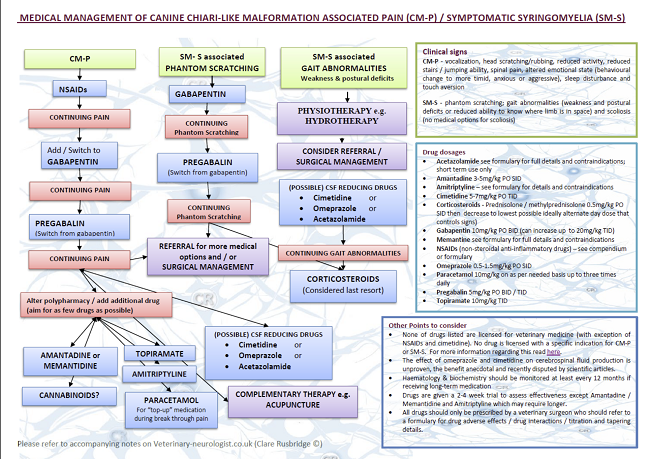
CONNECT WITH US